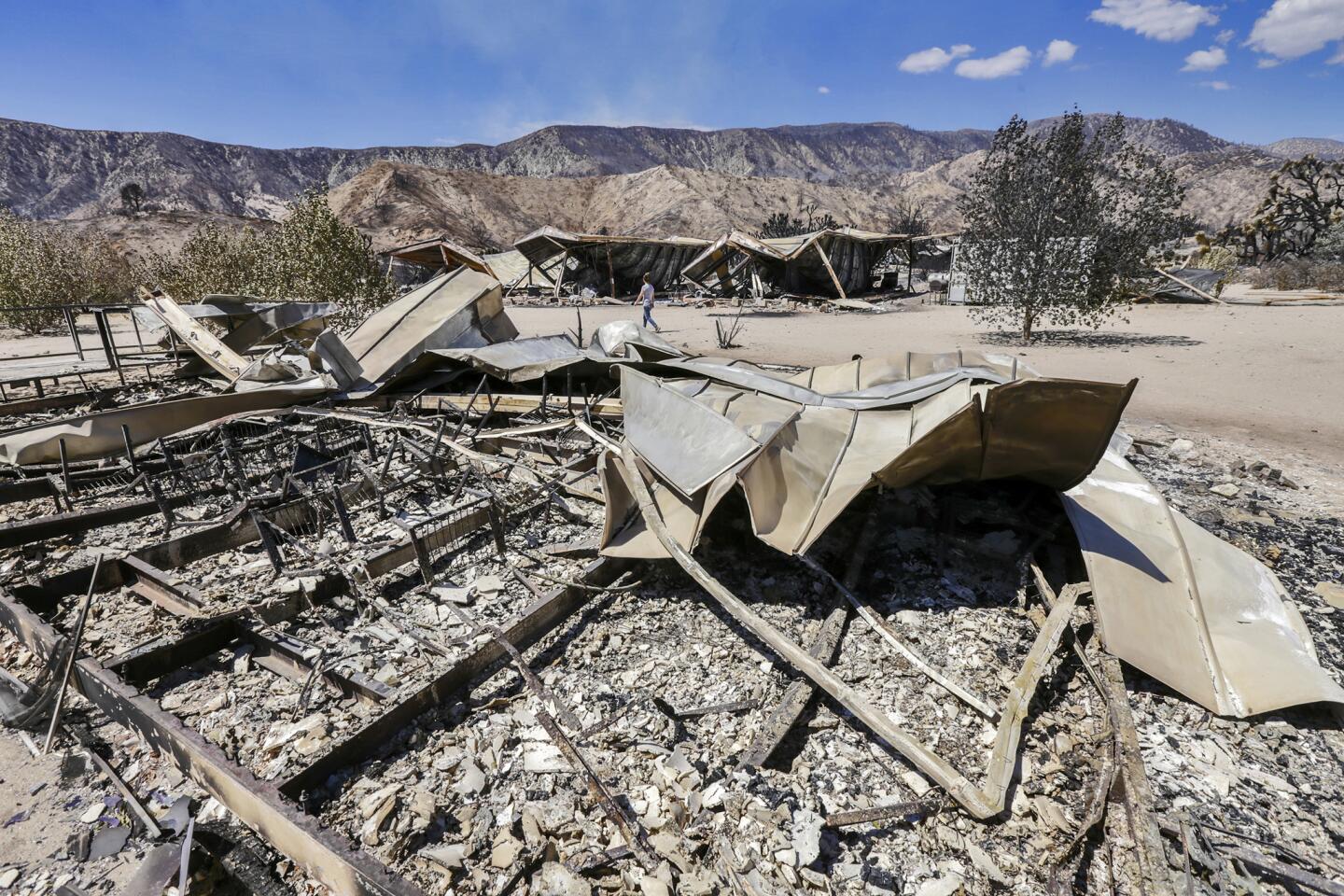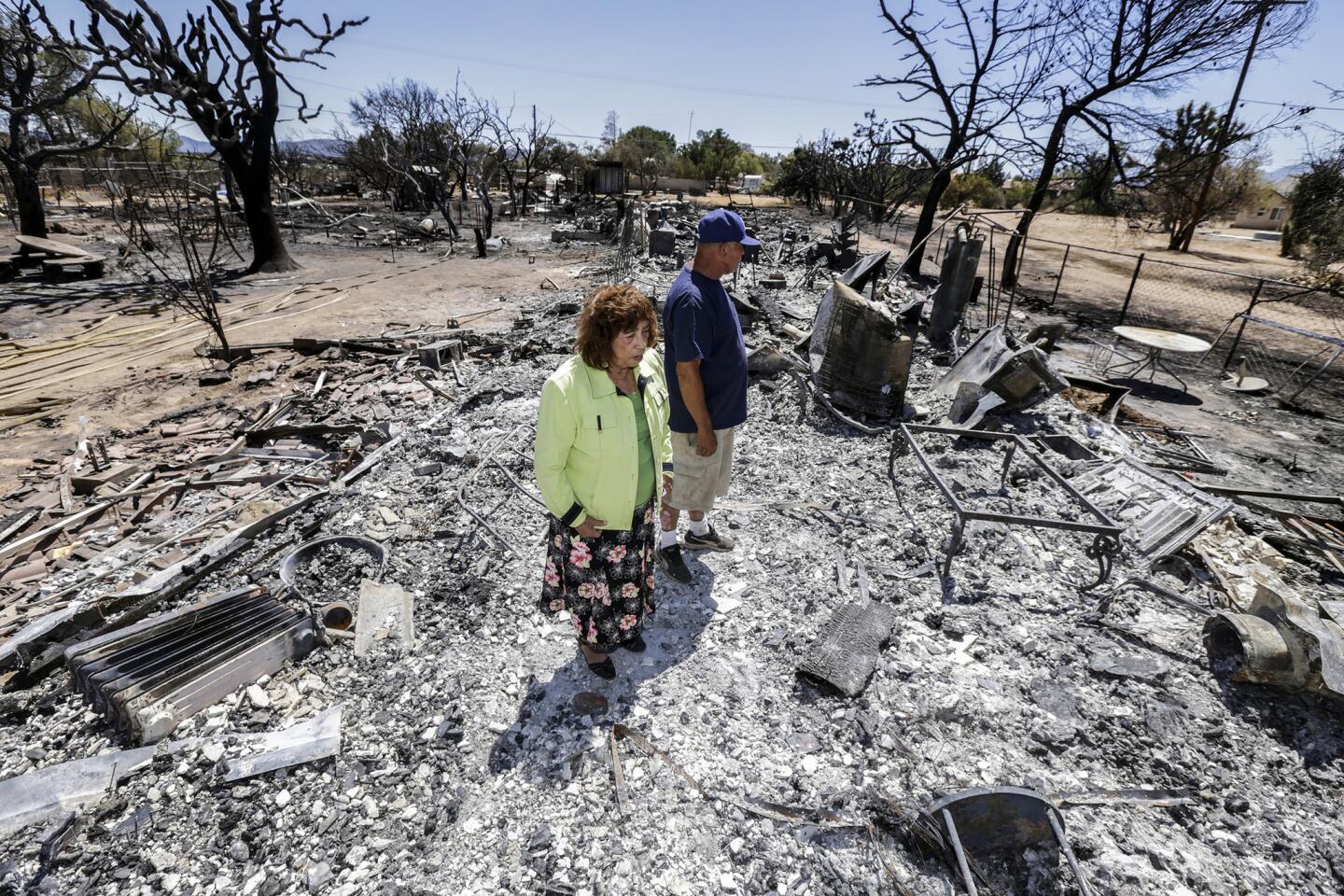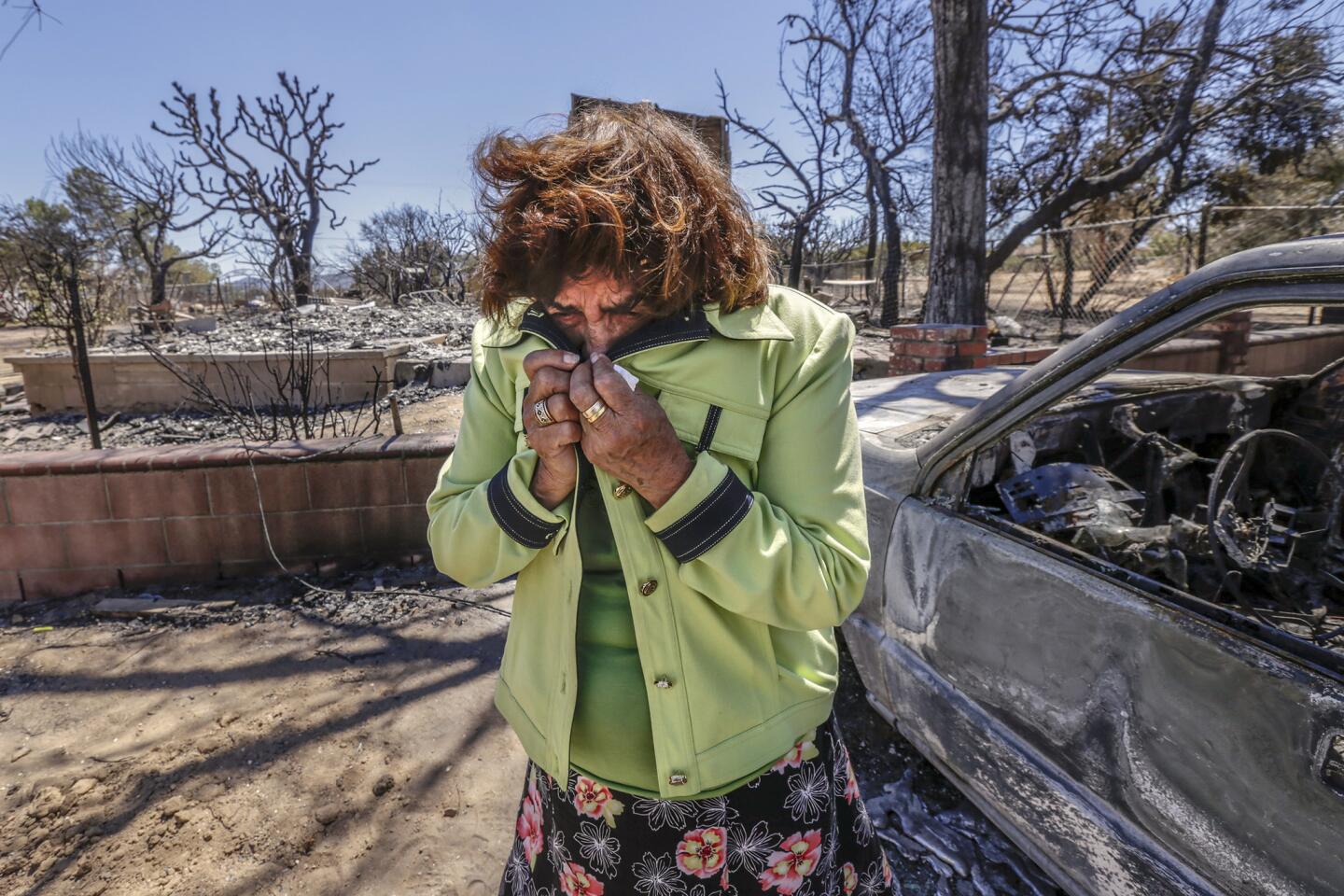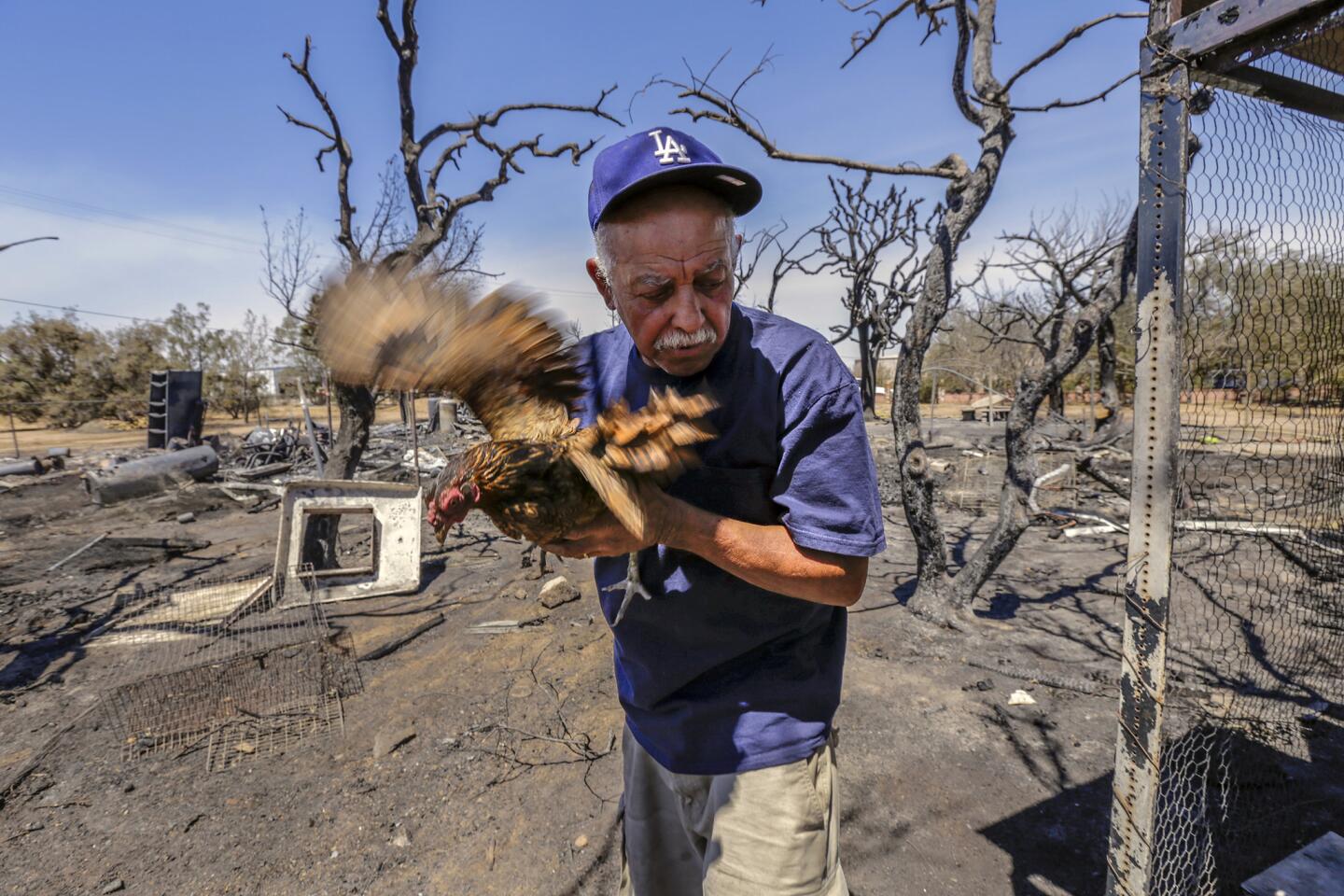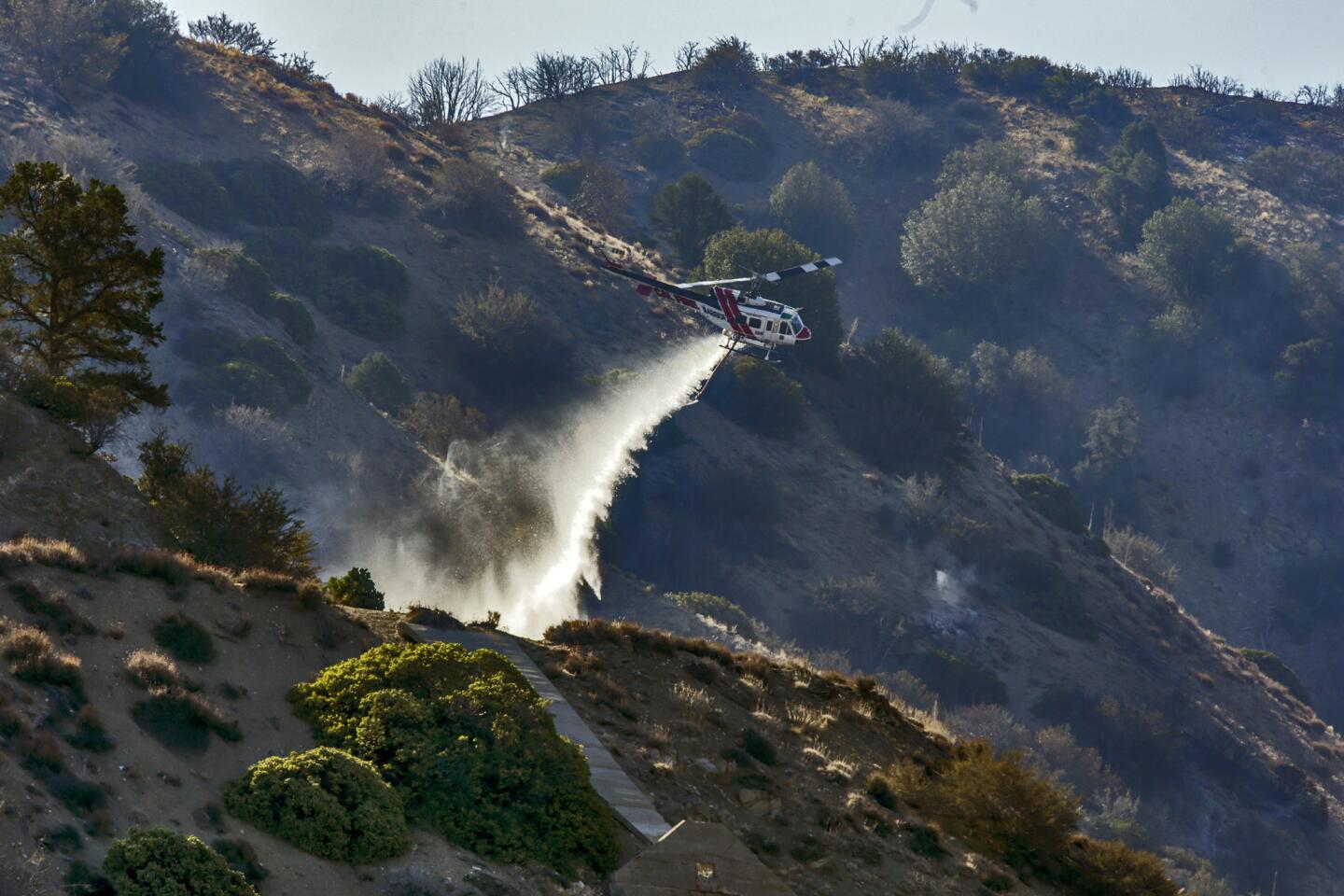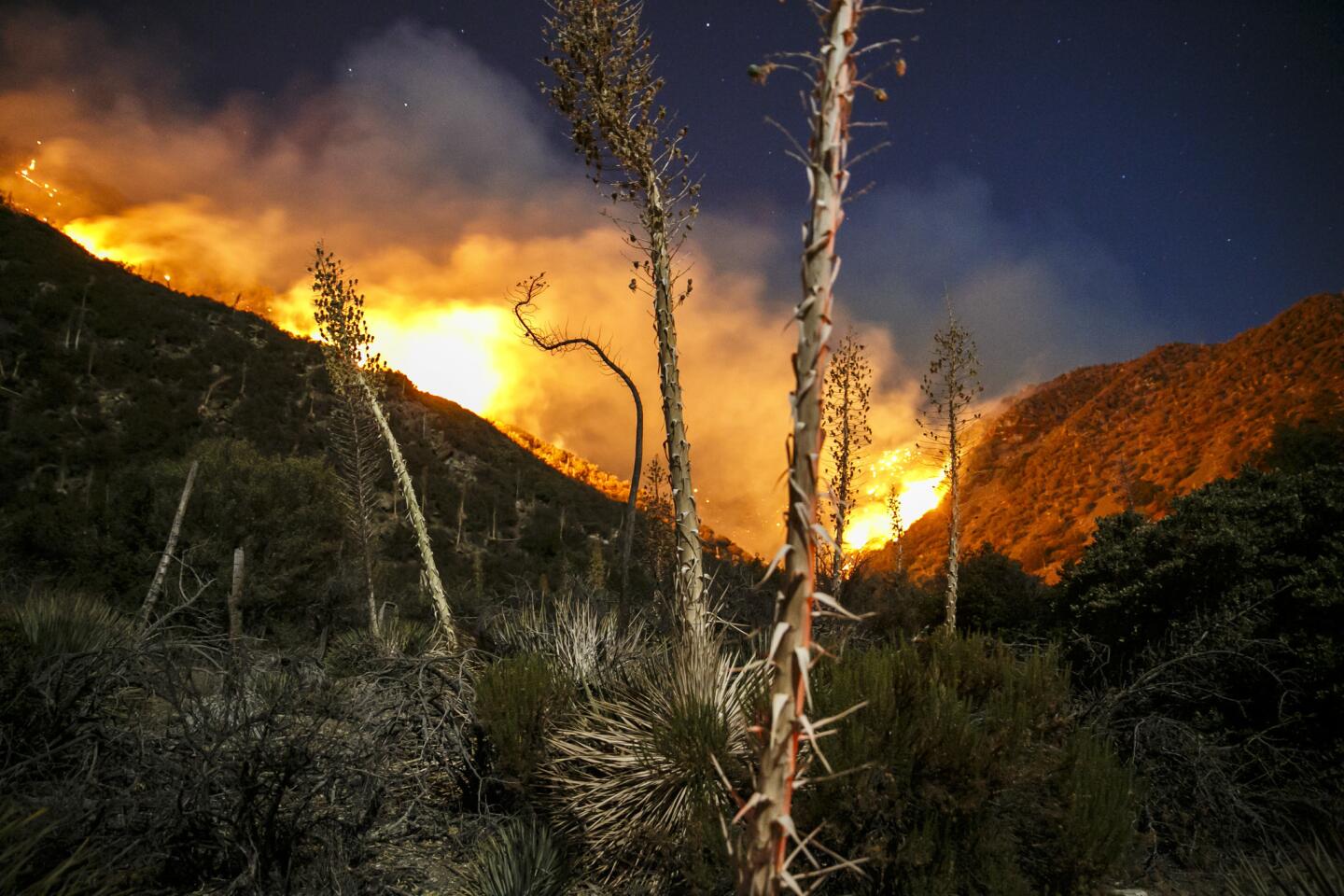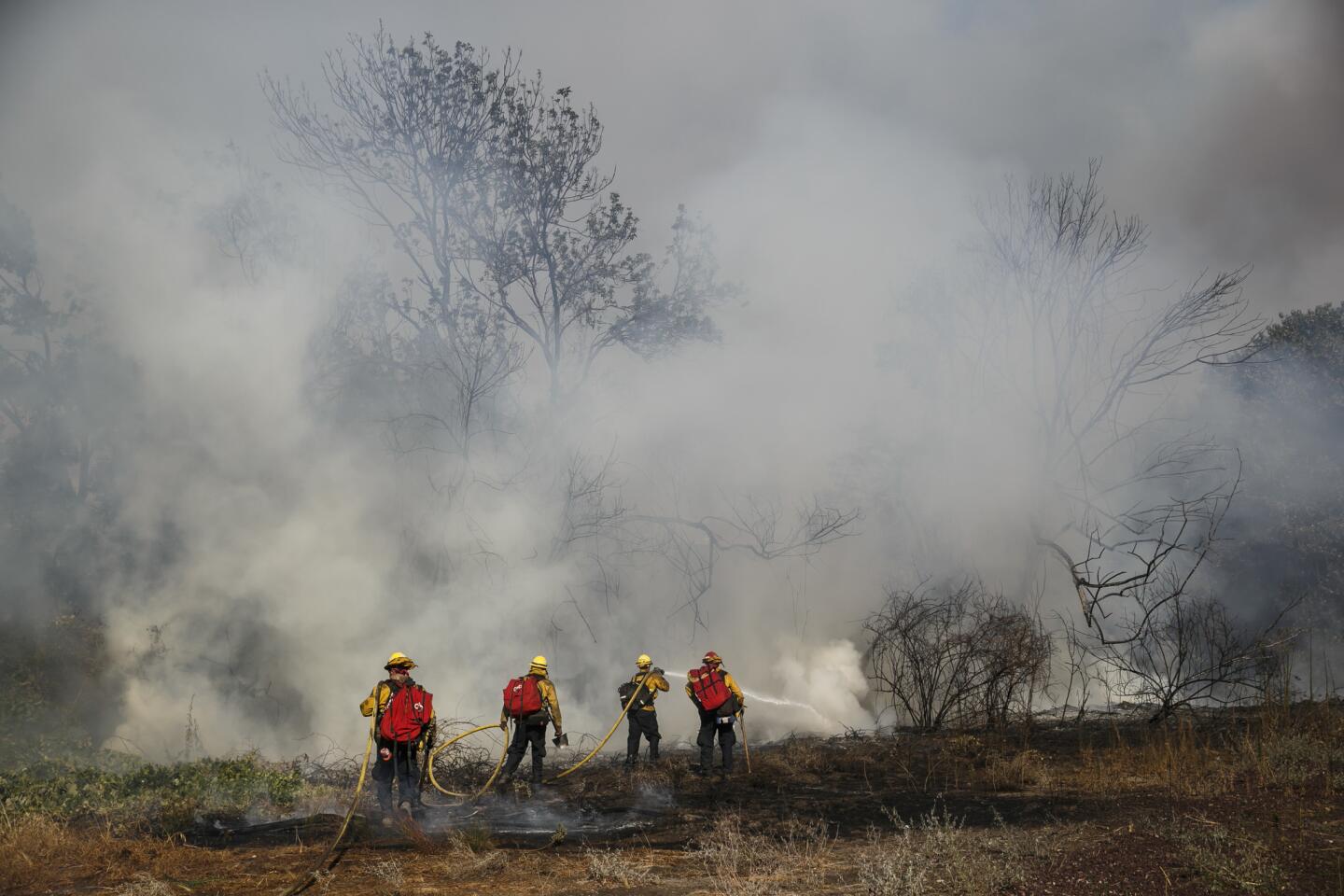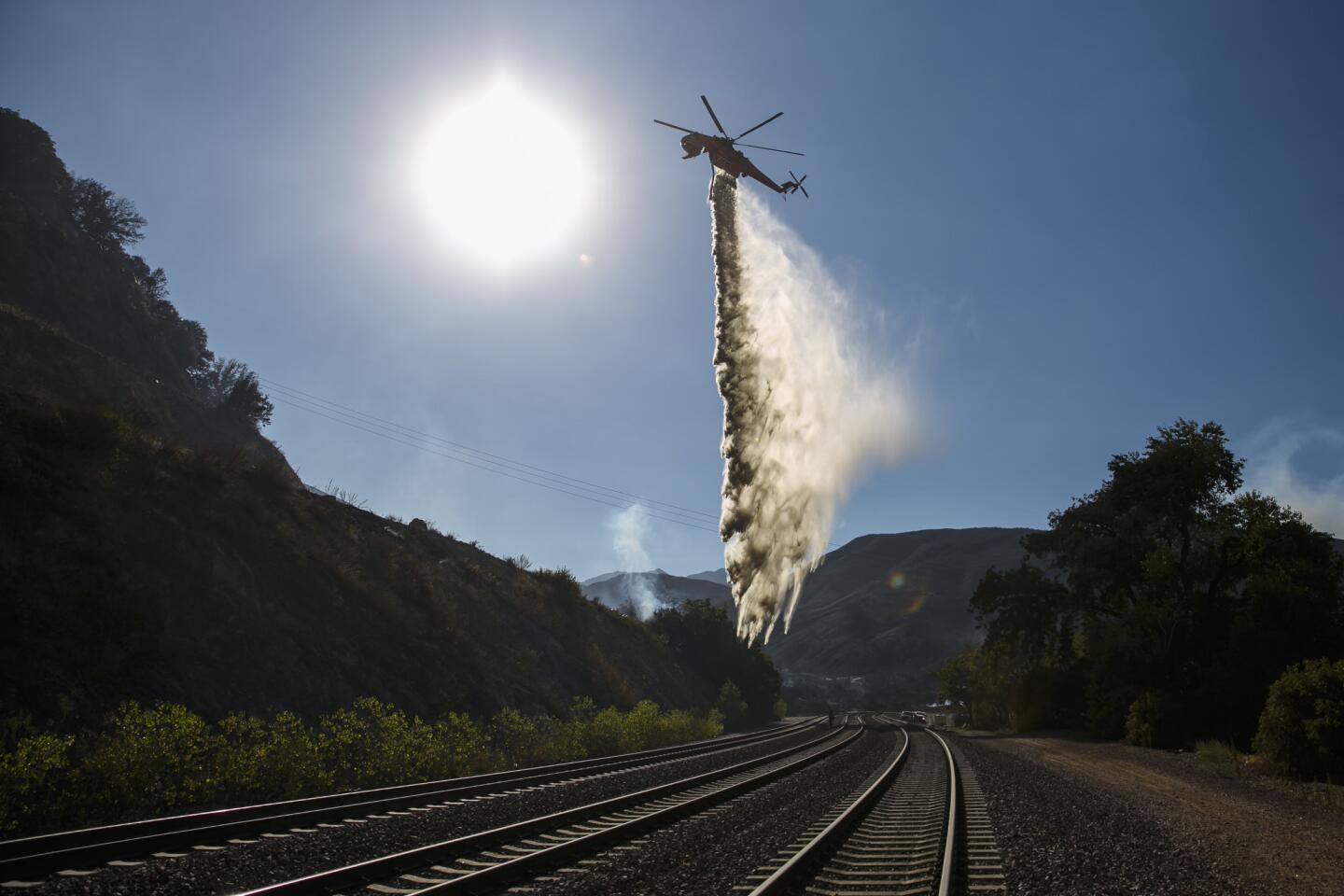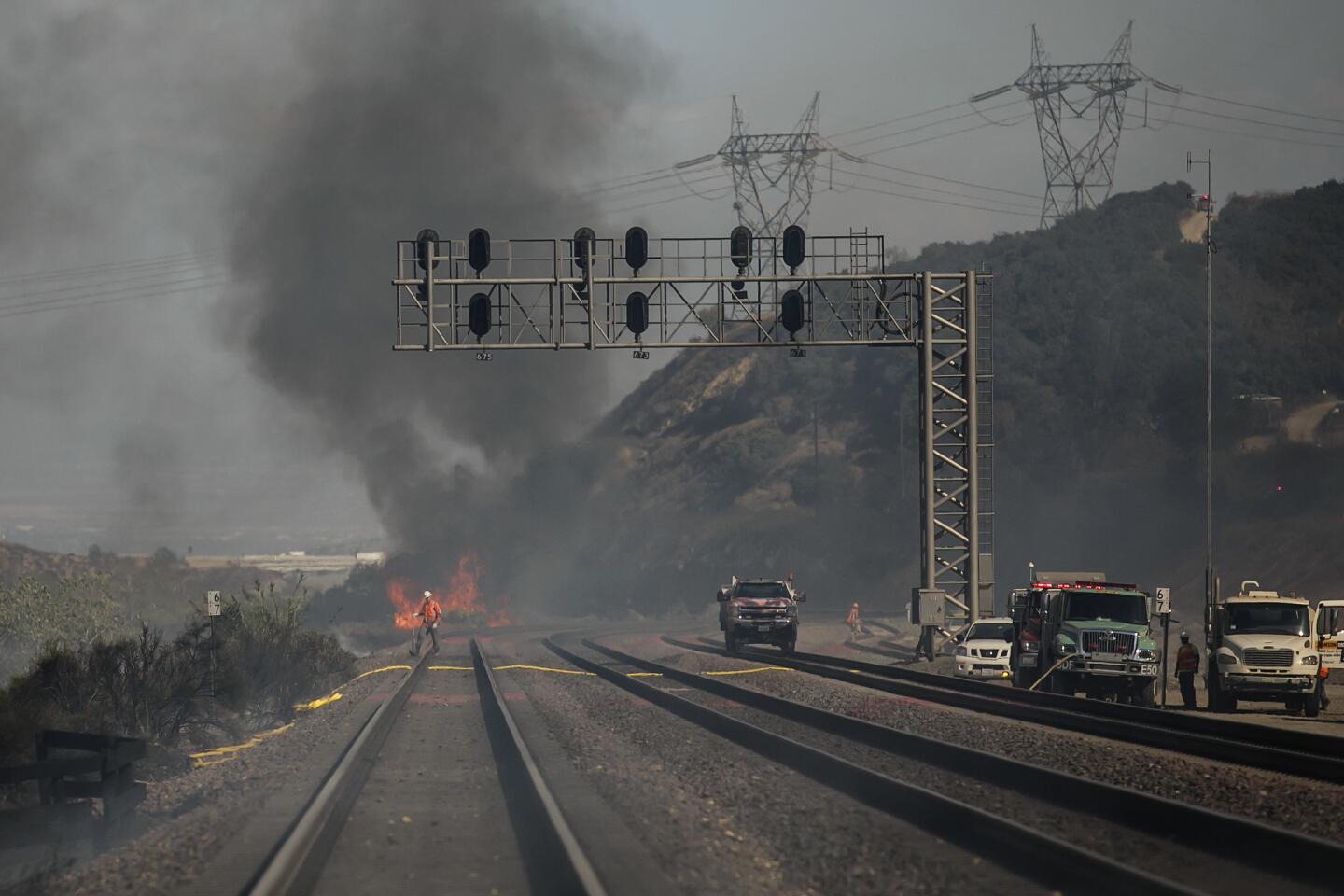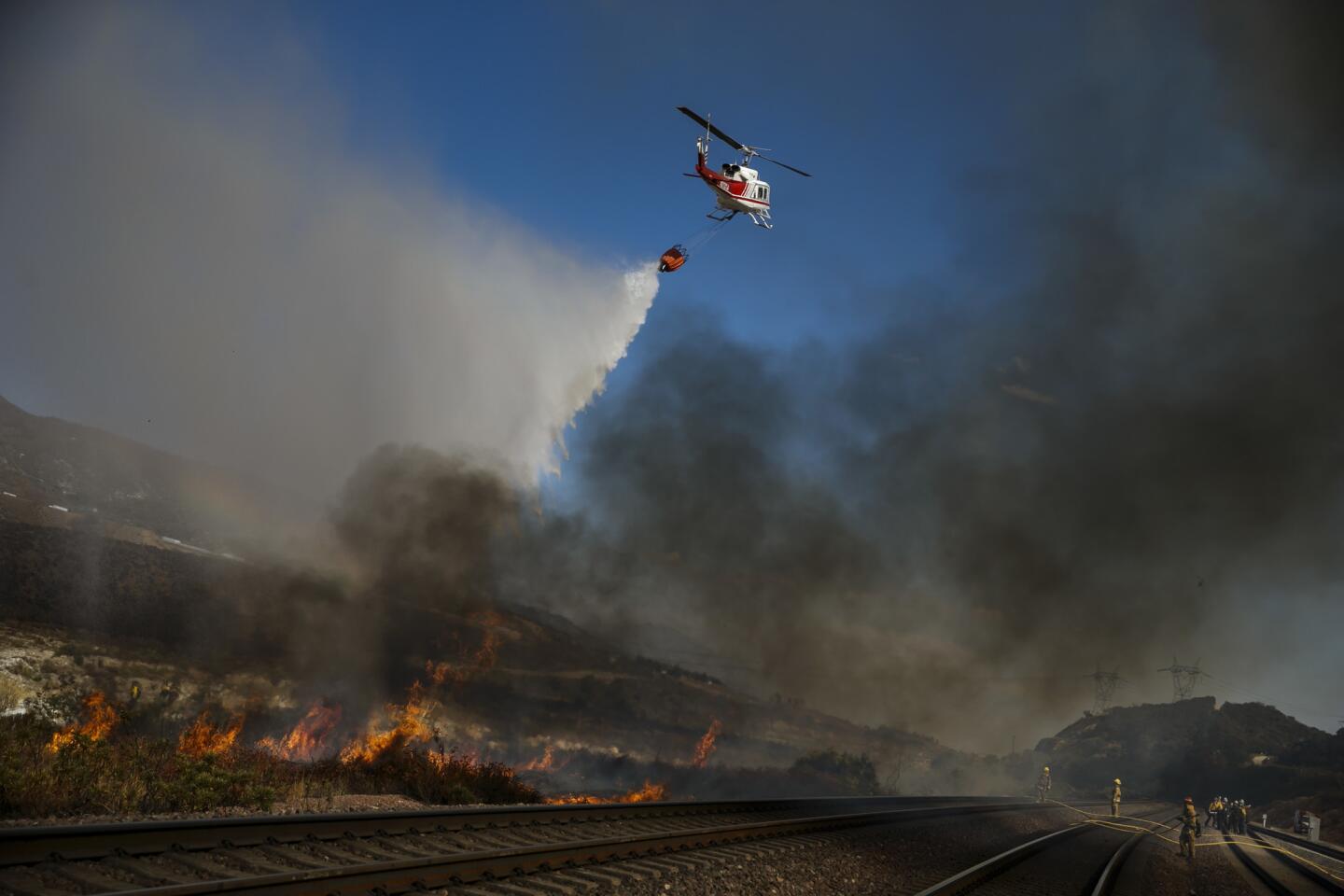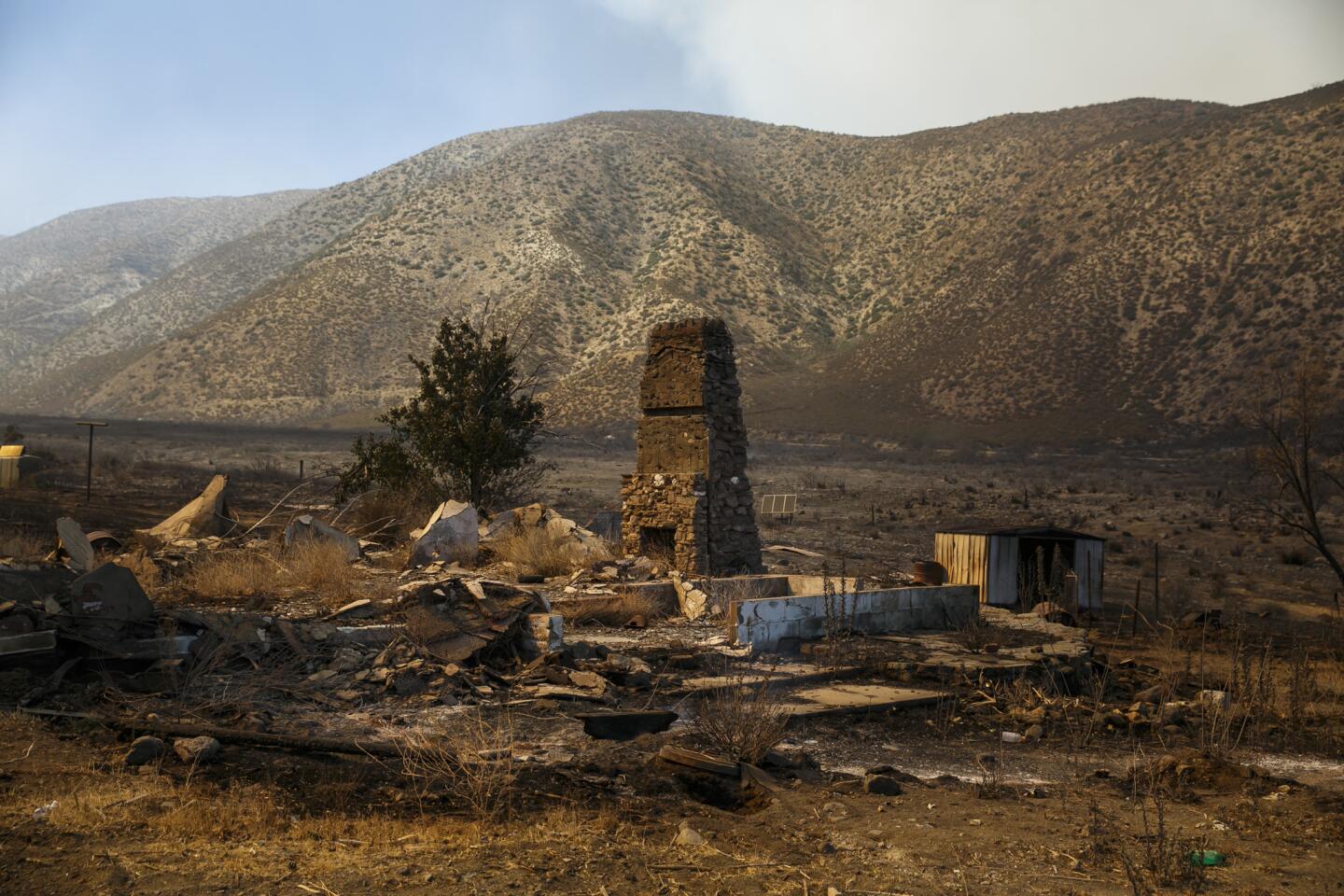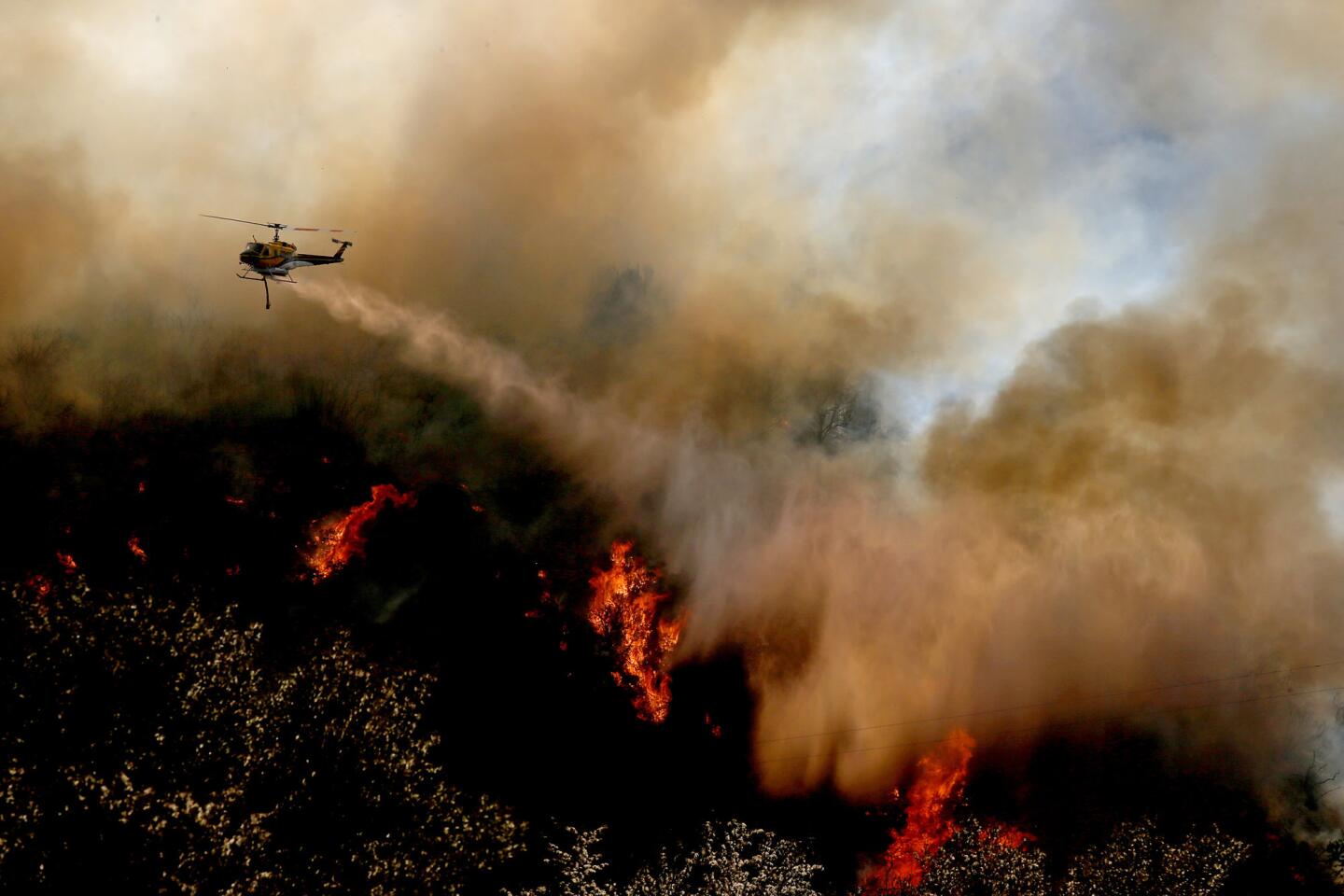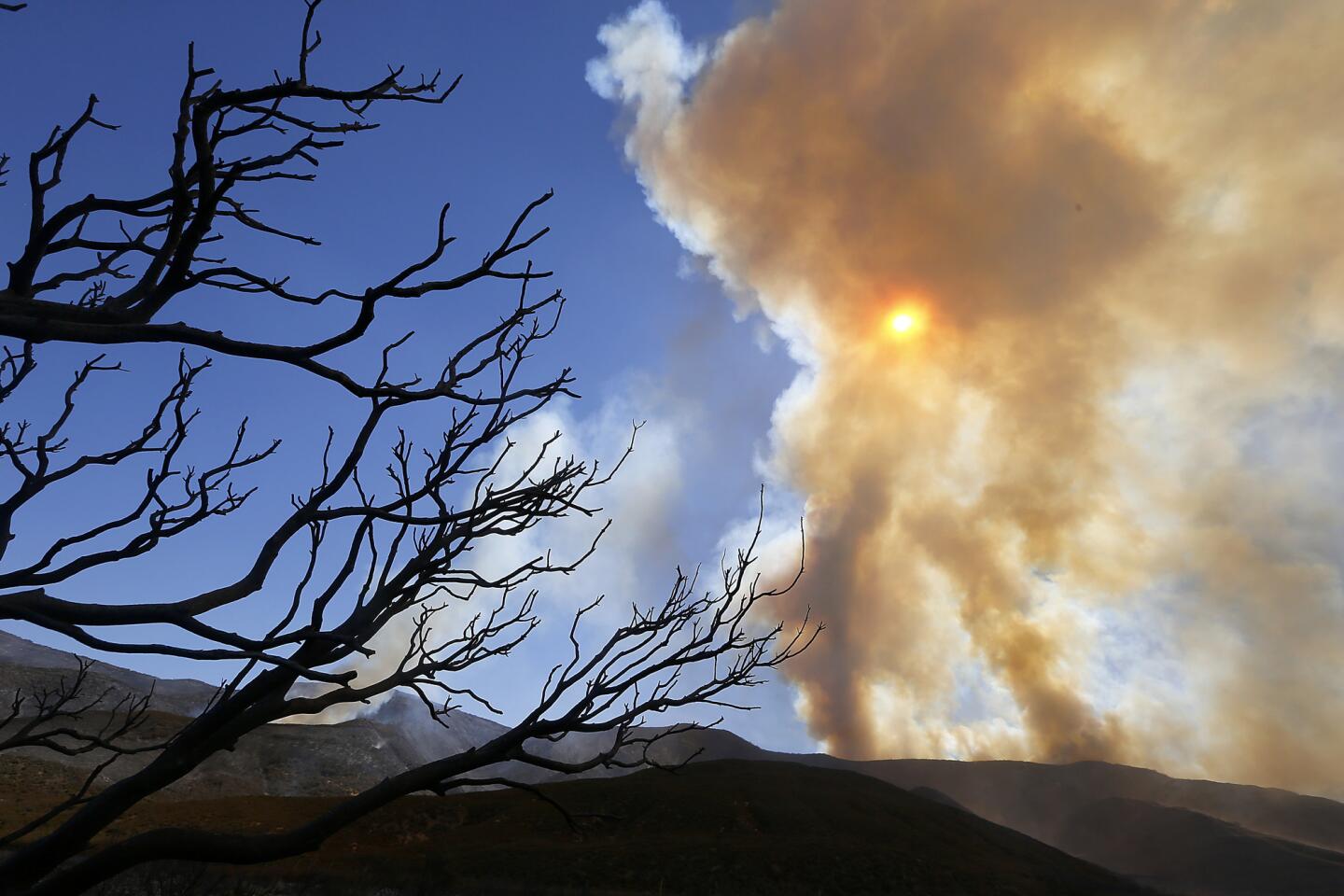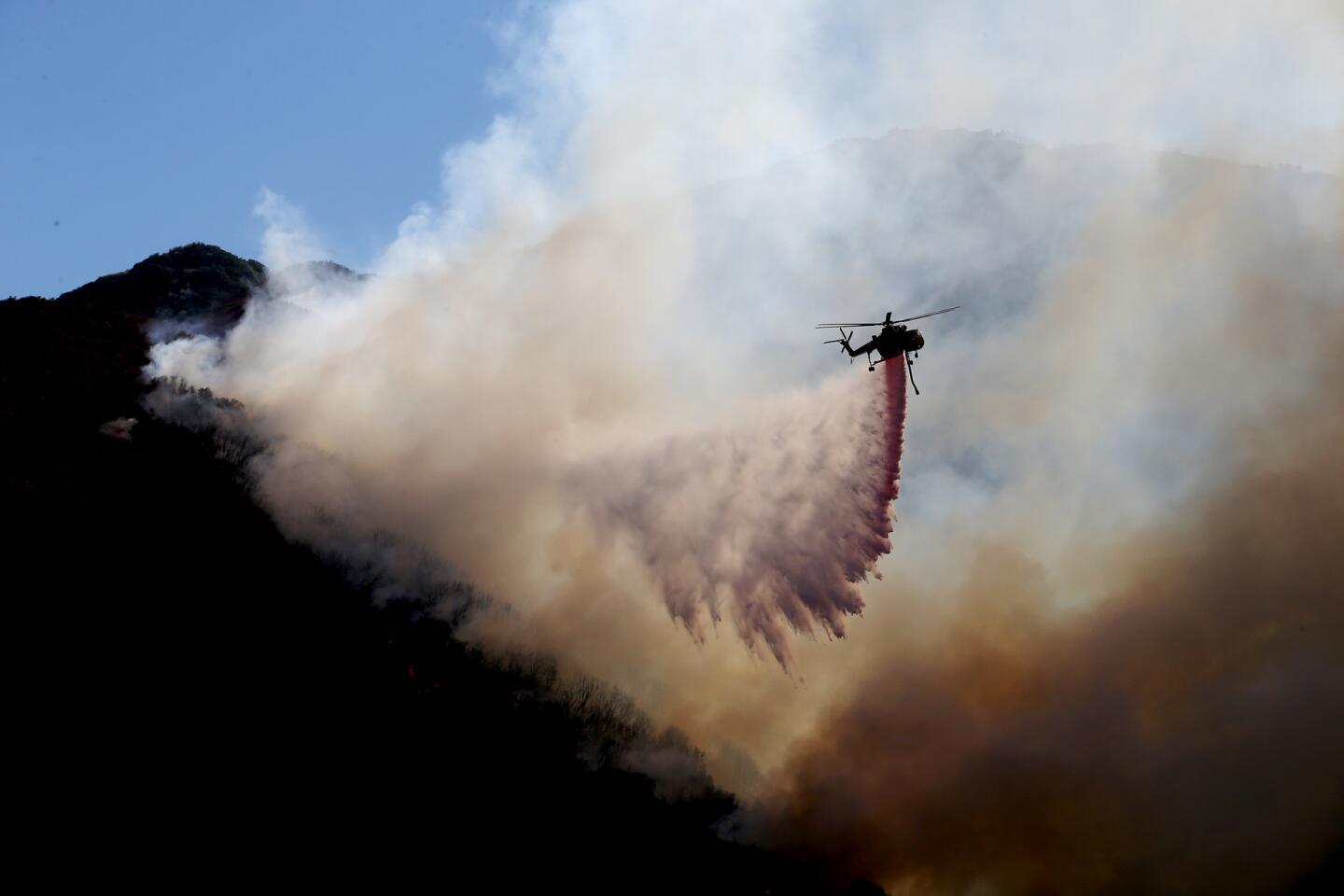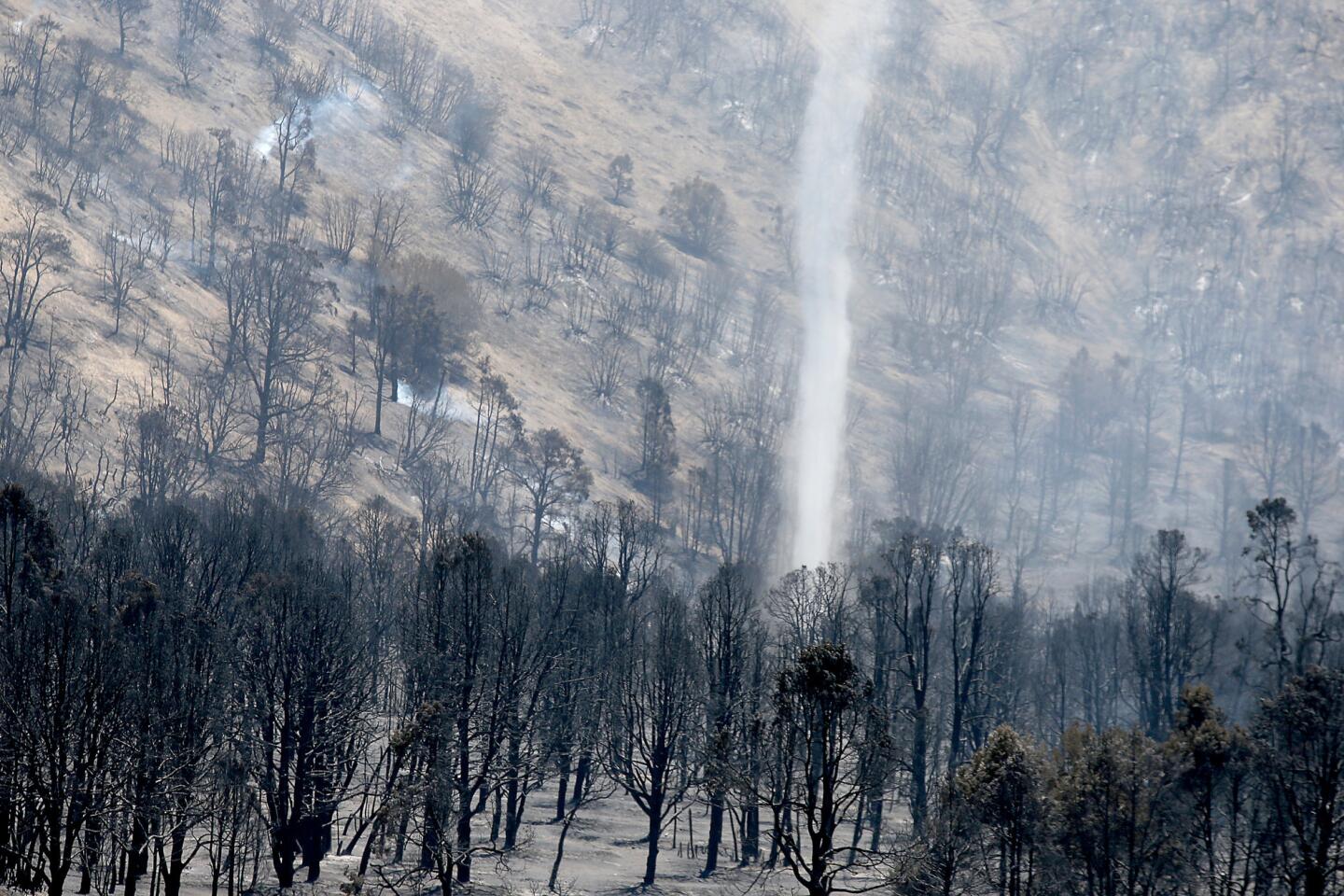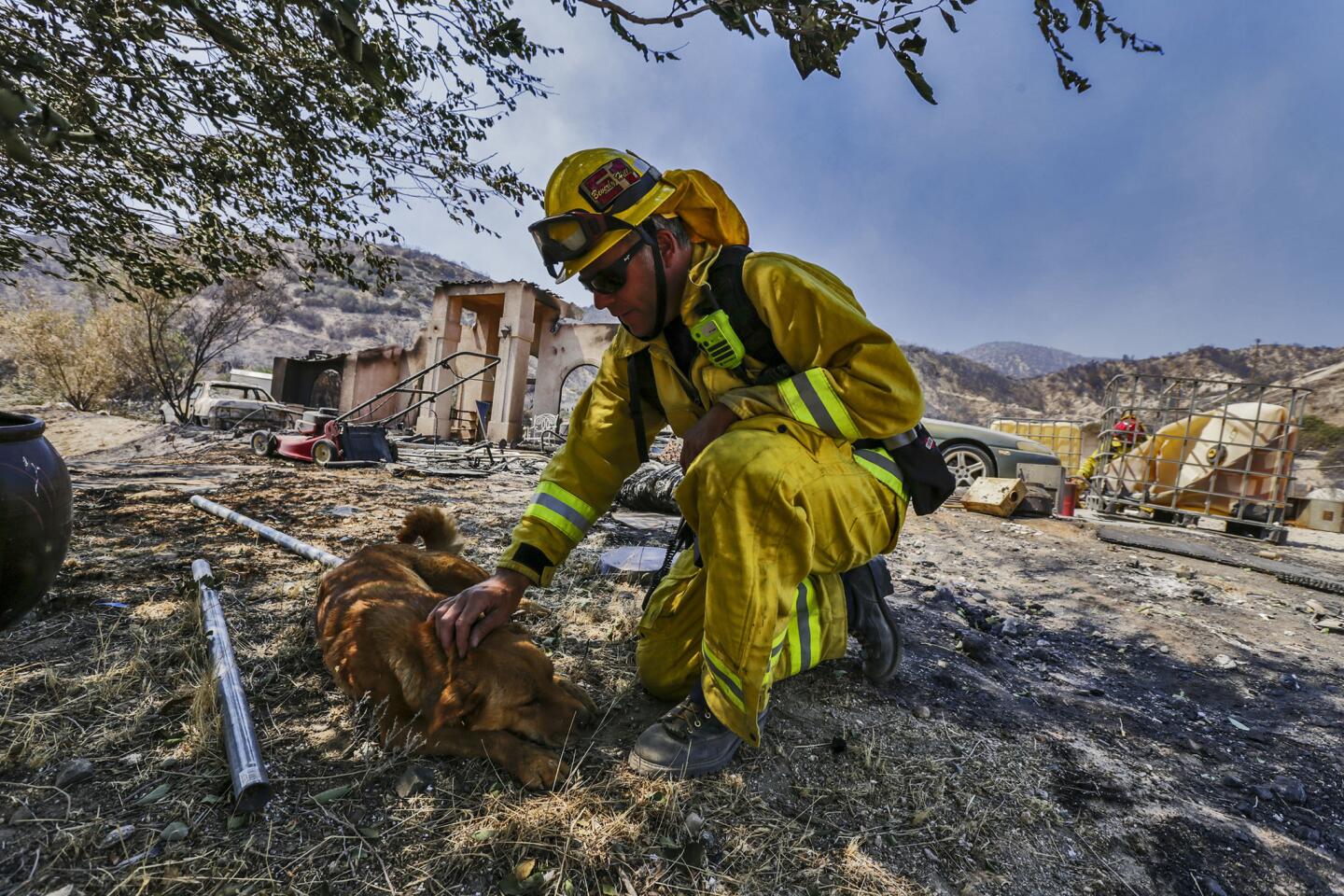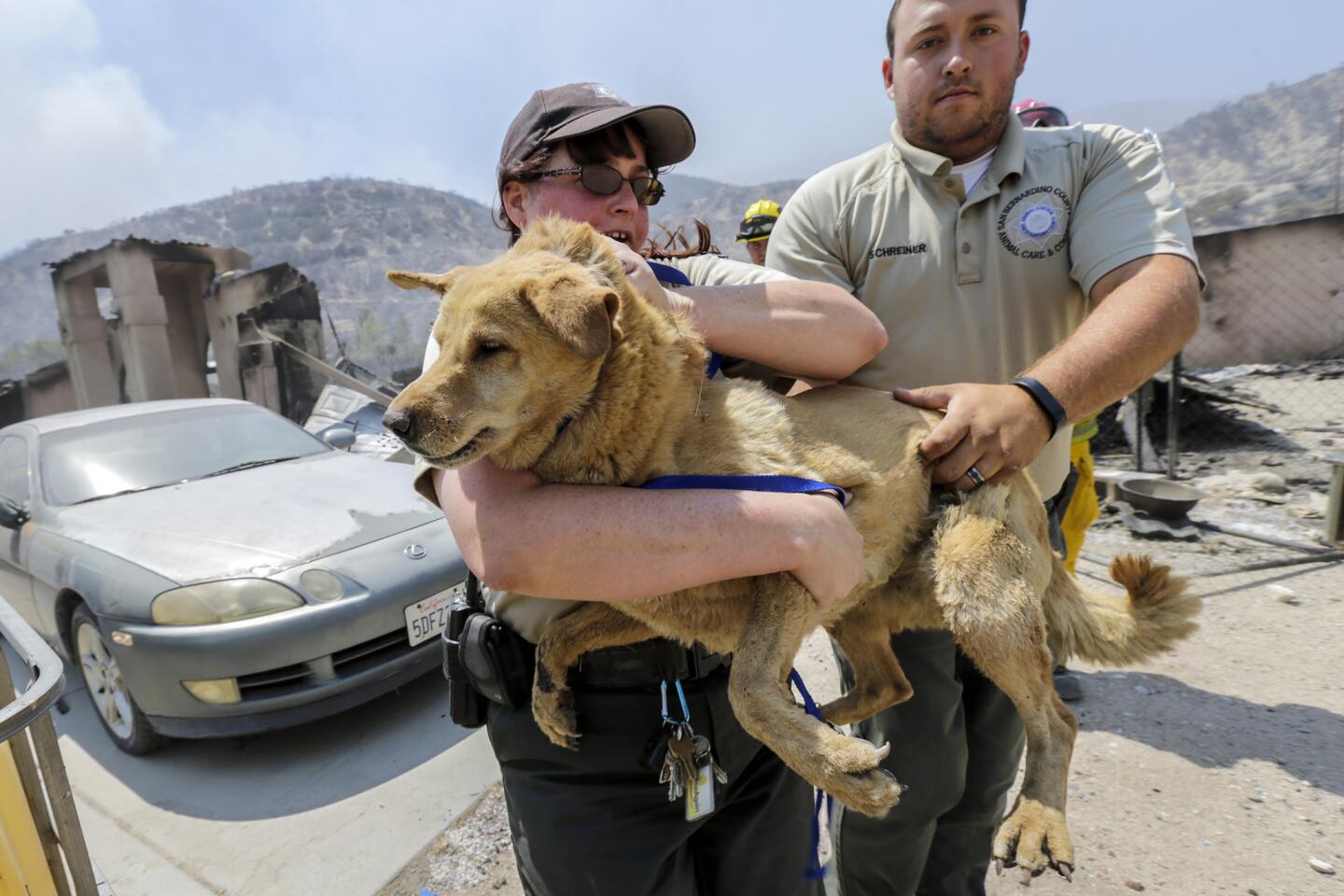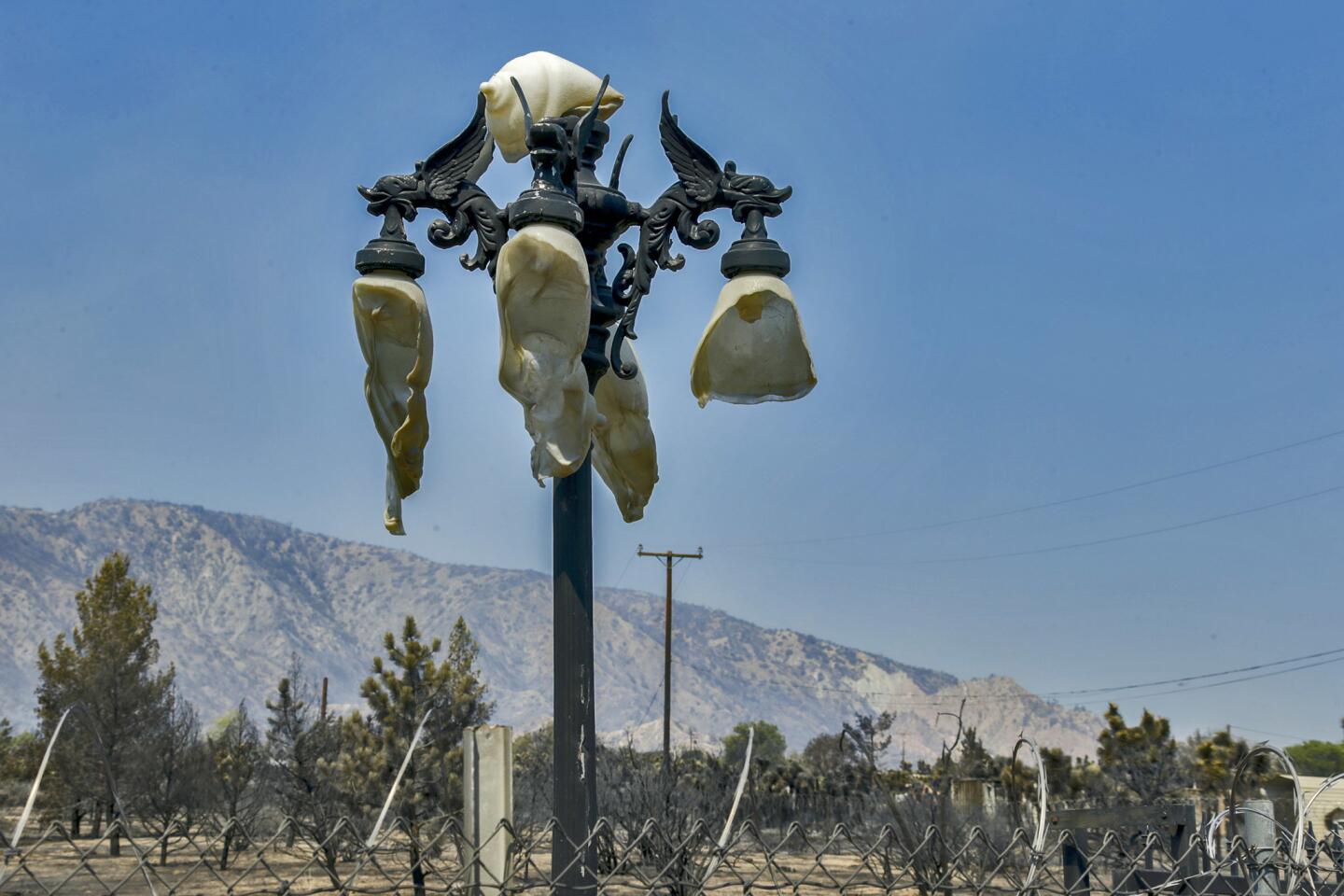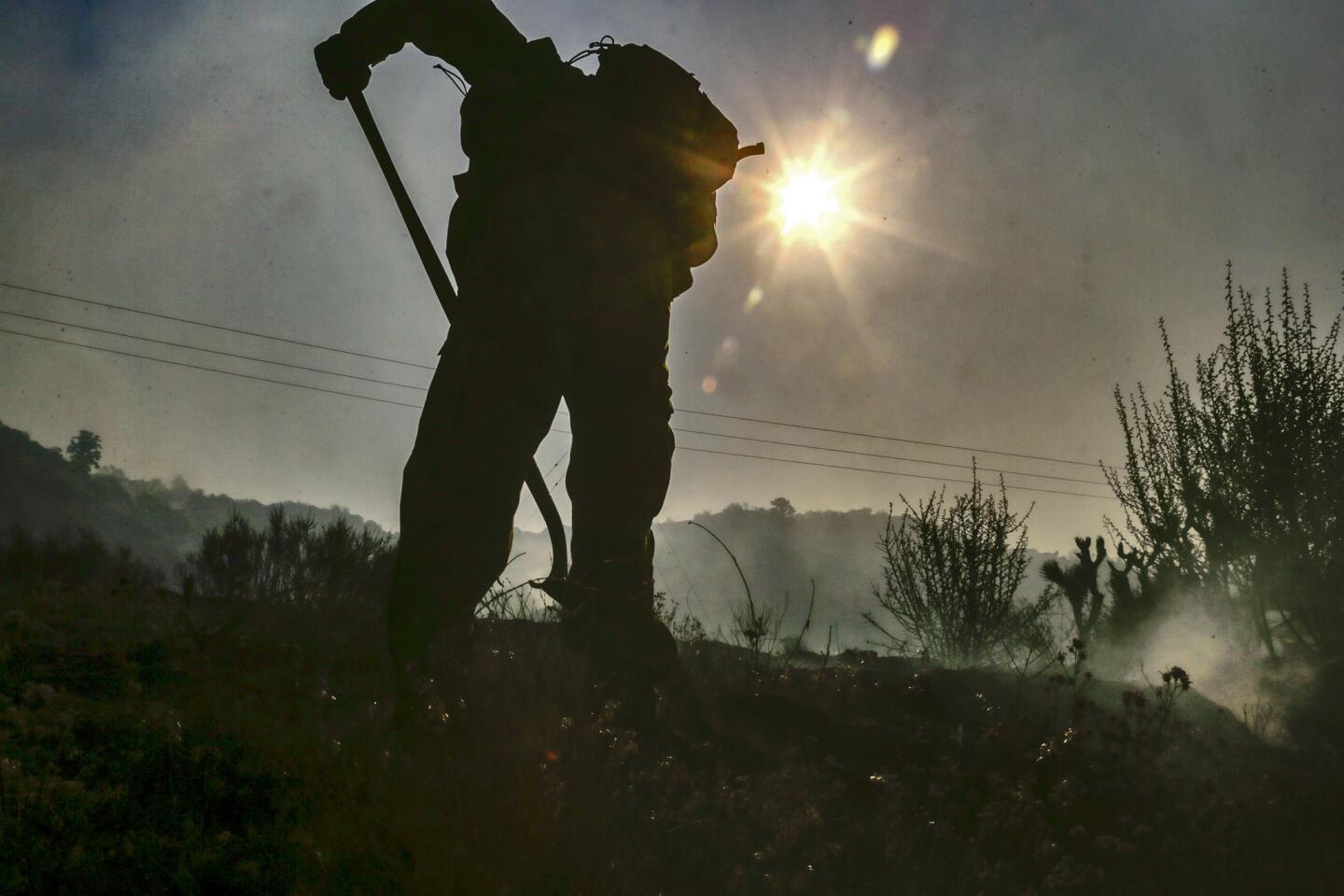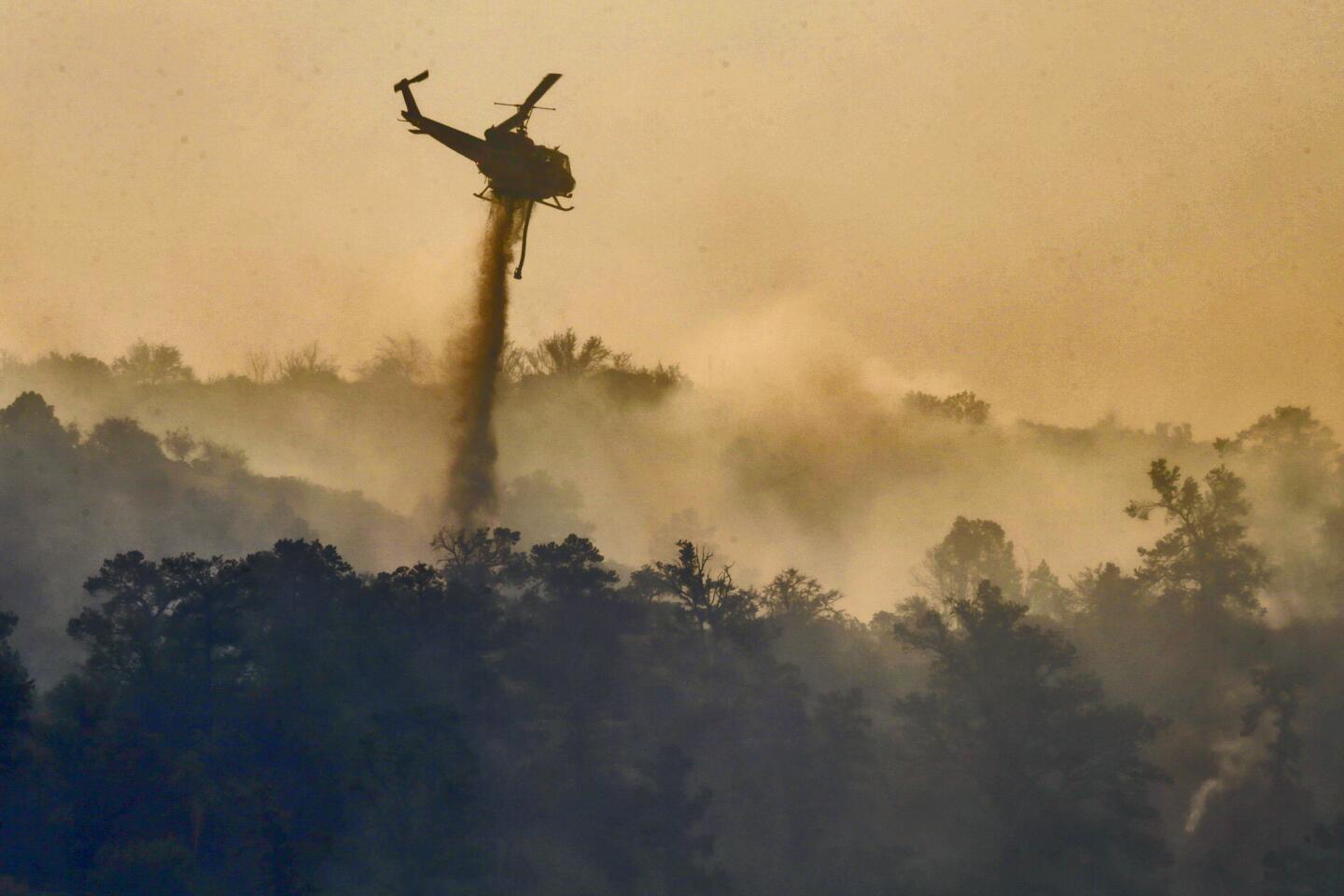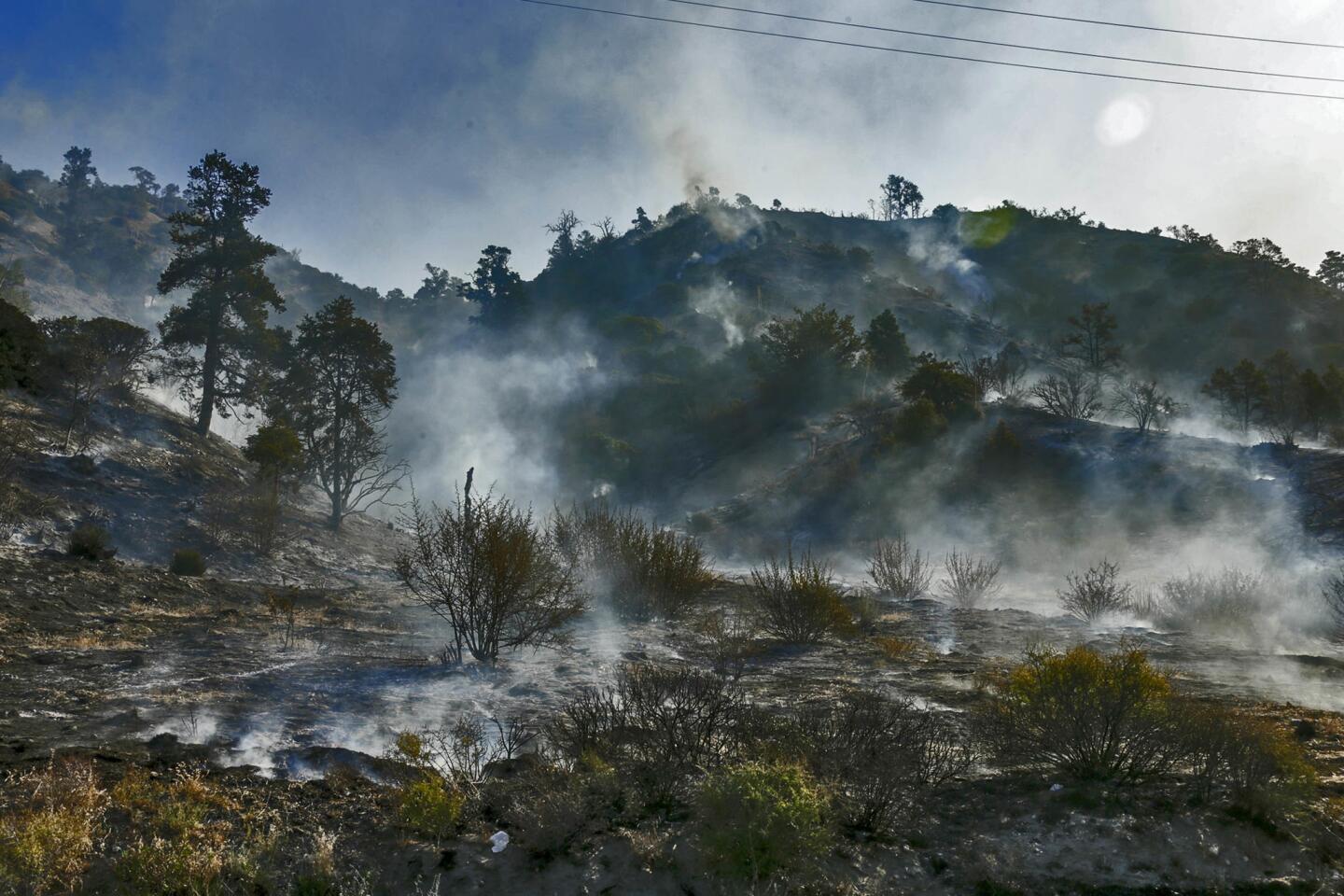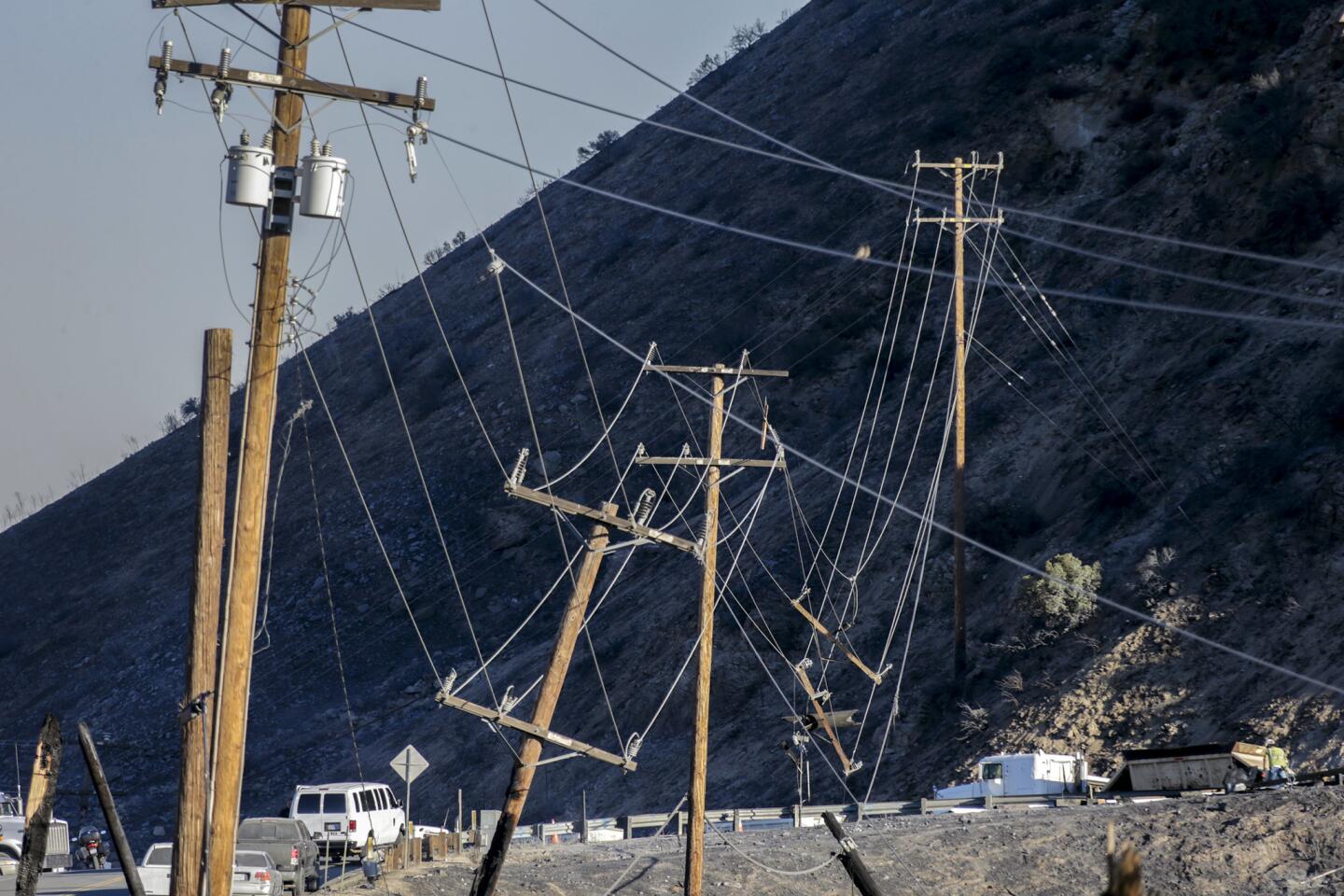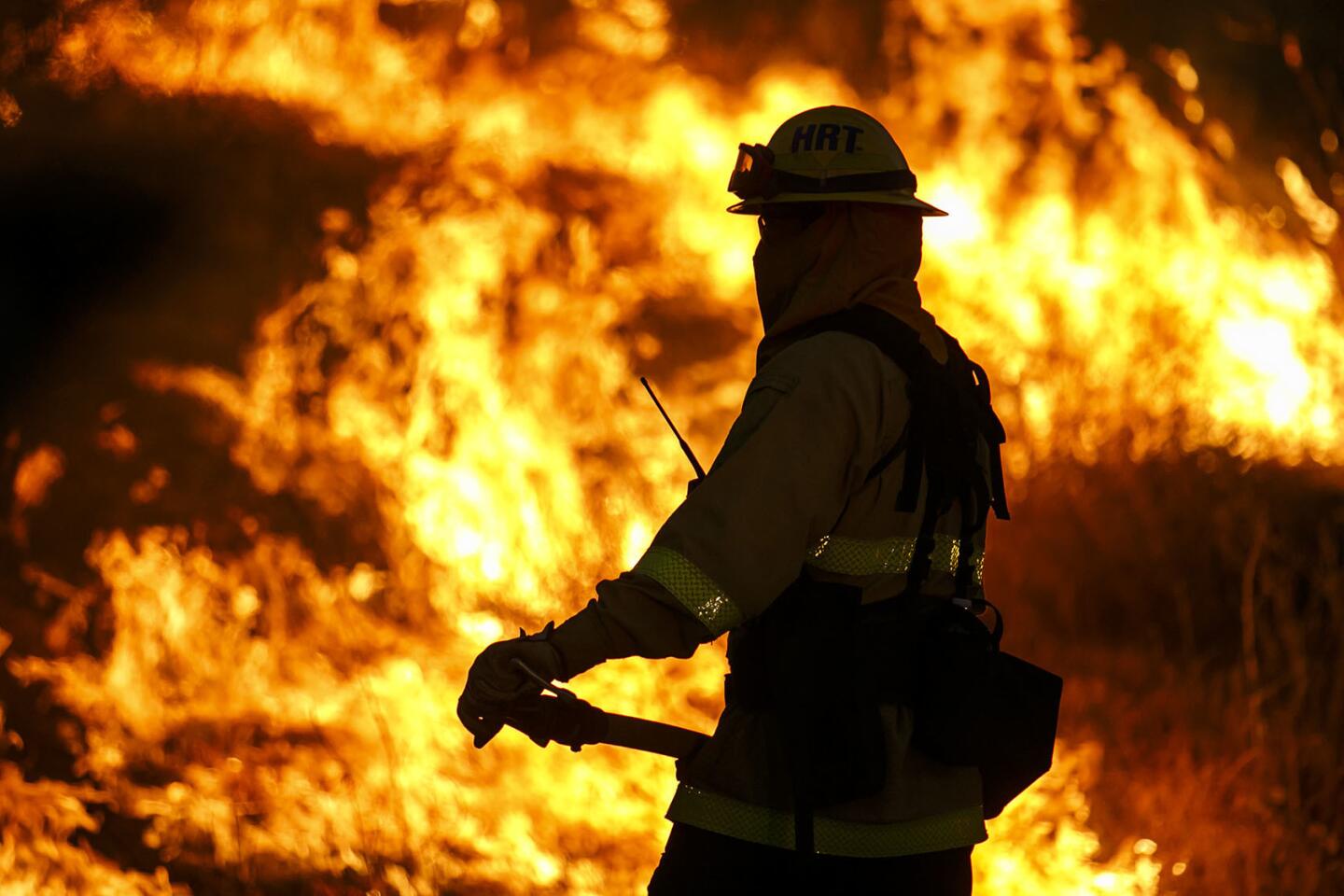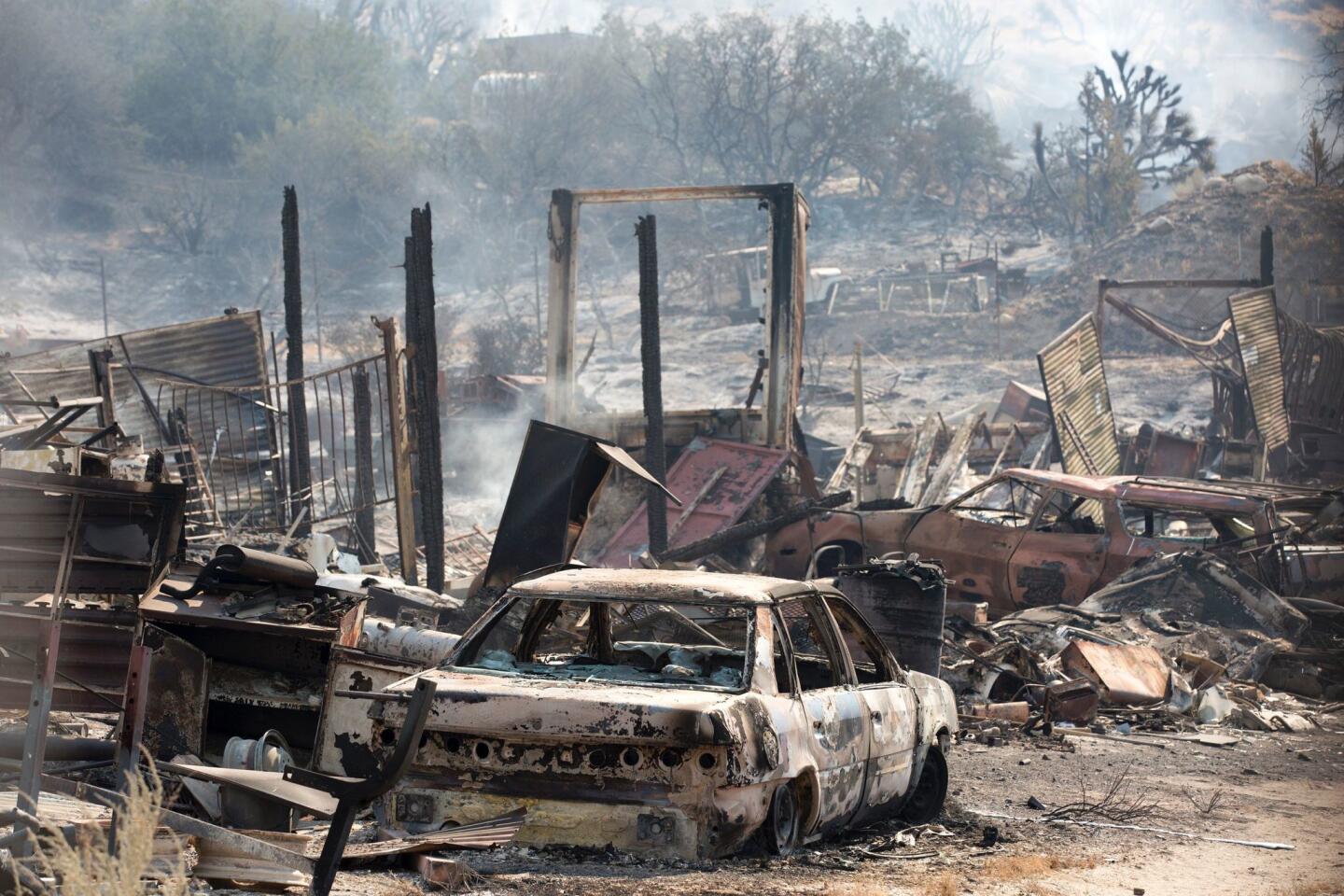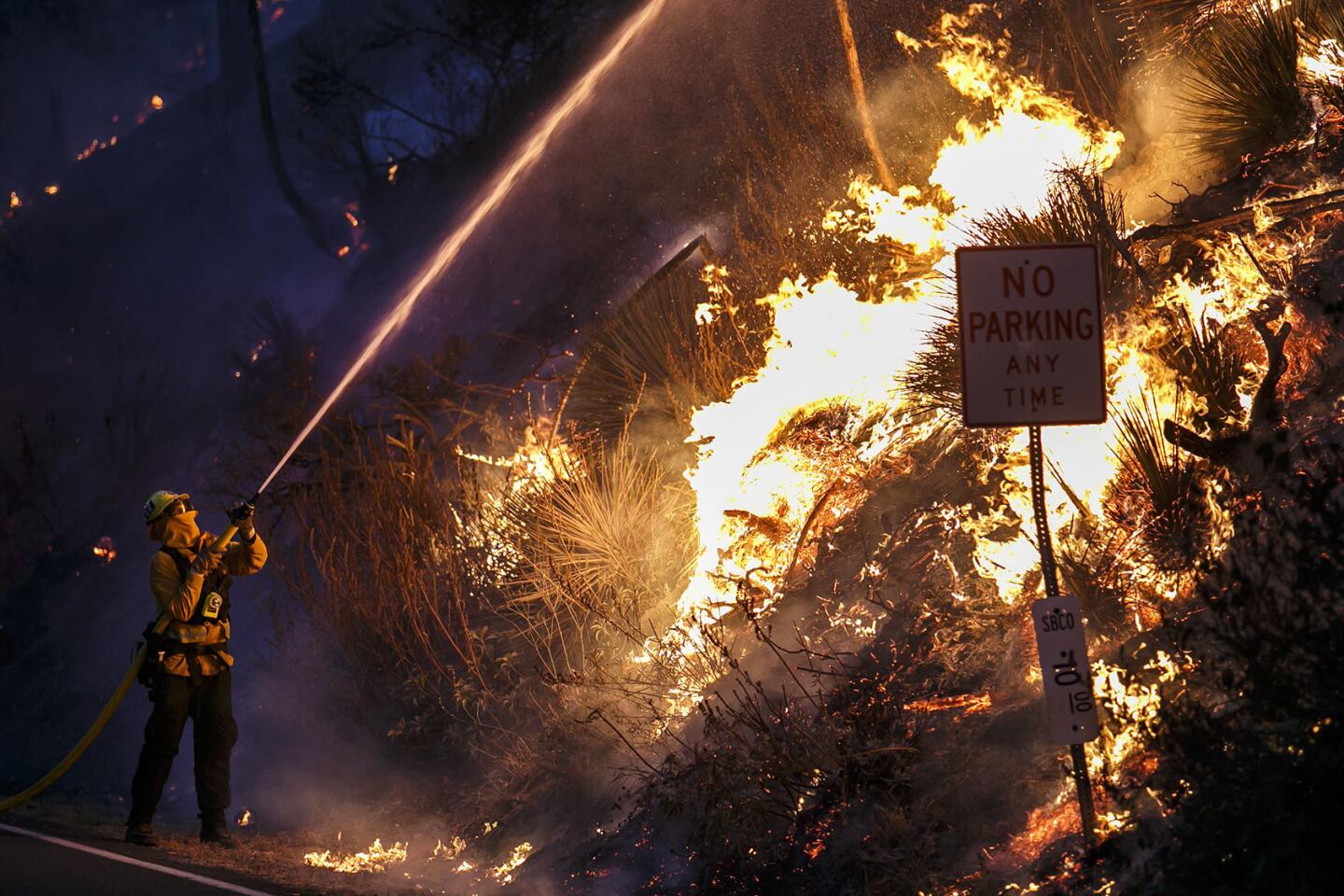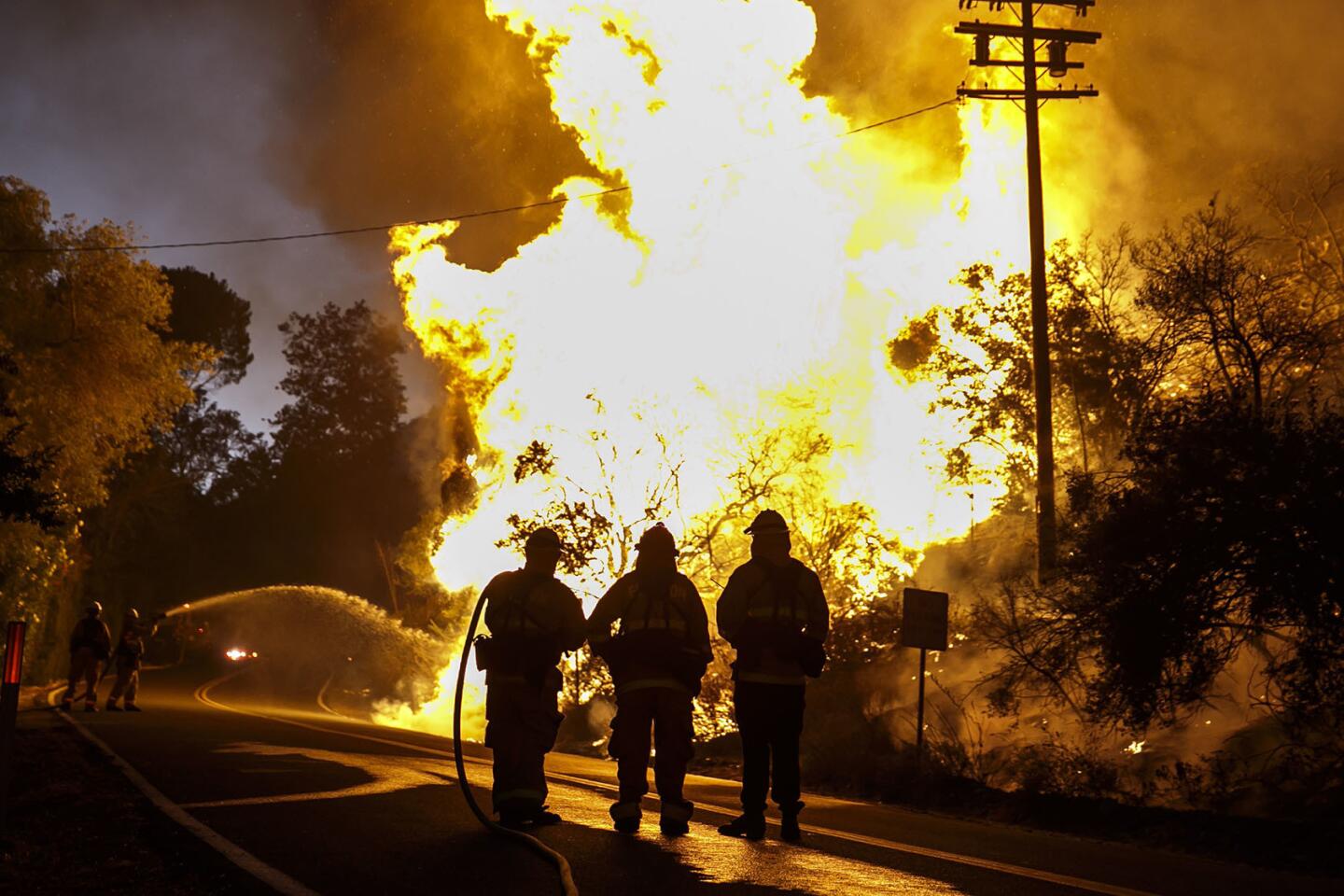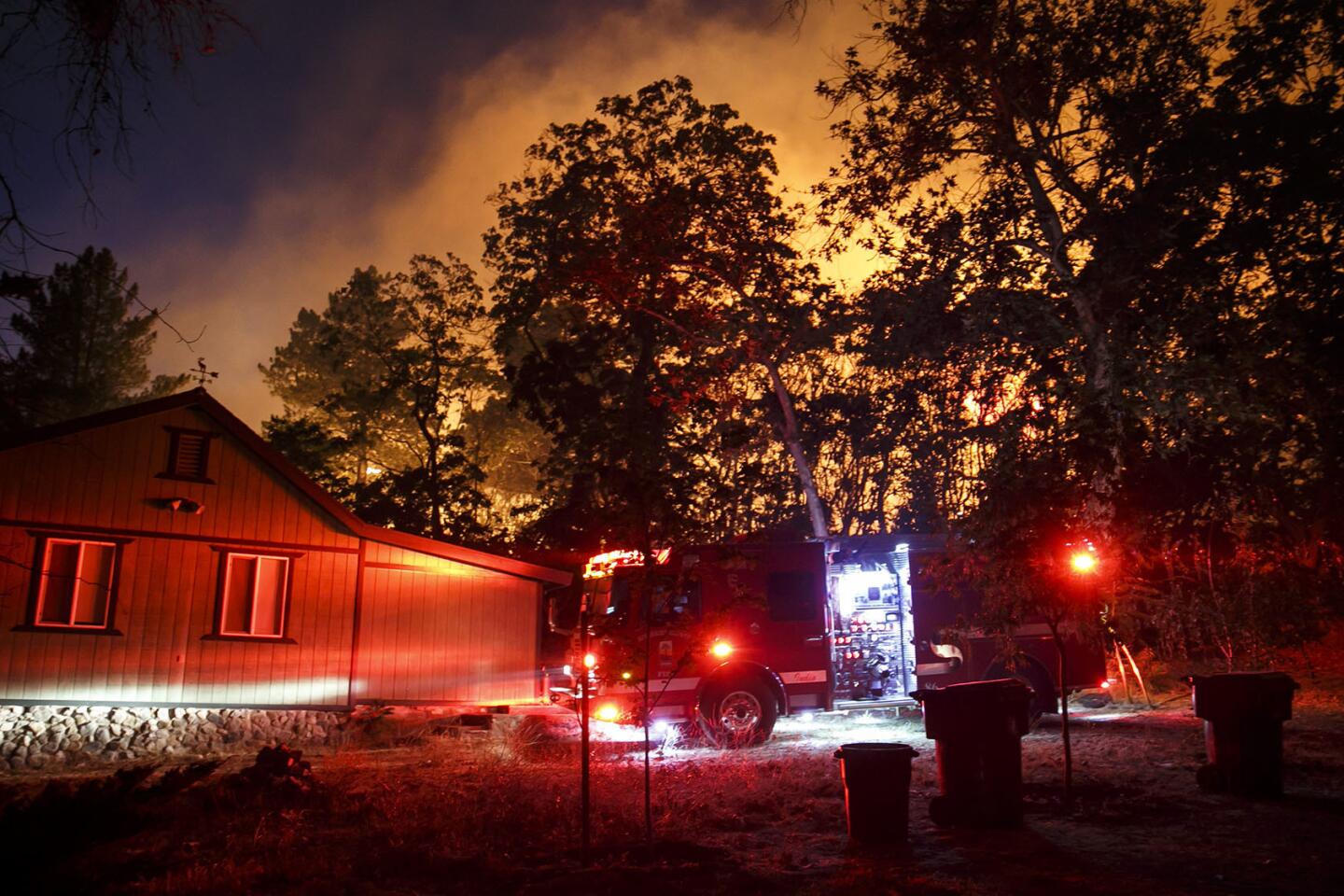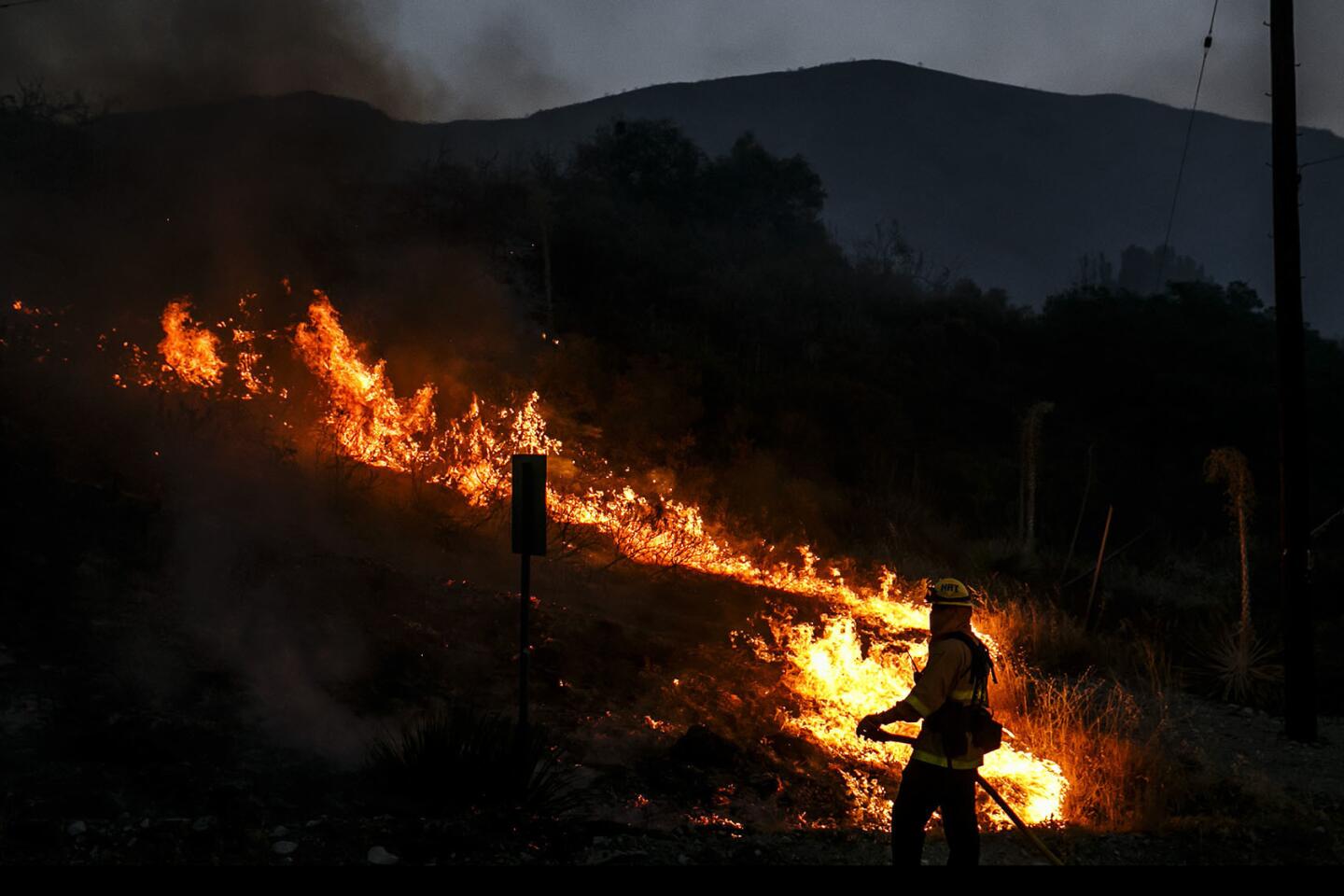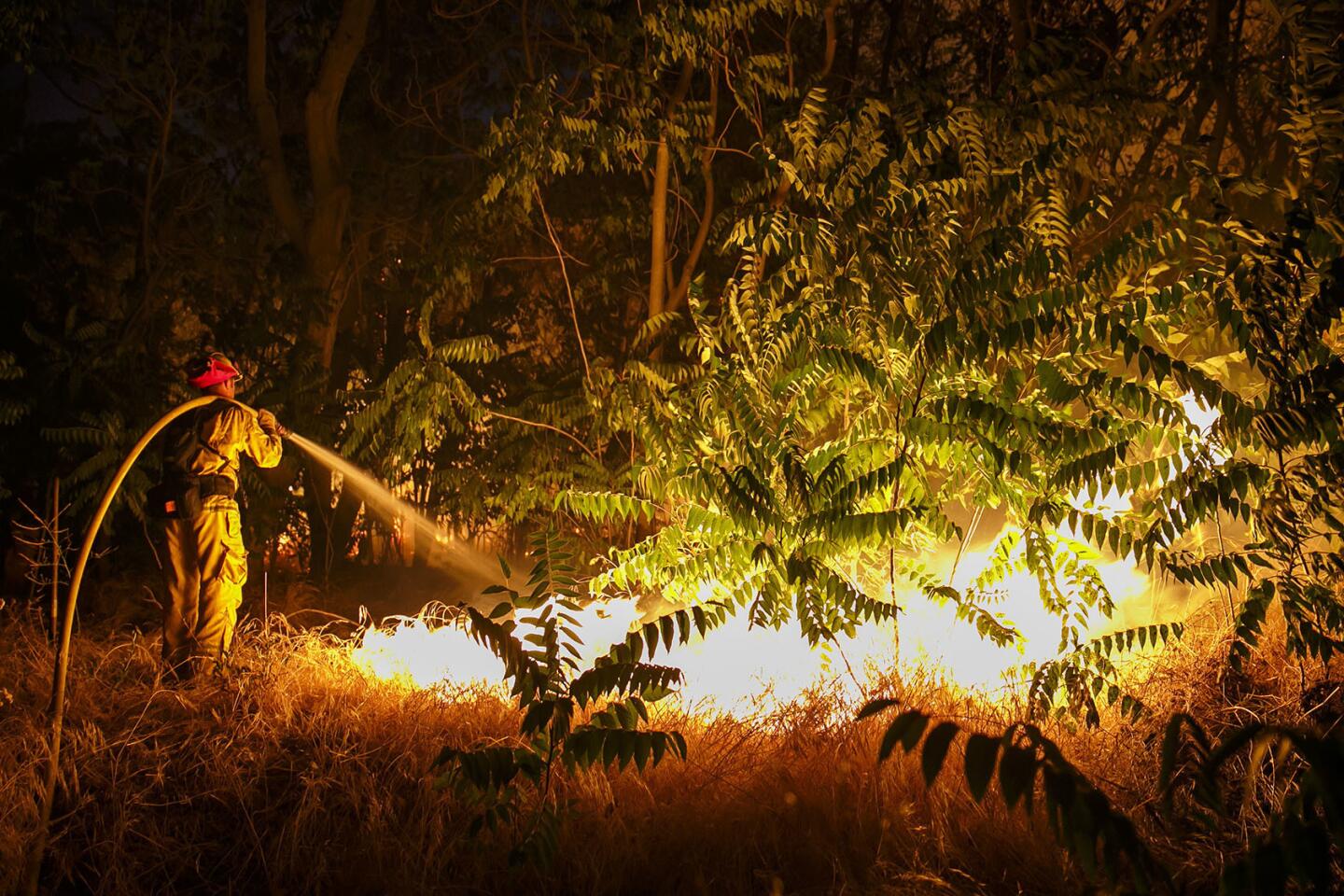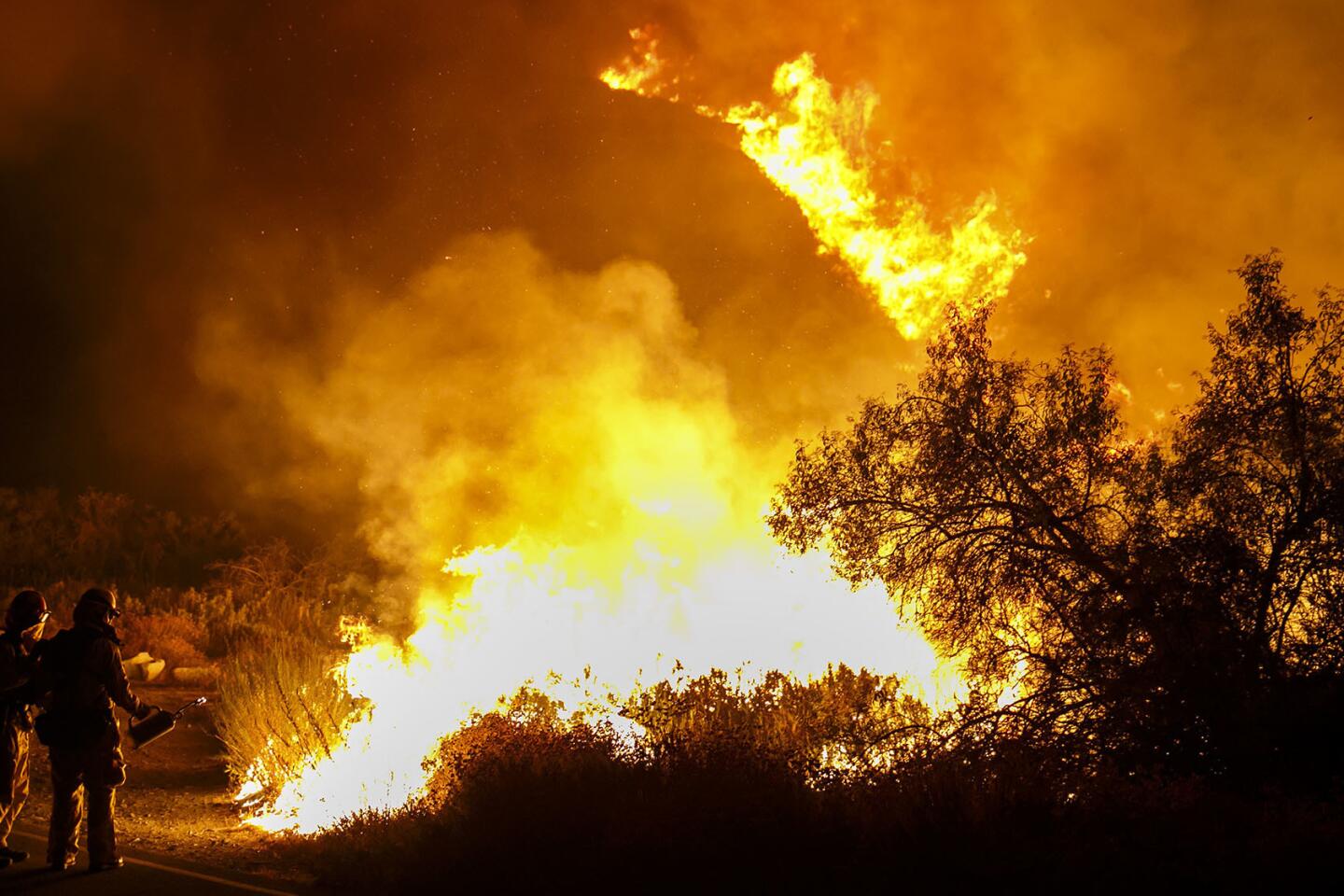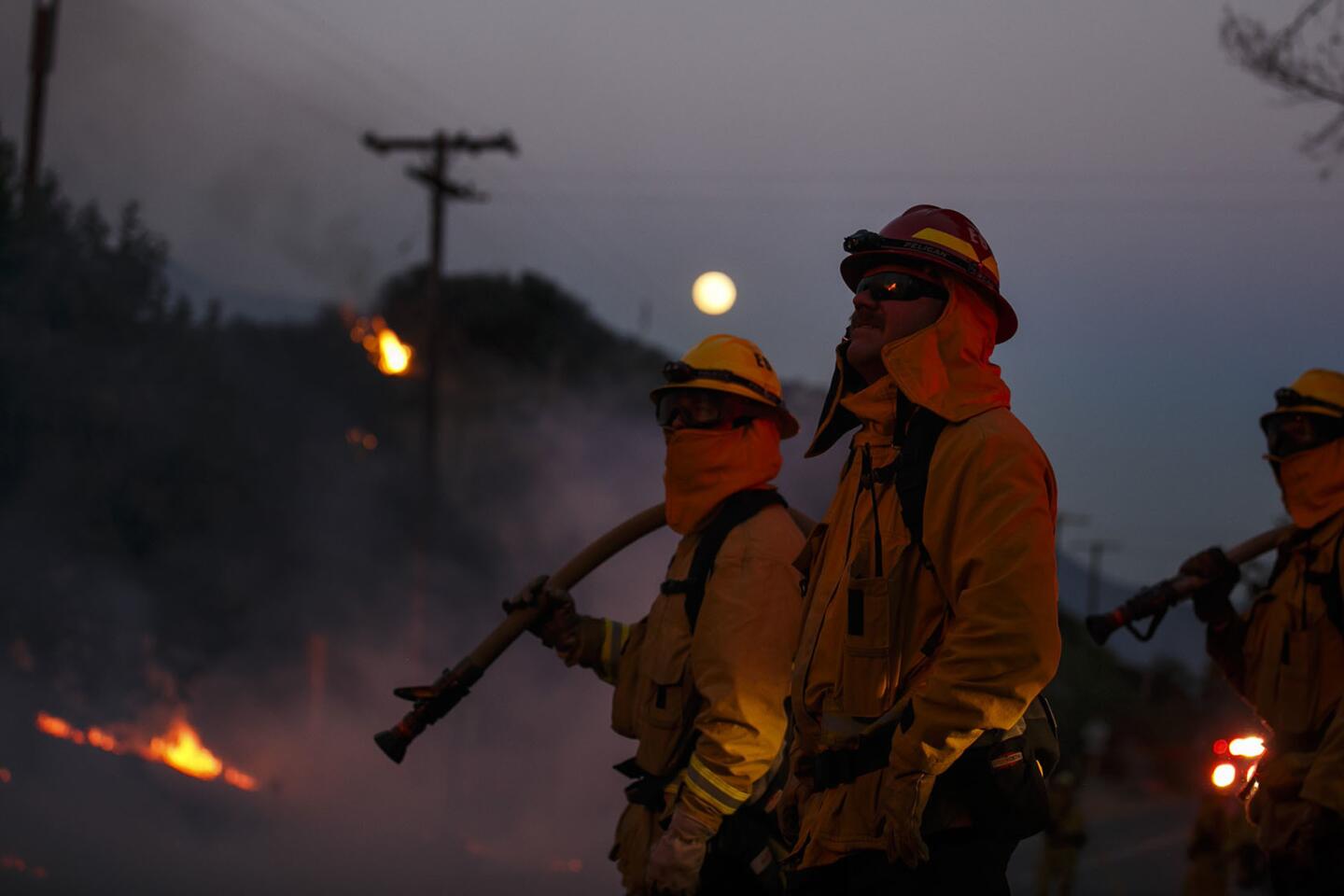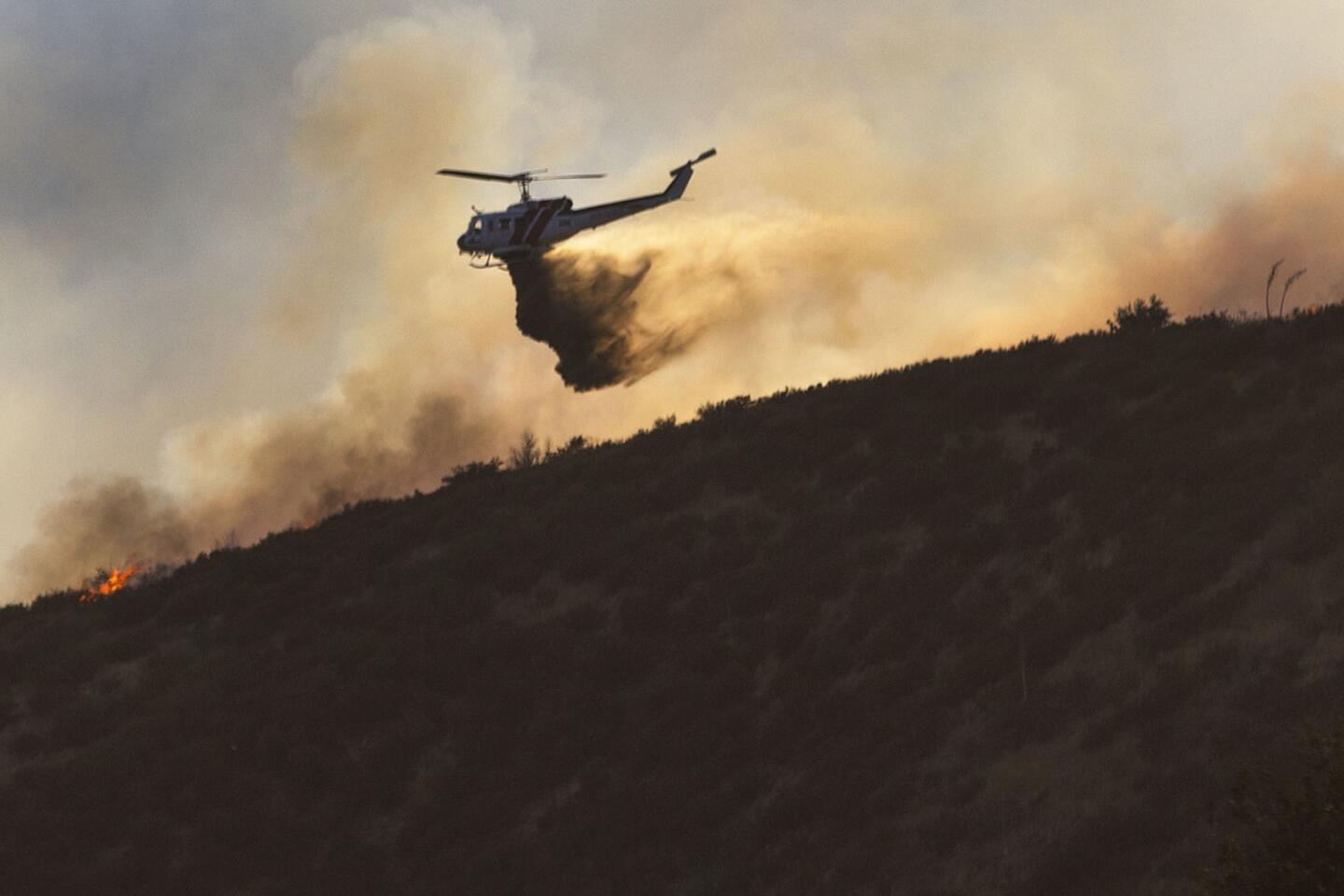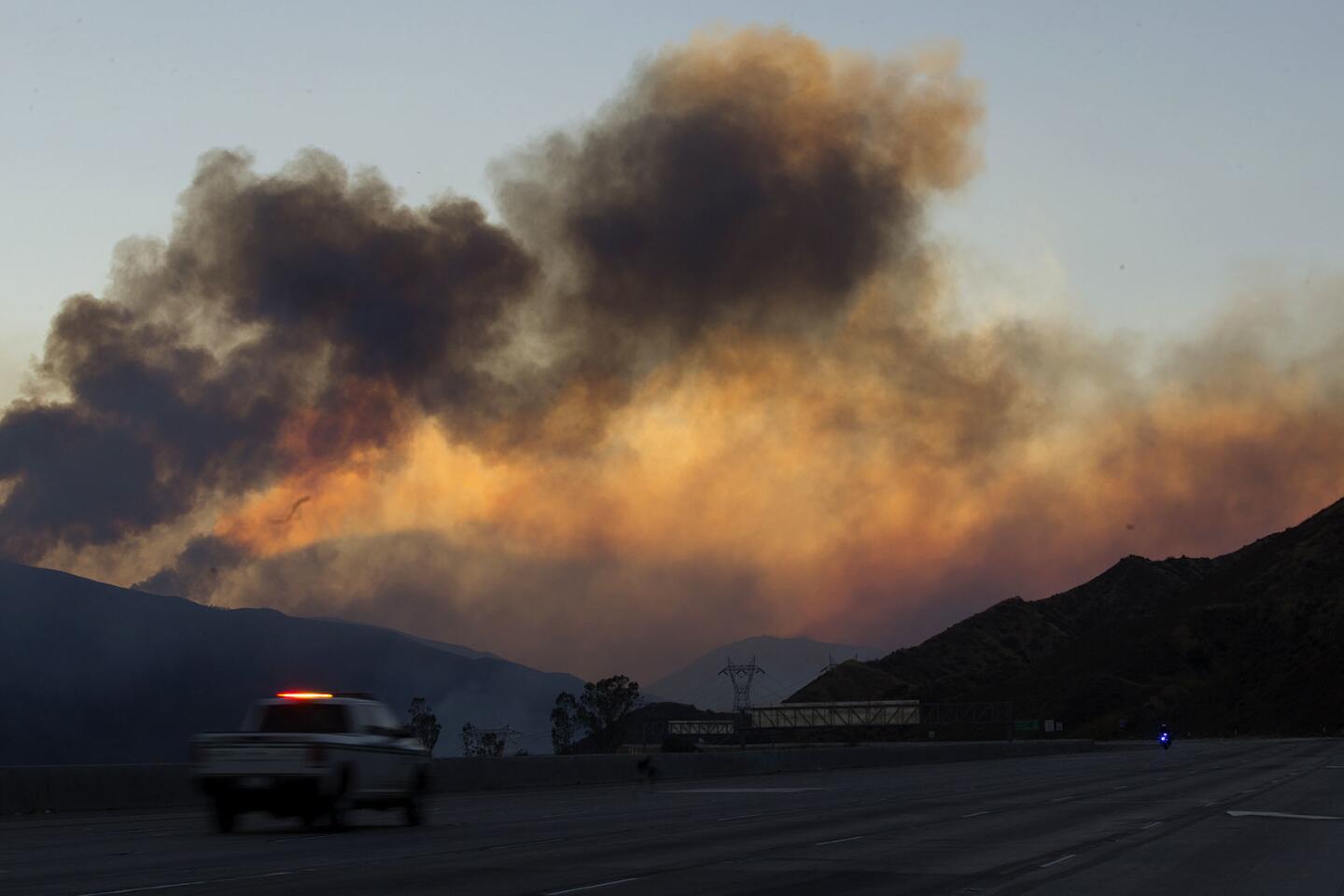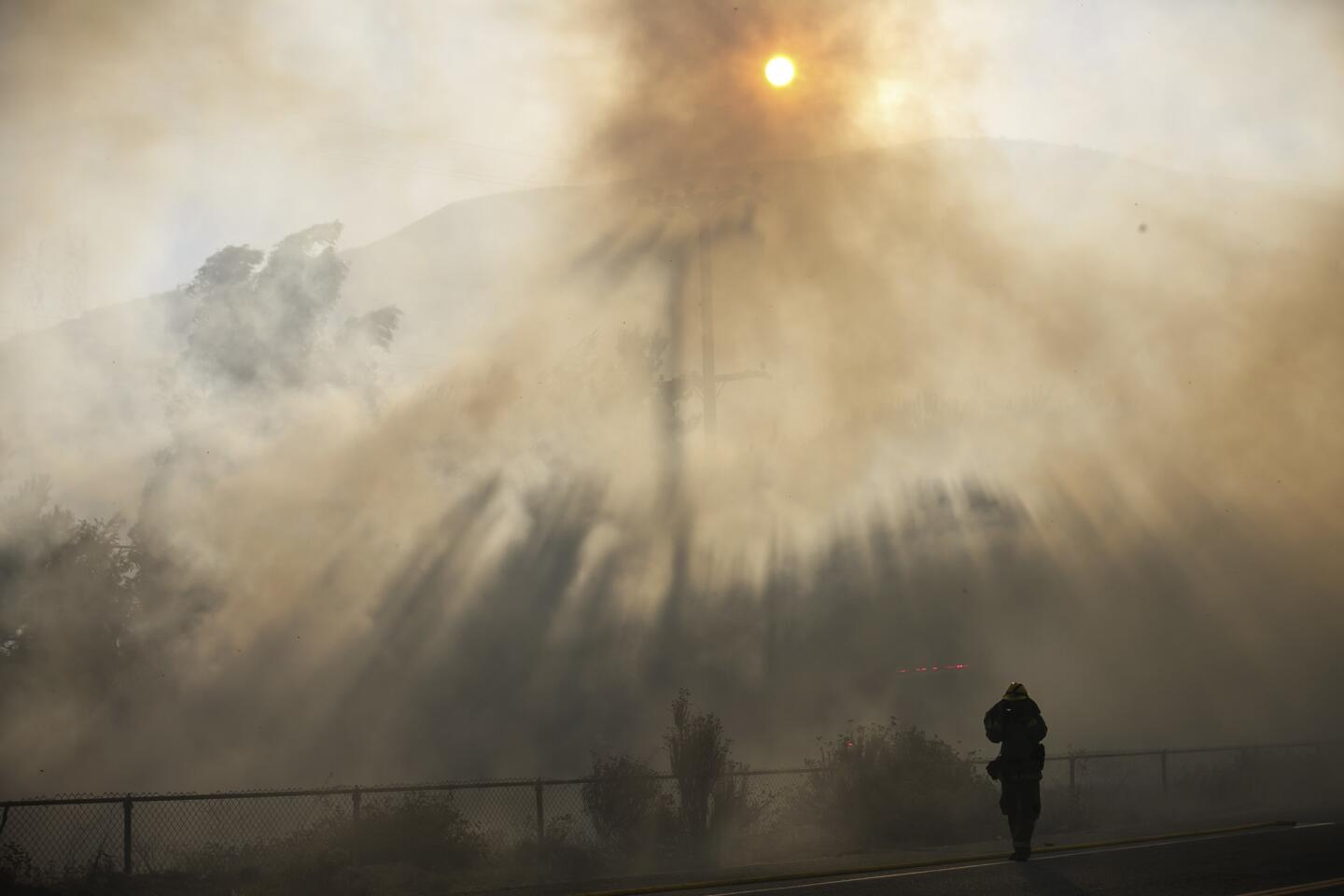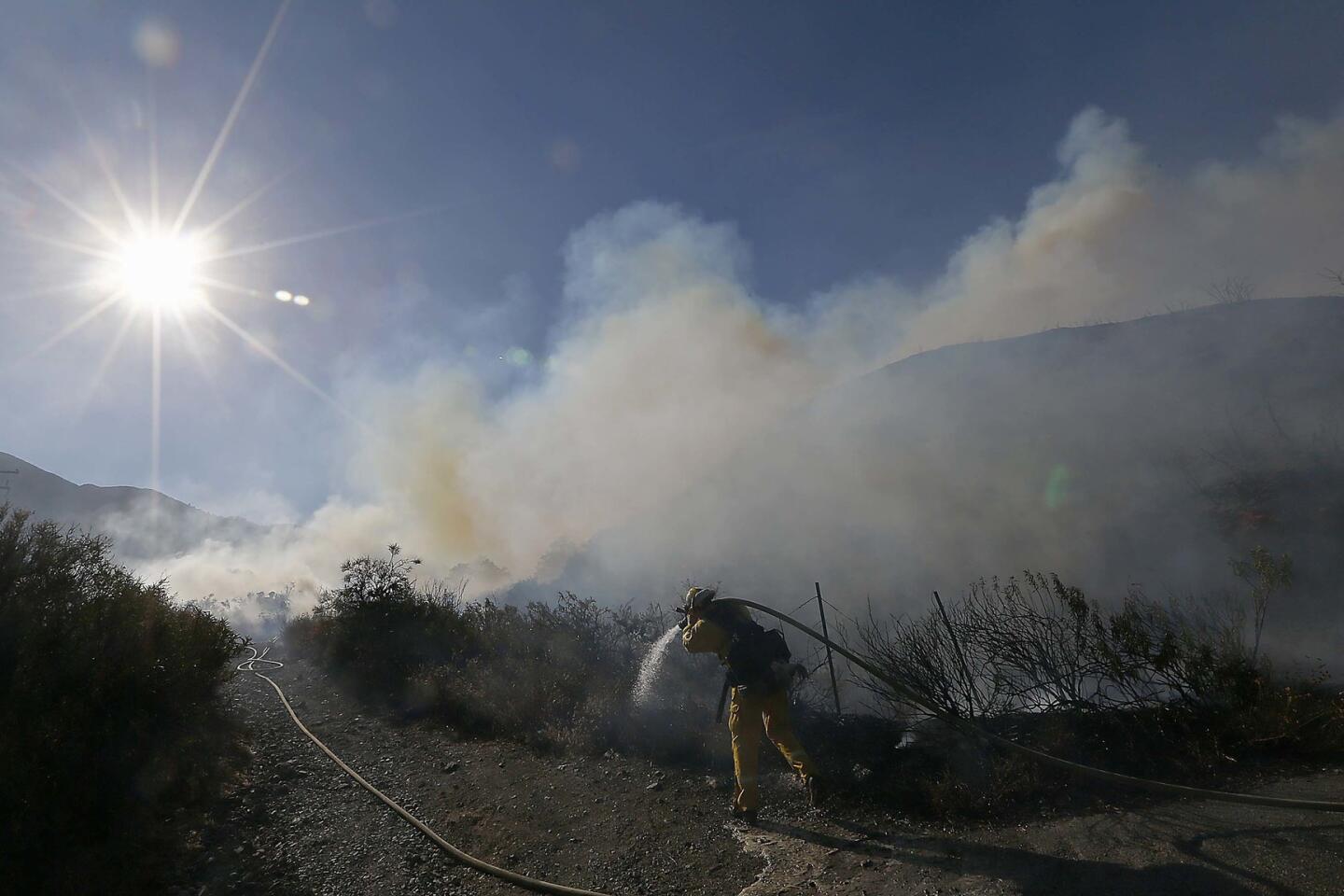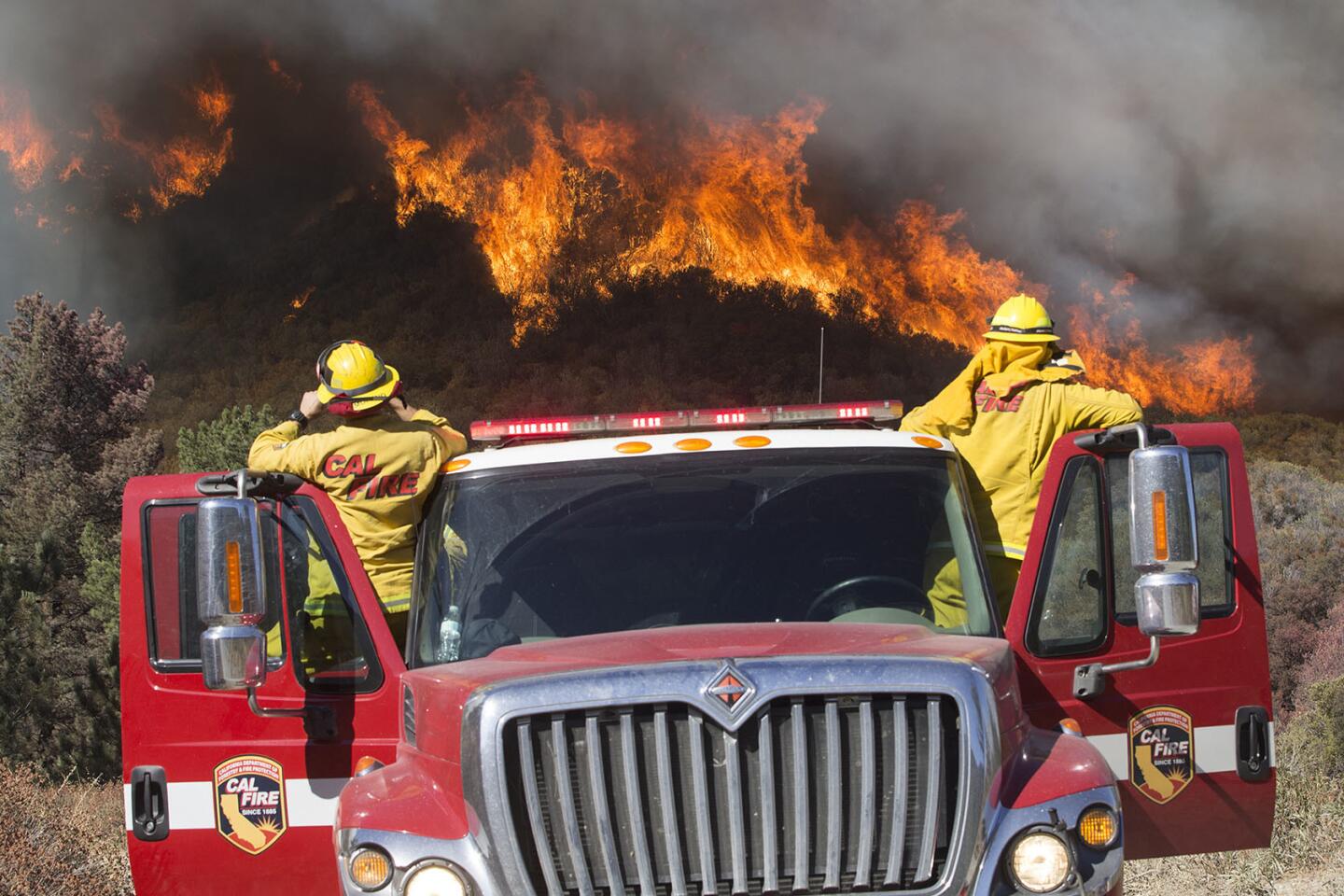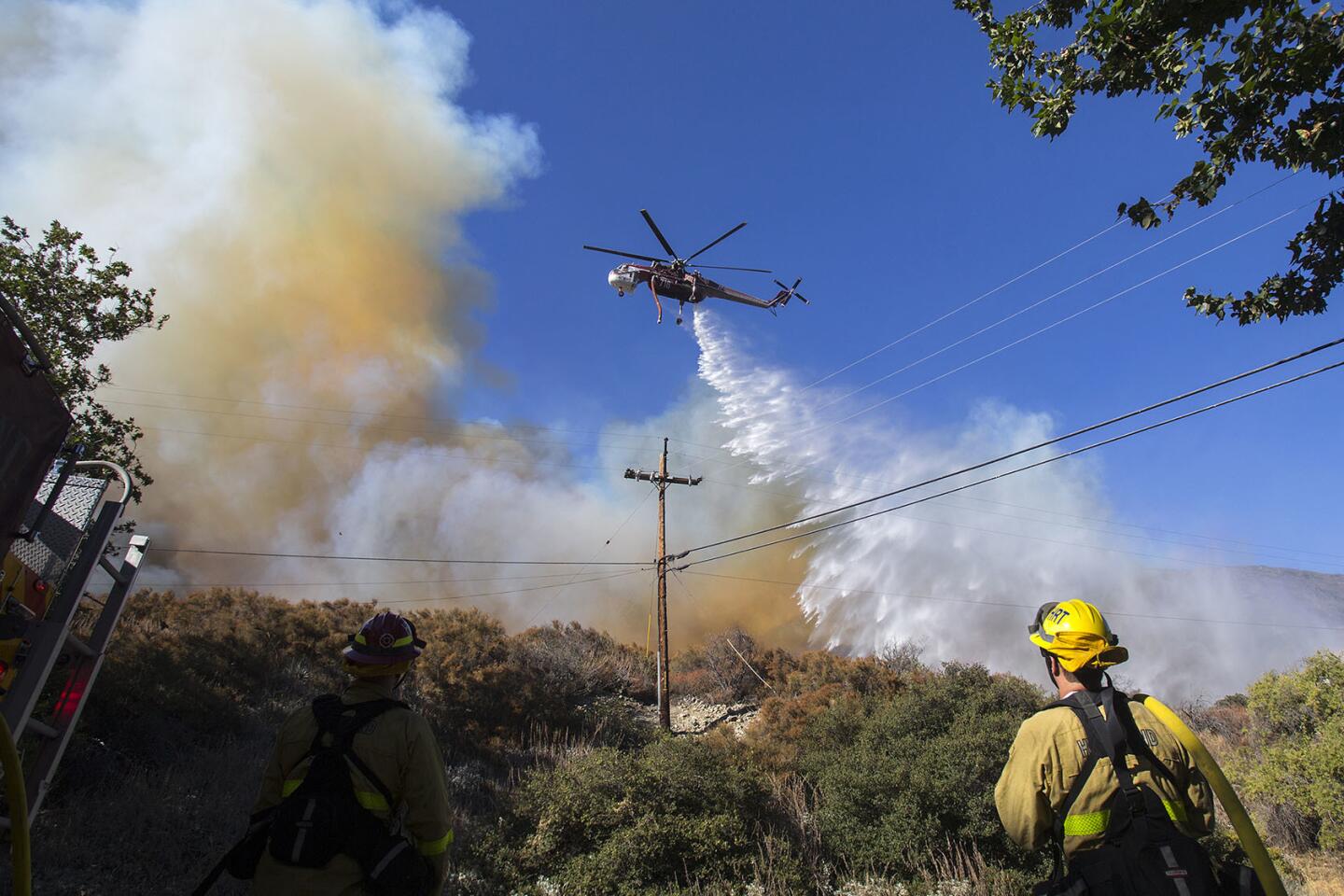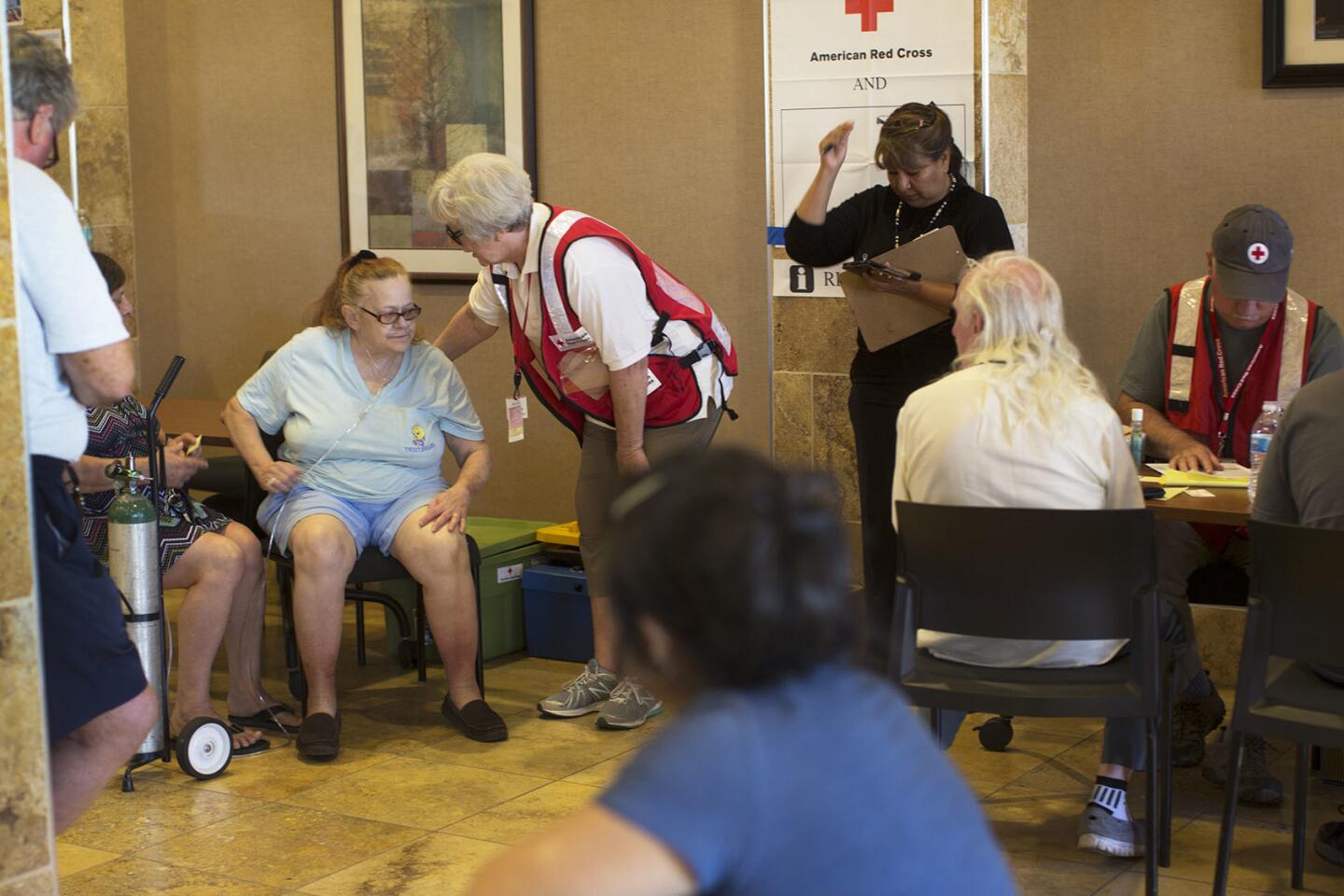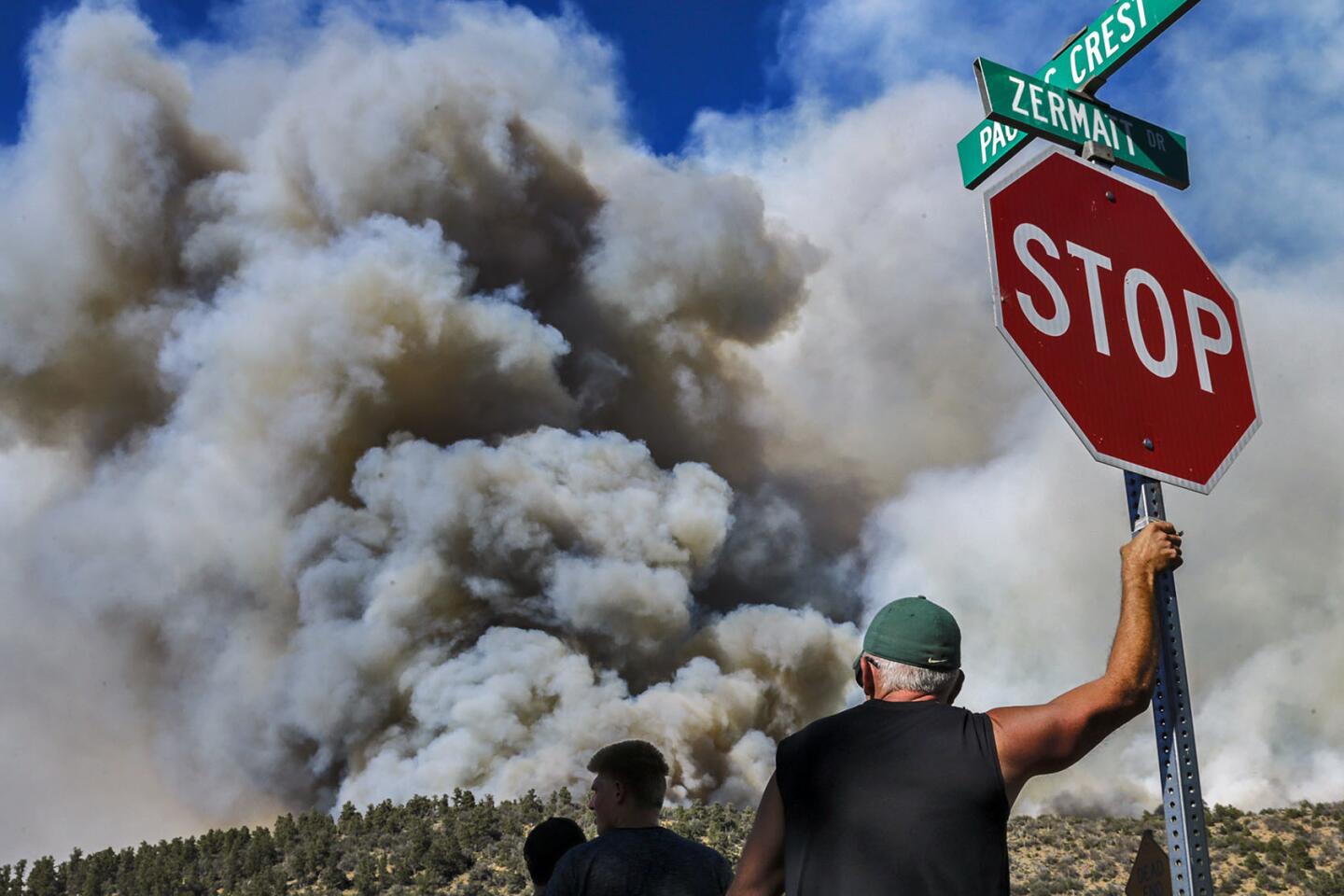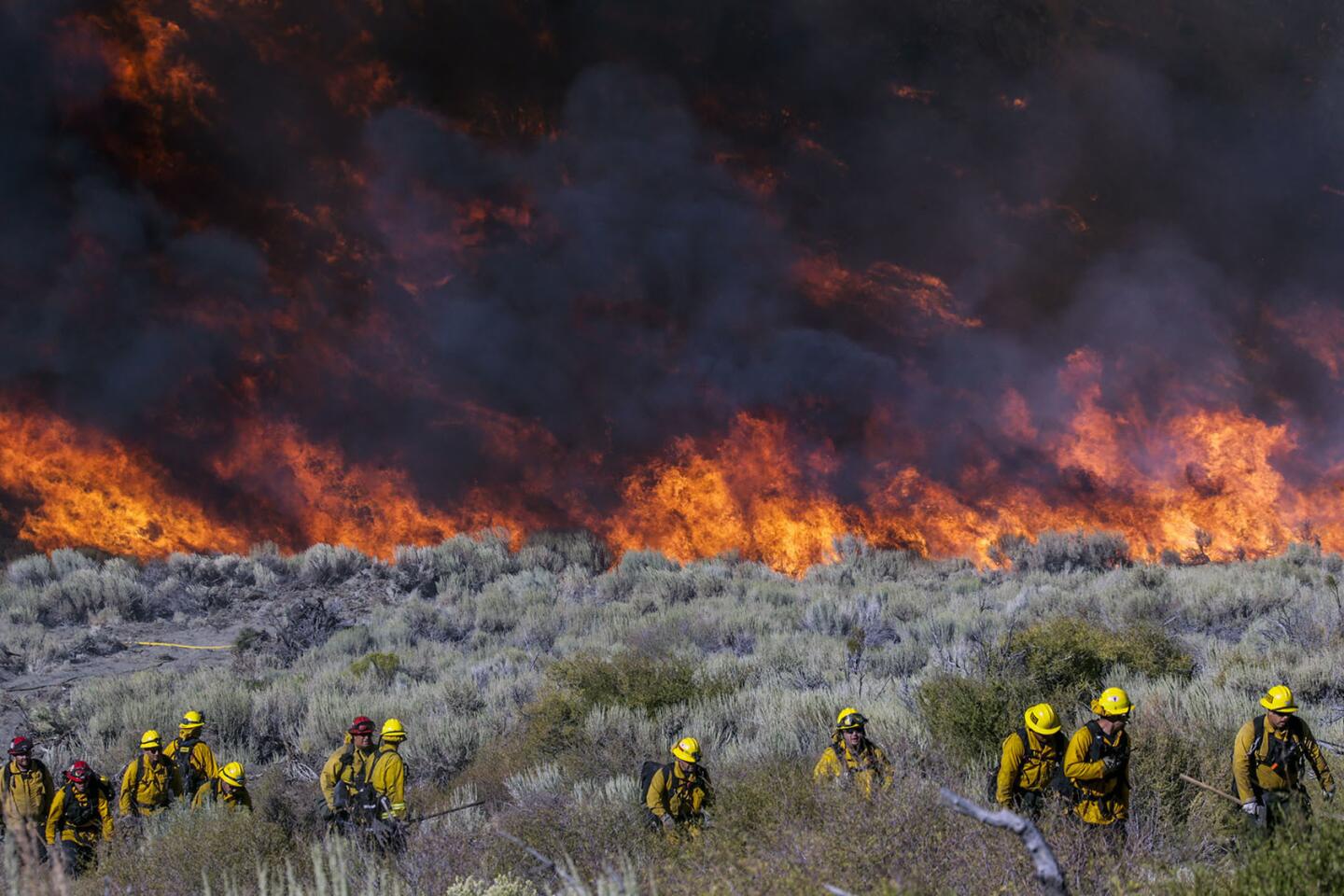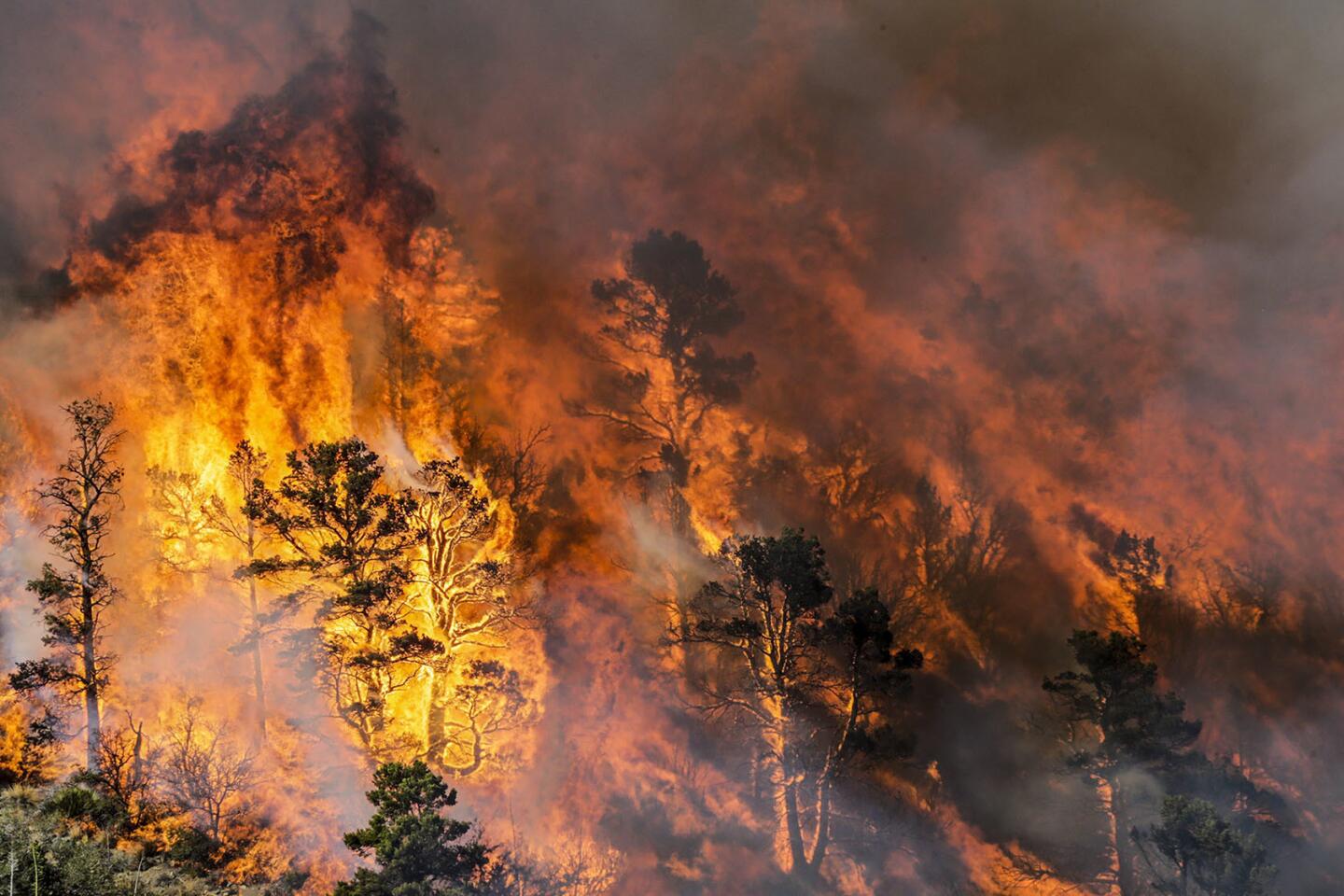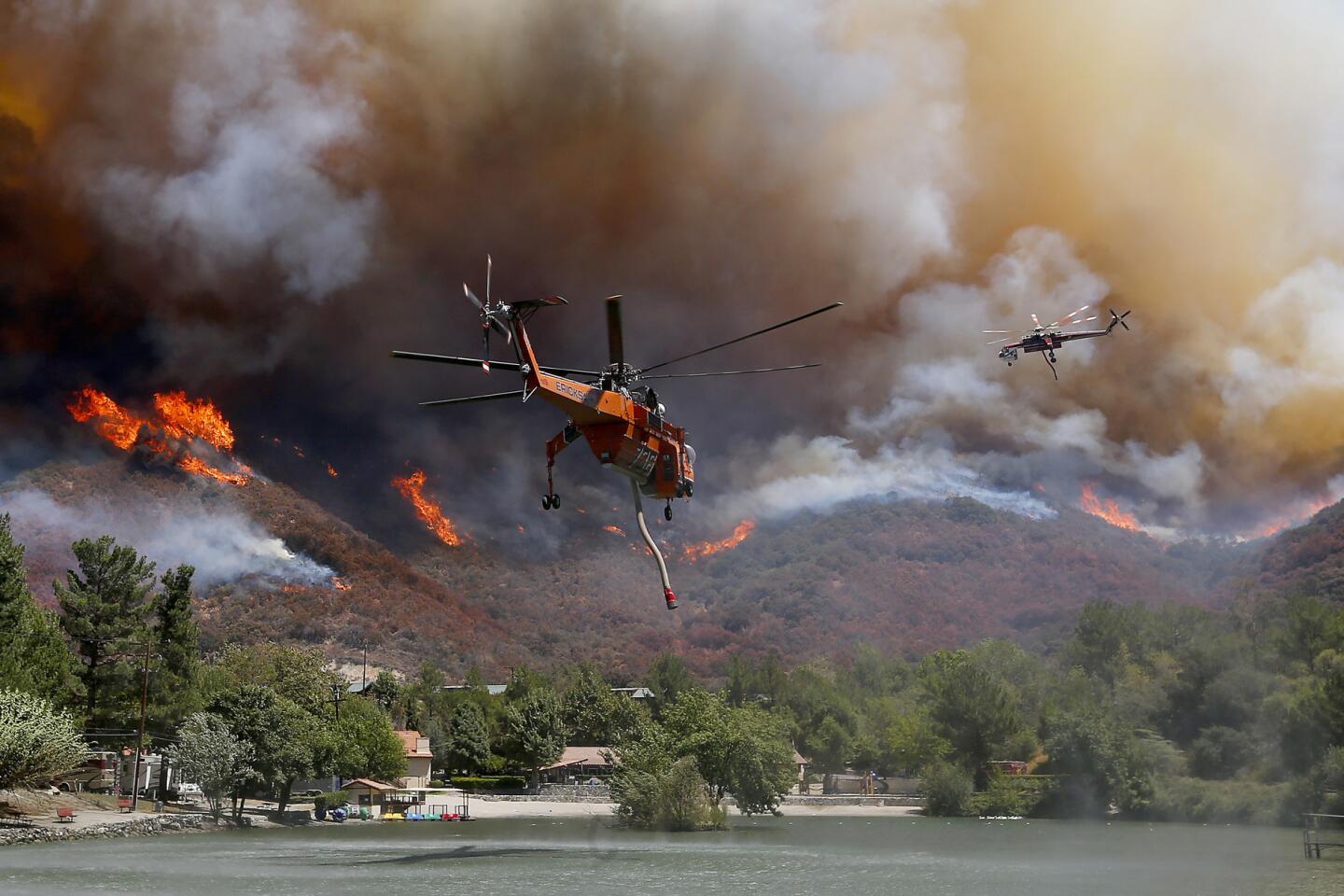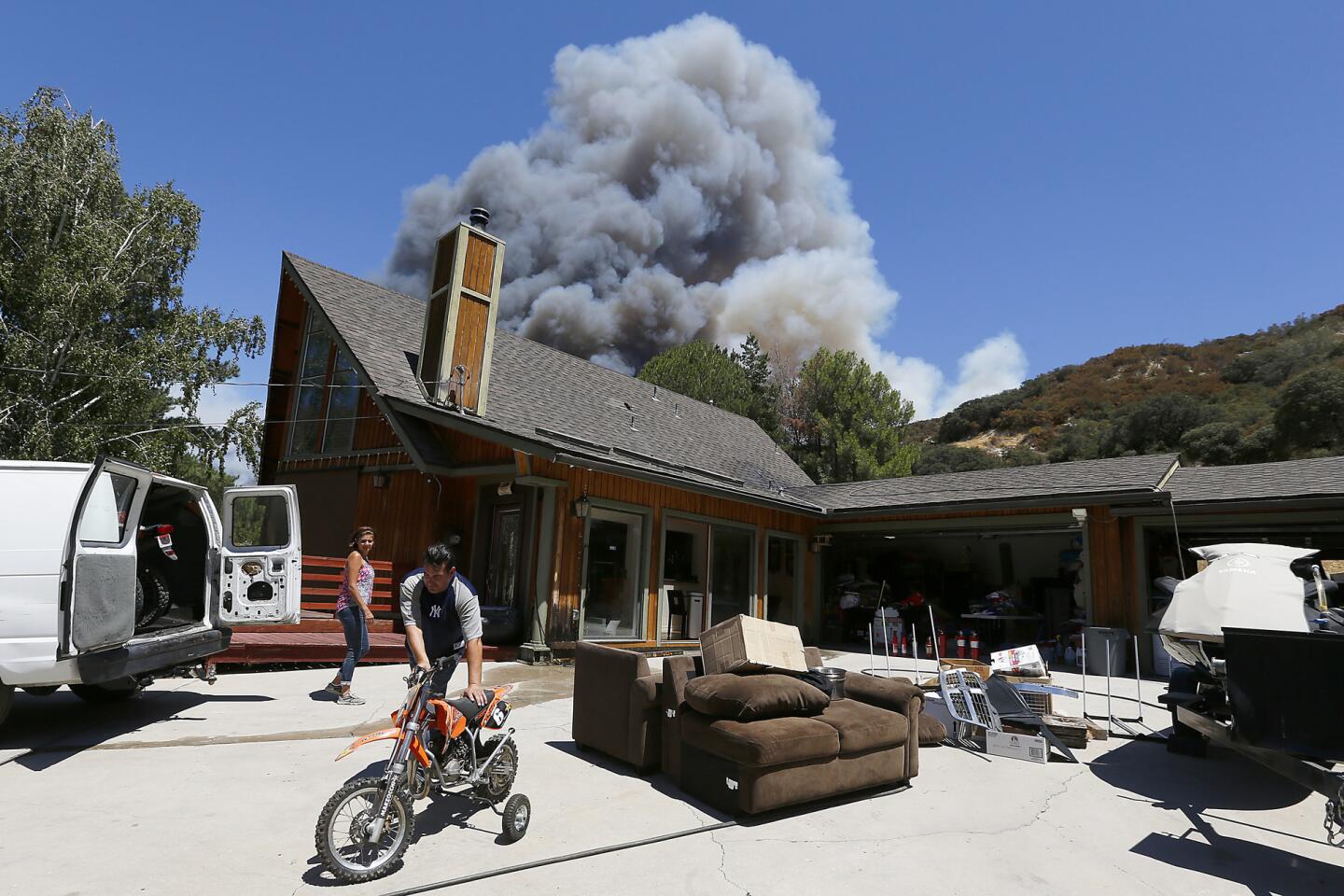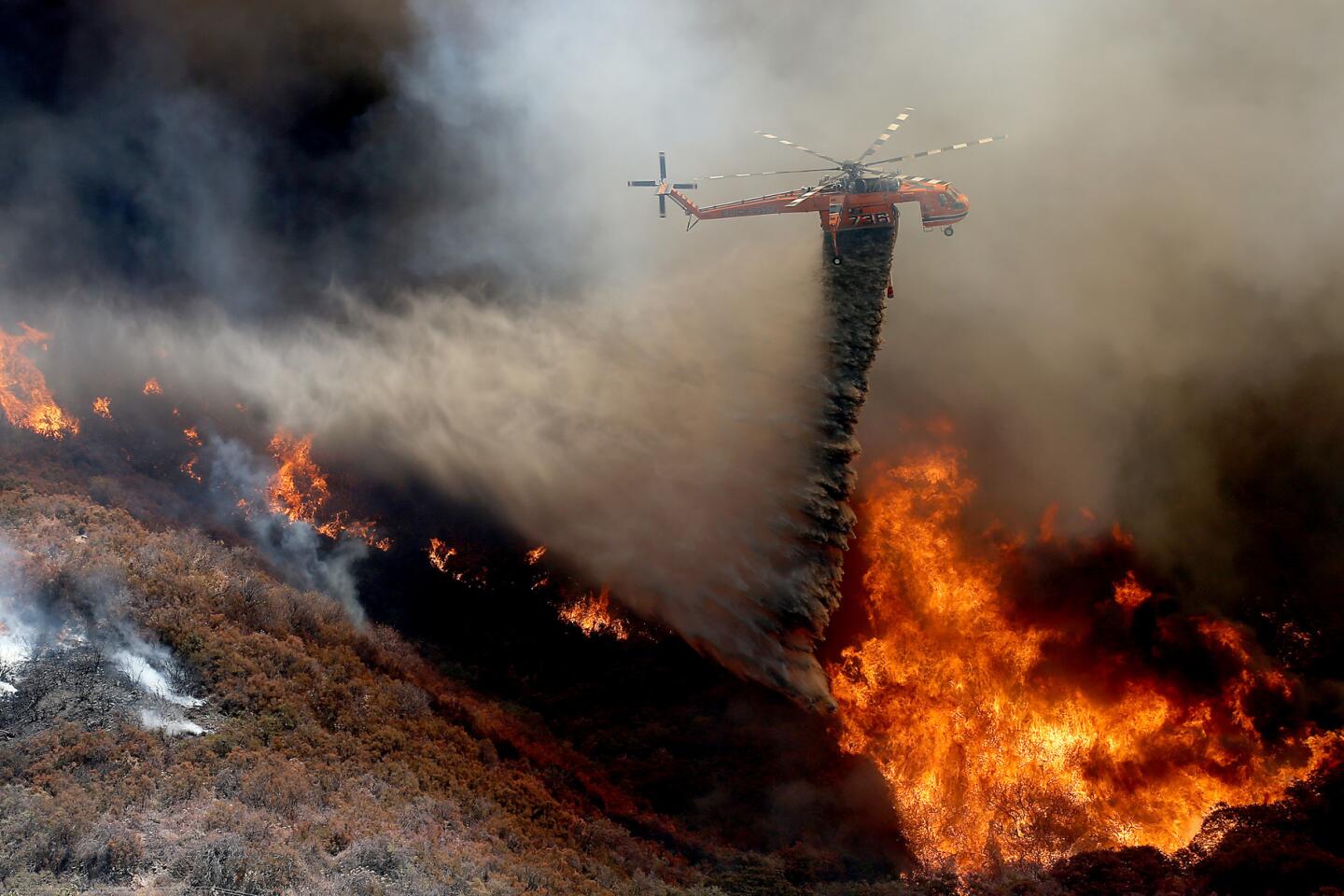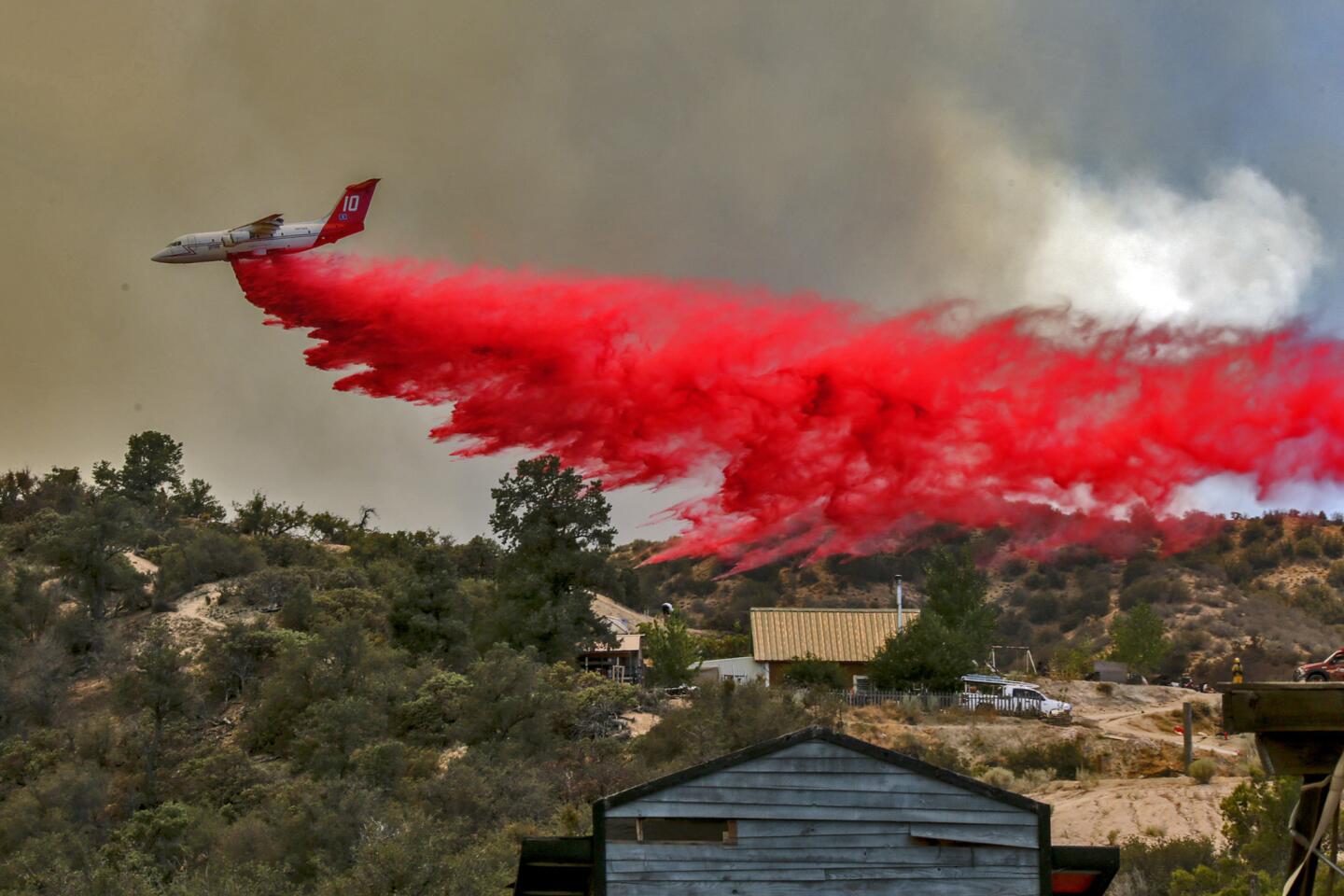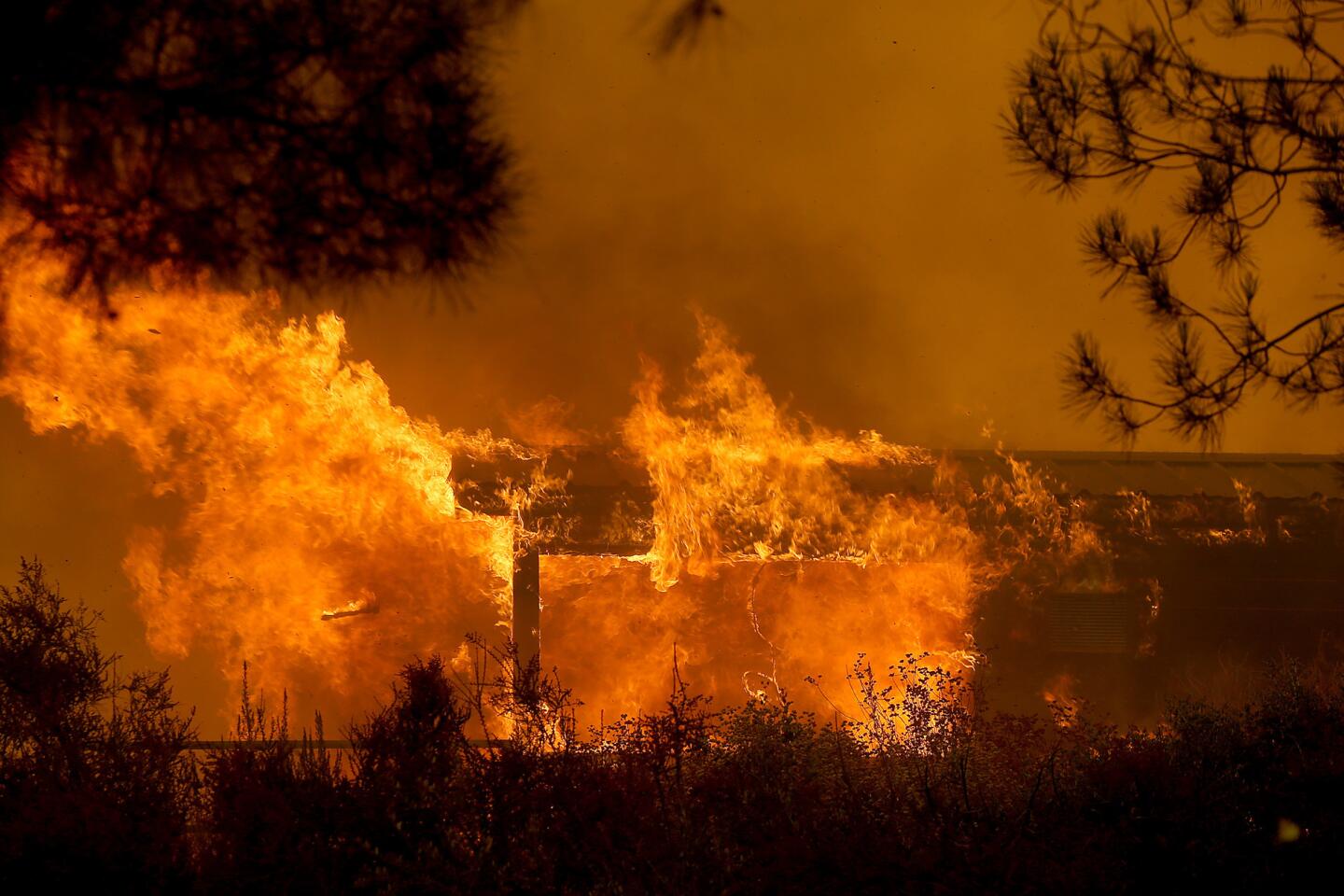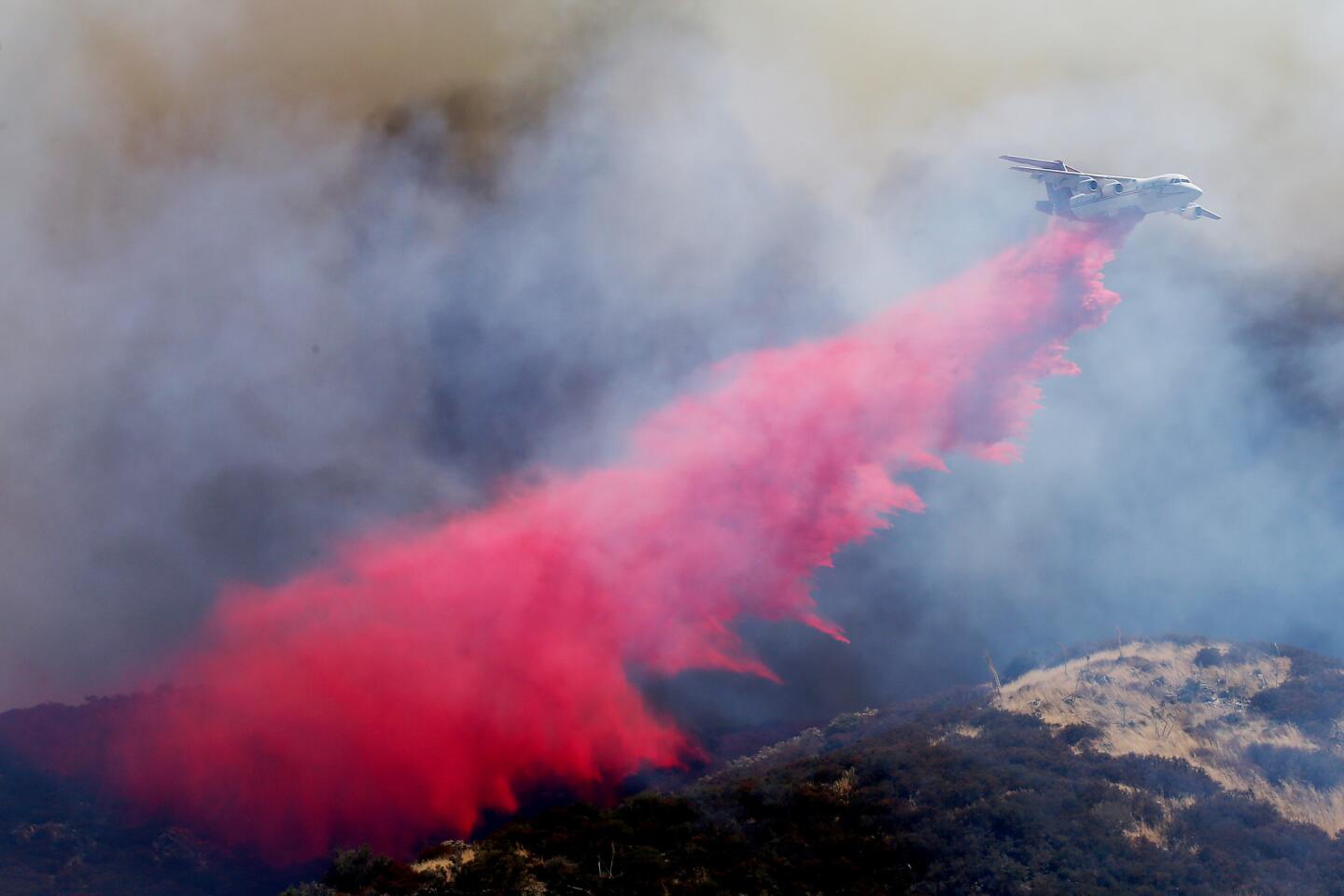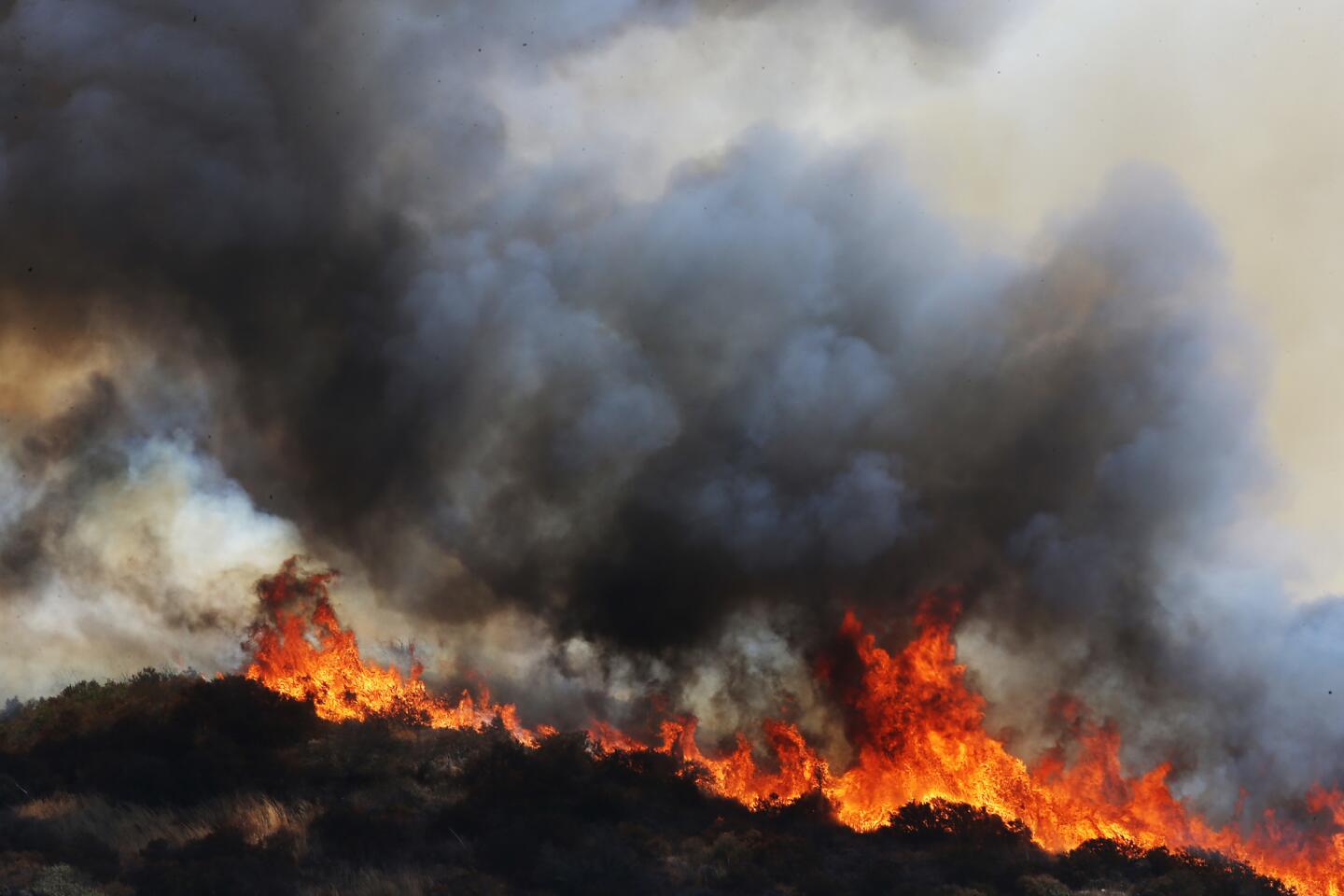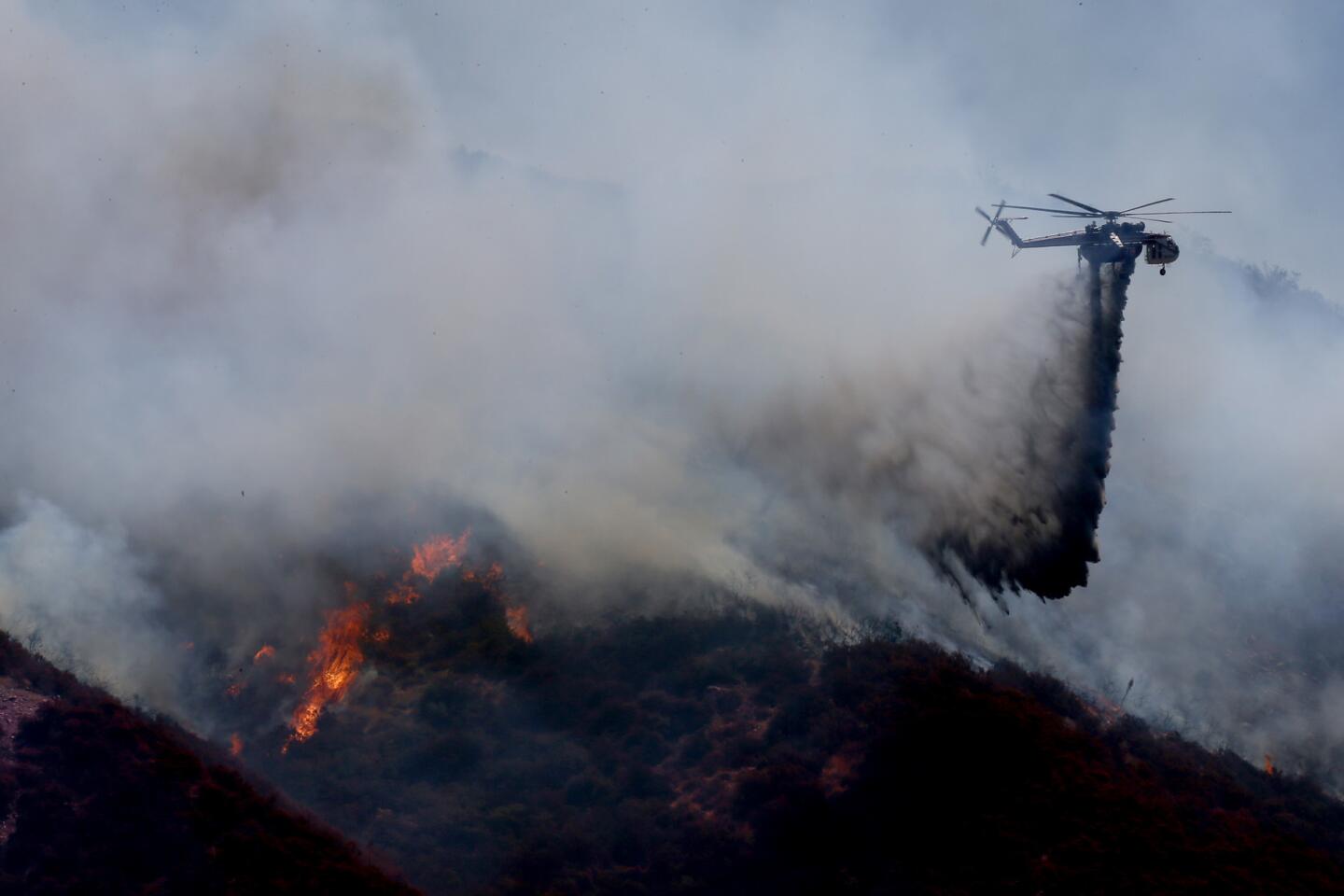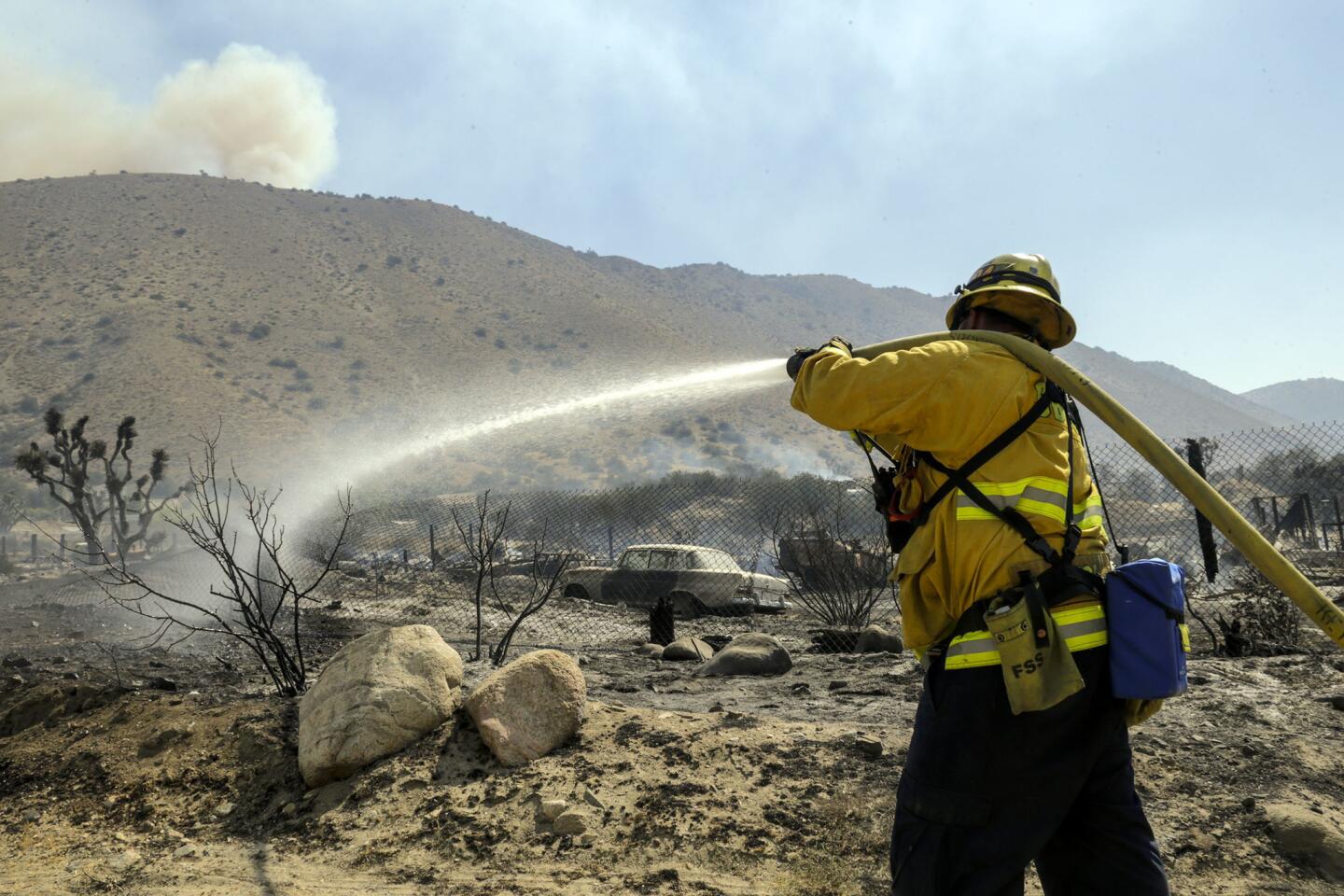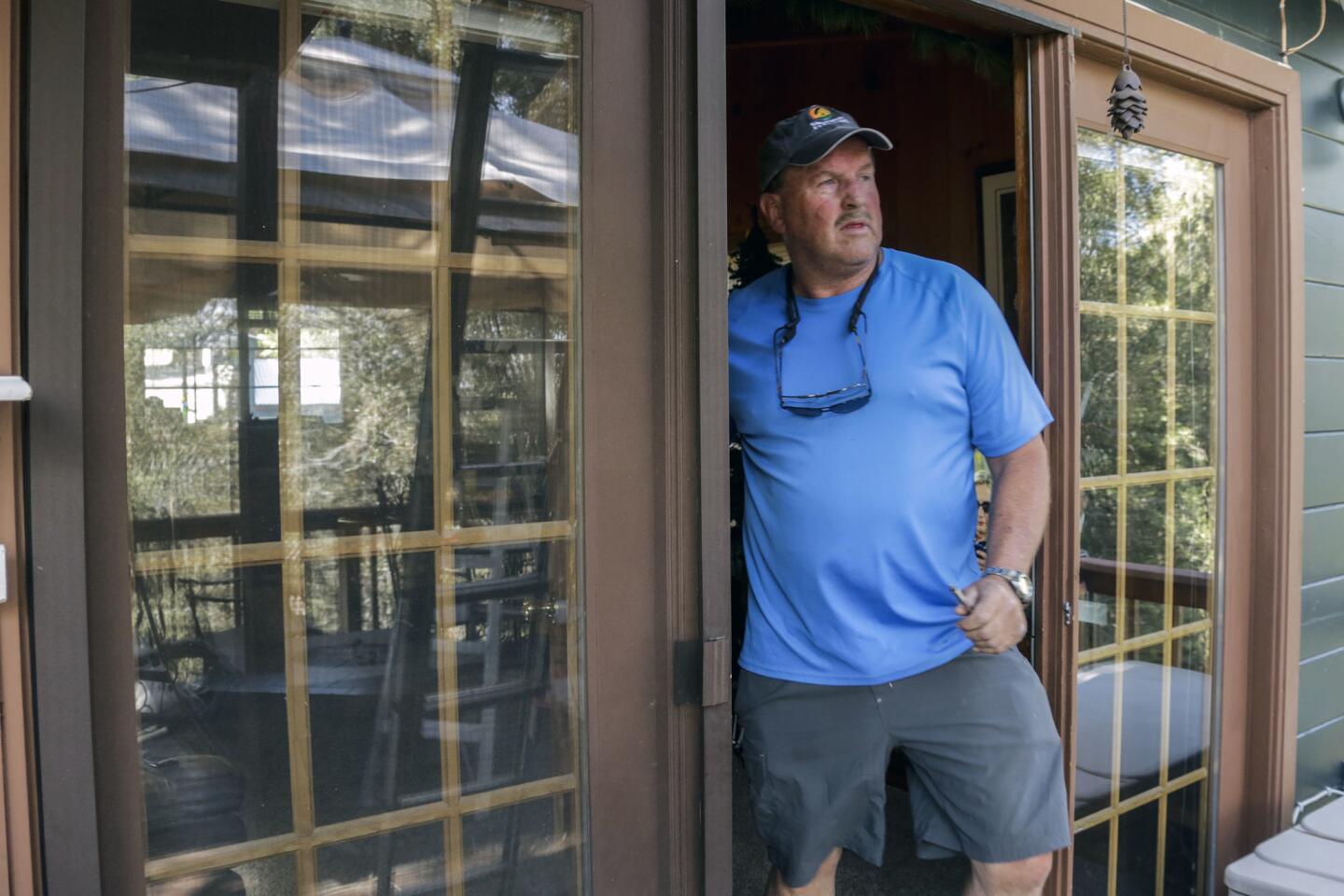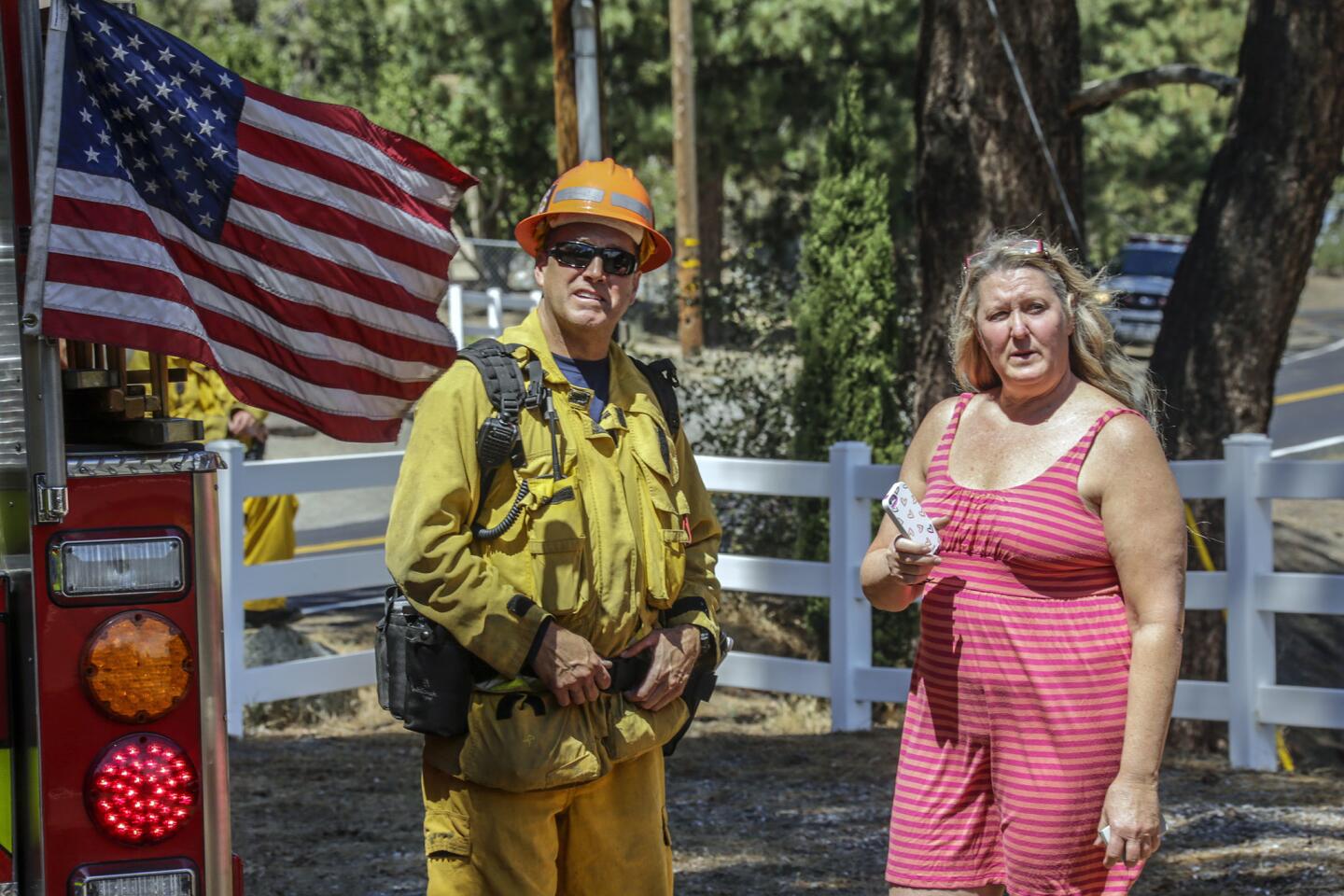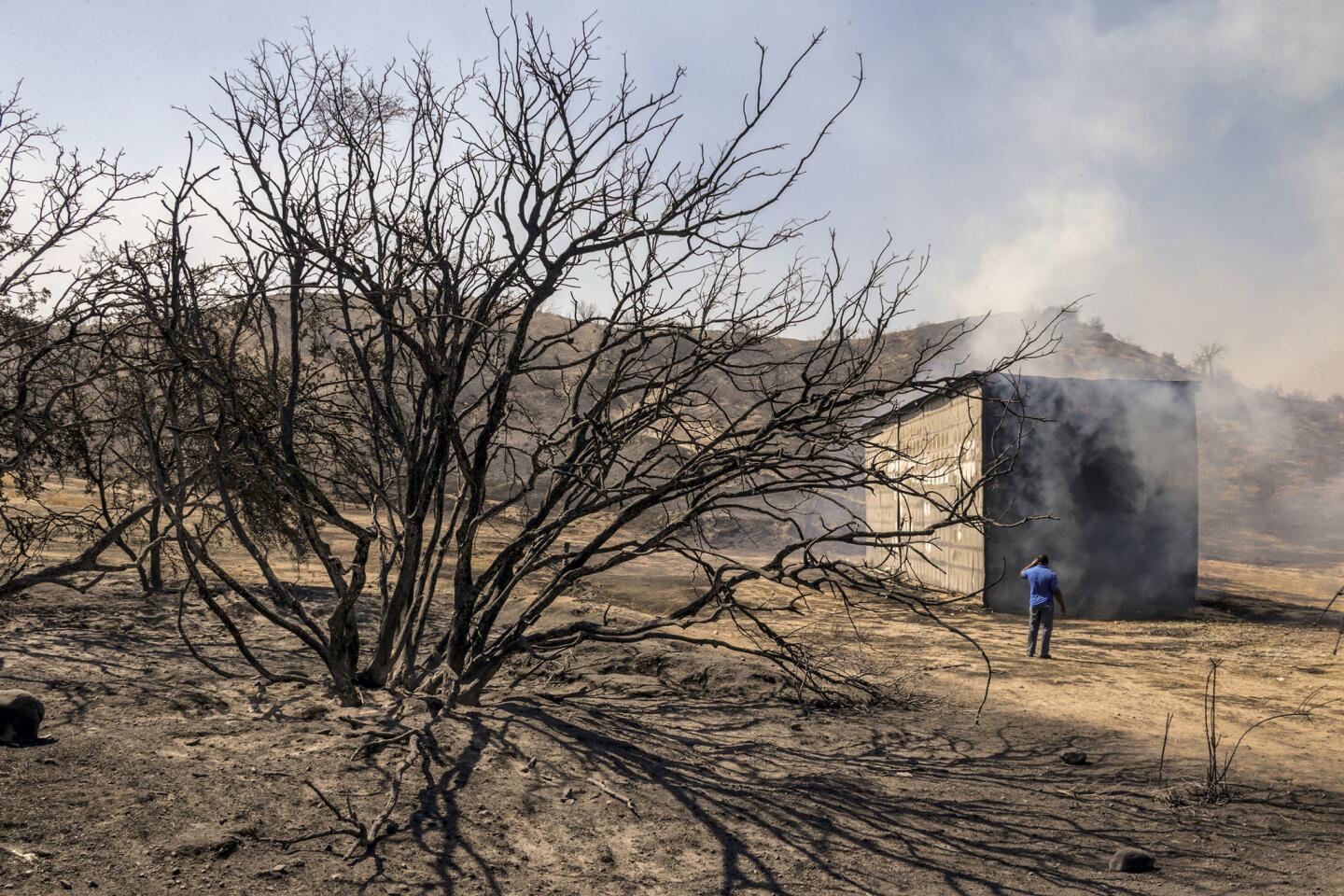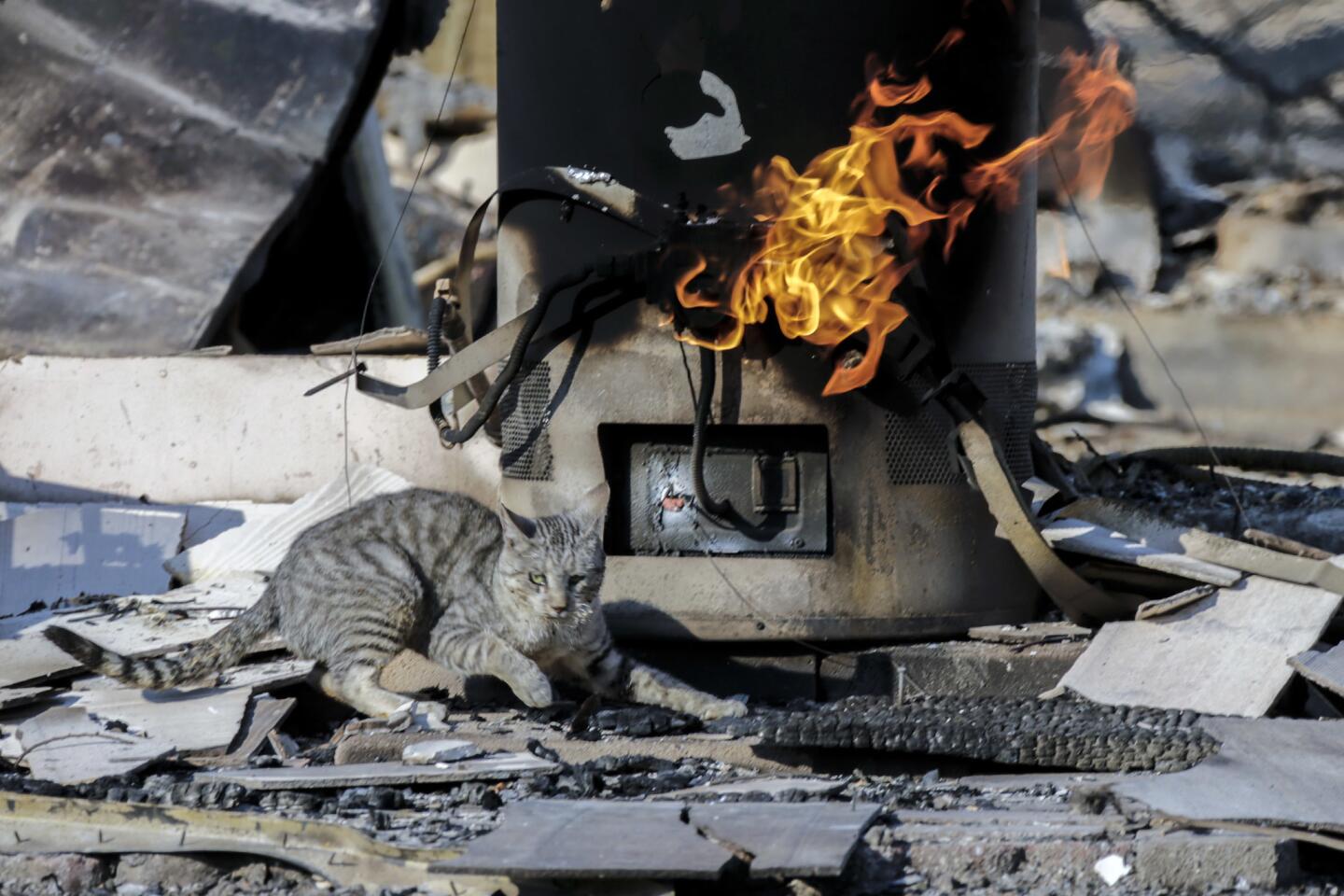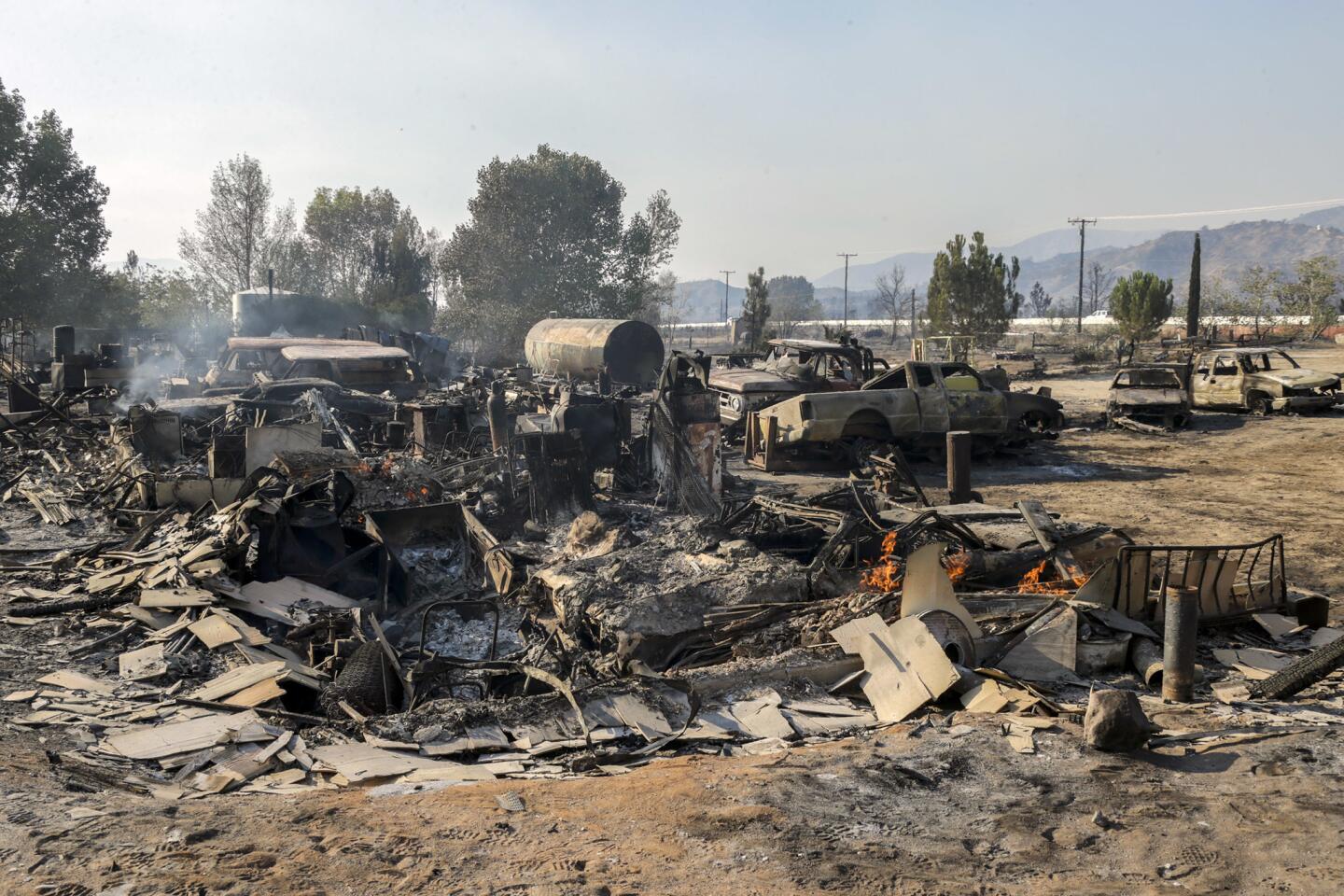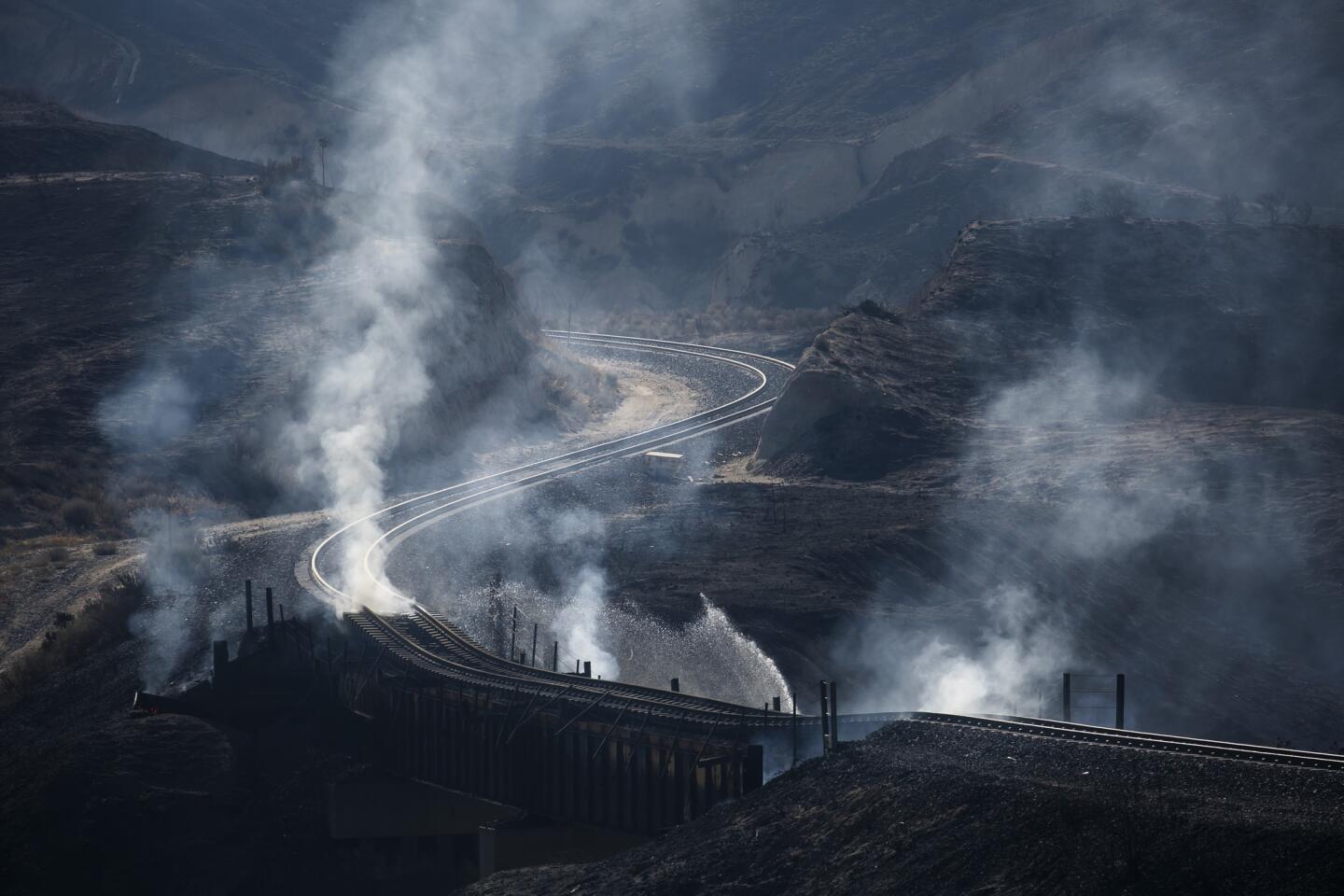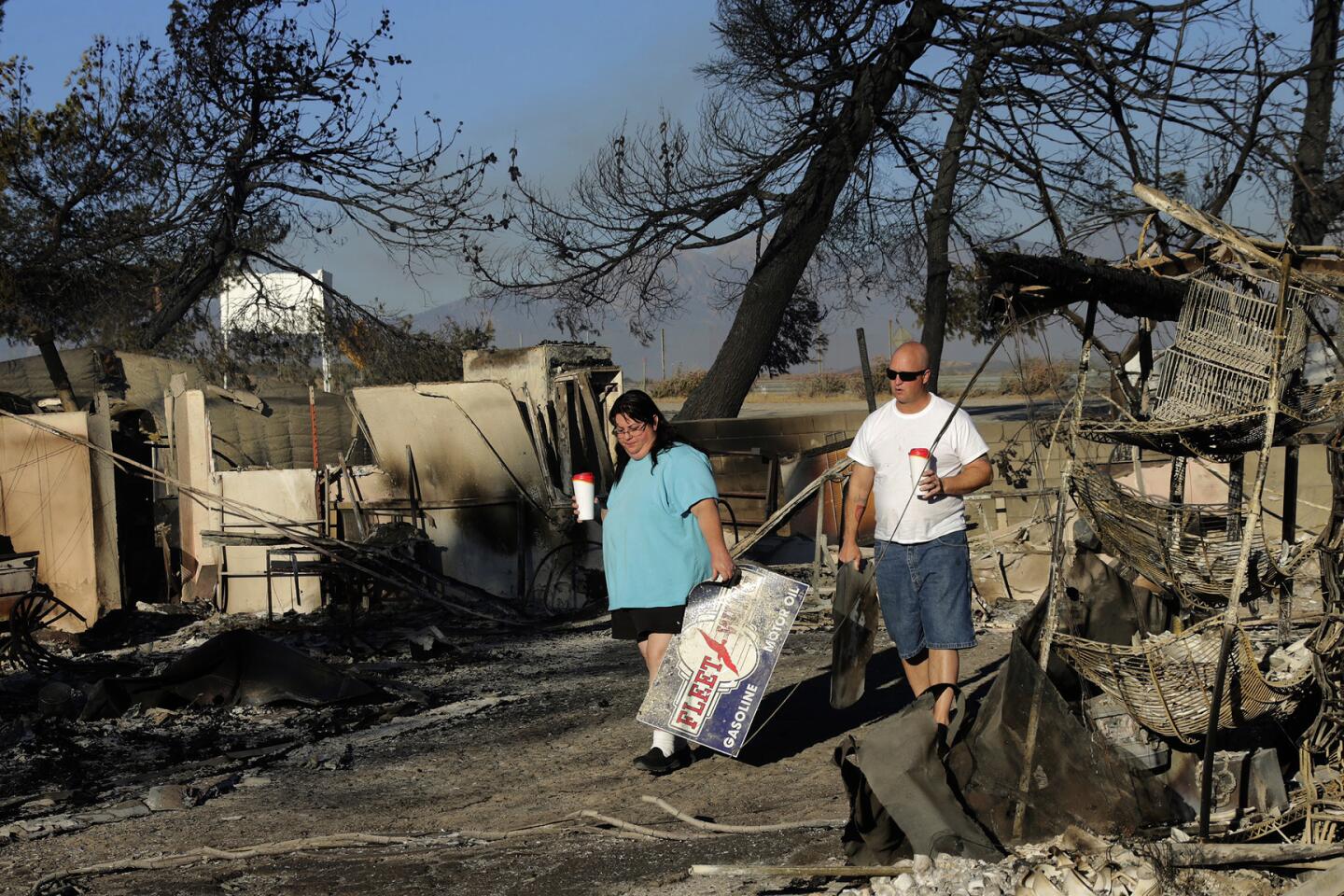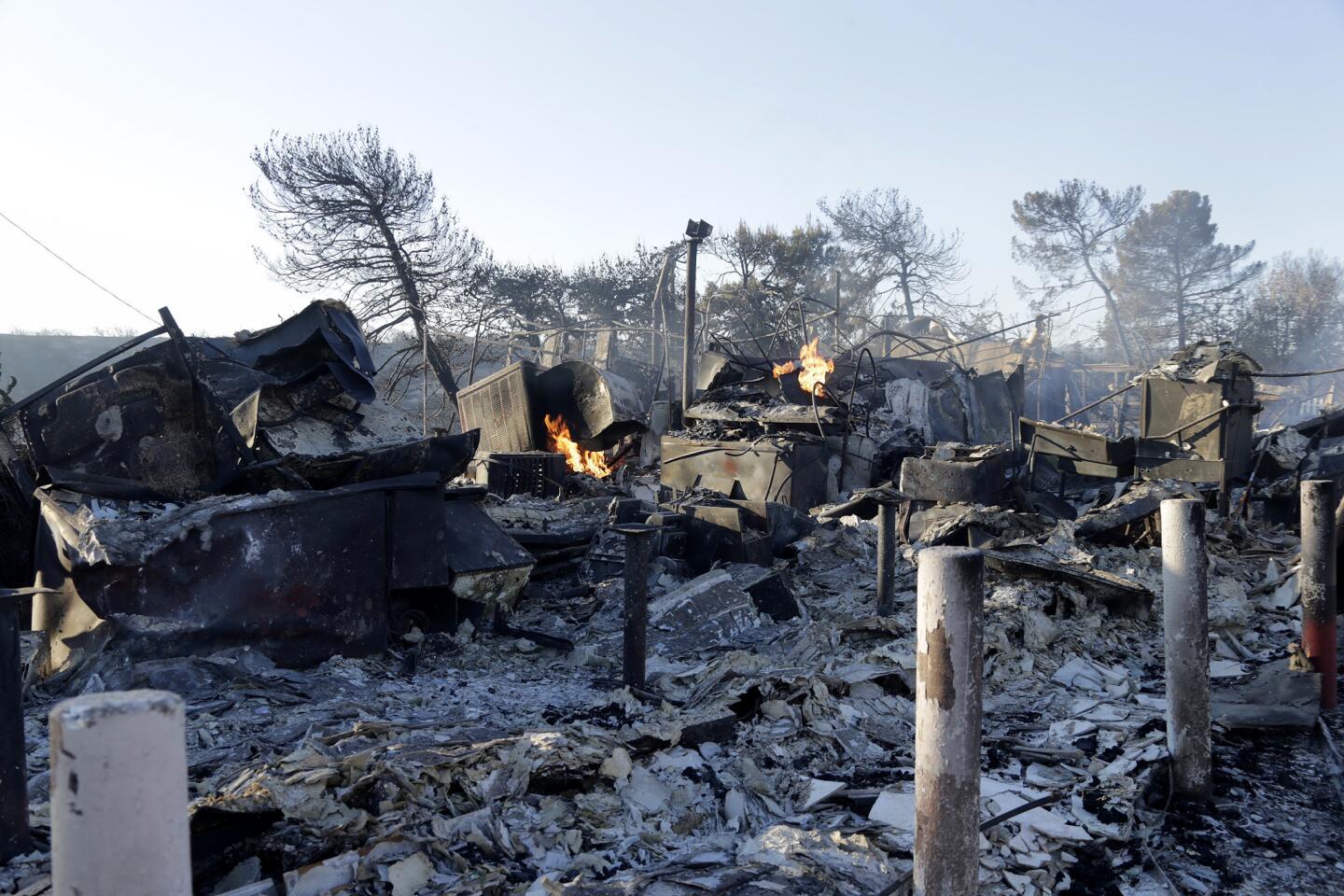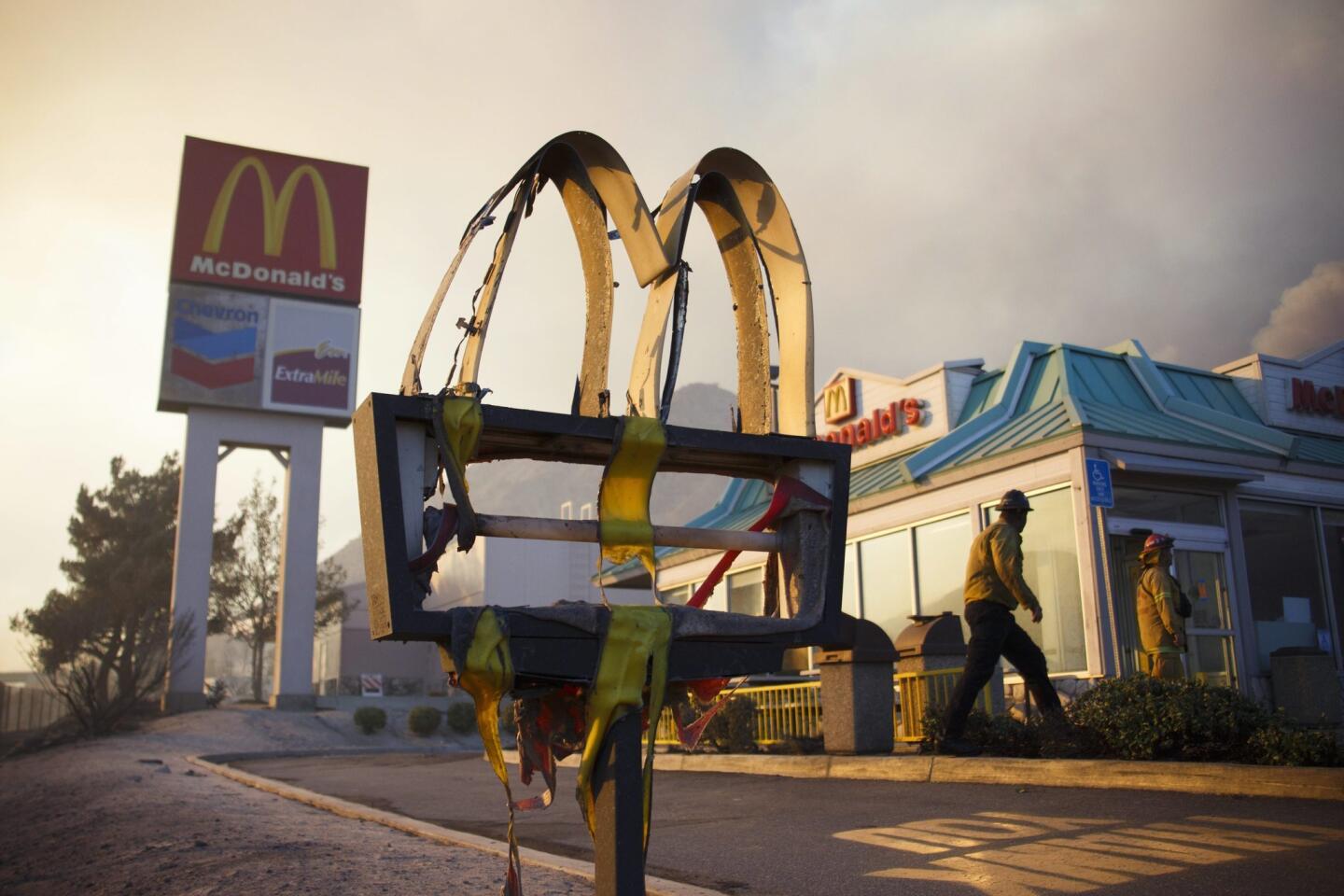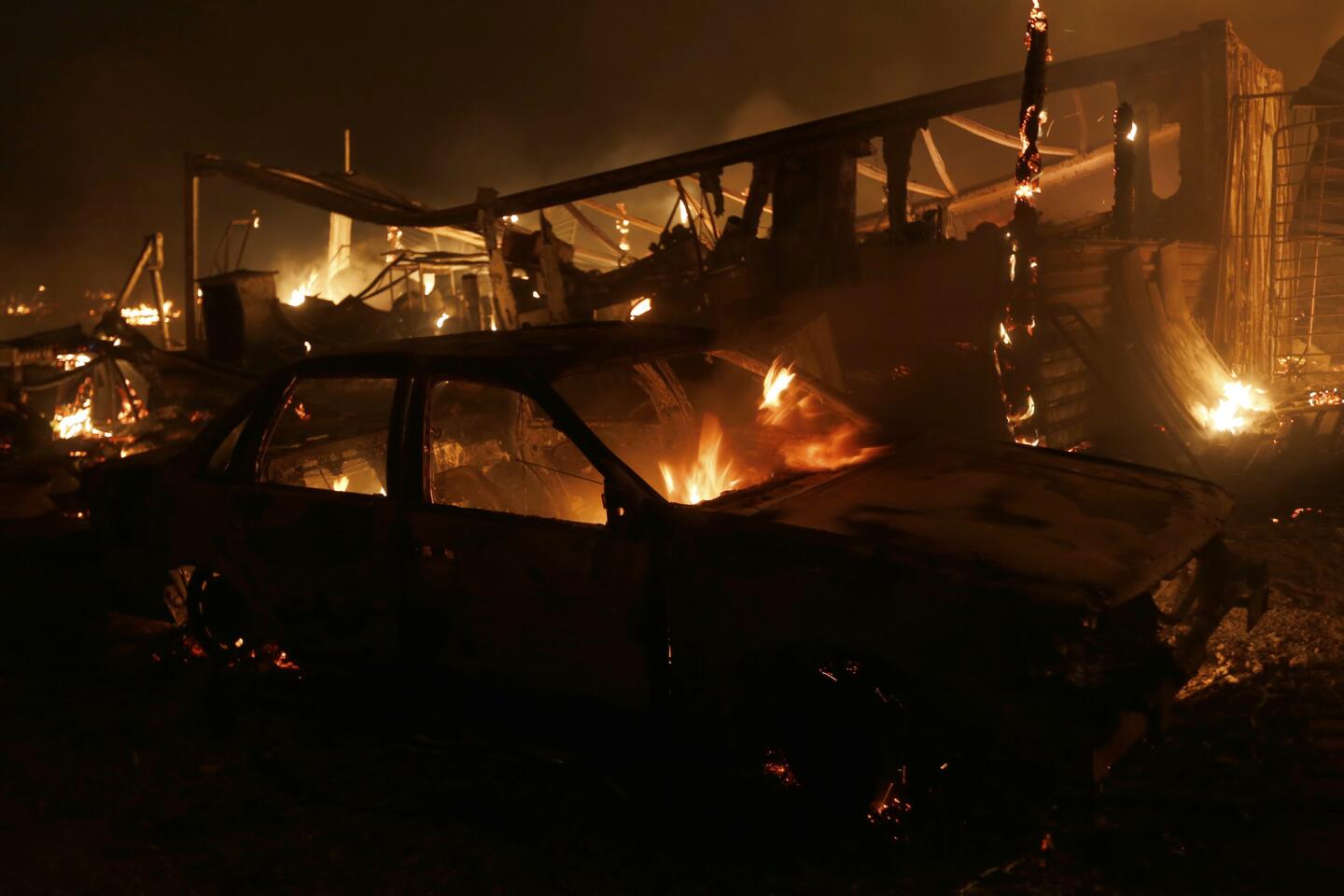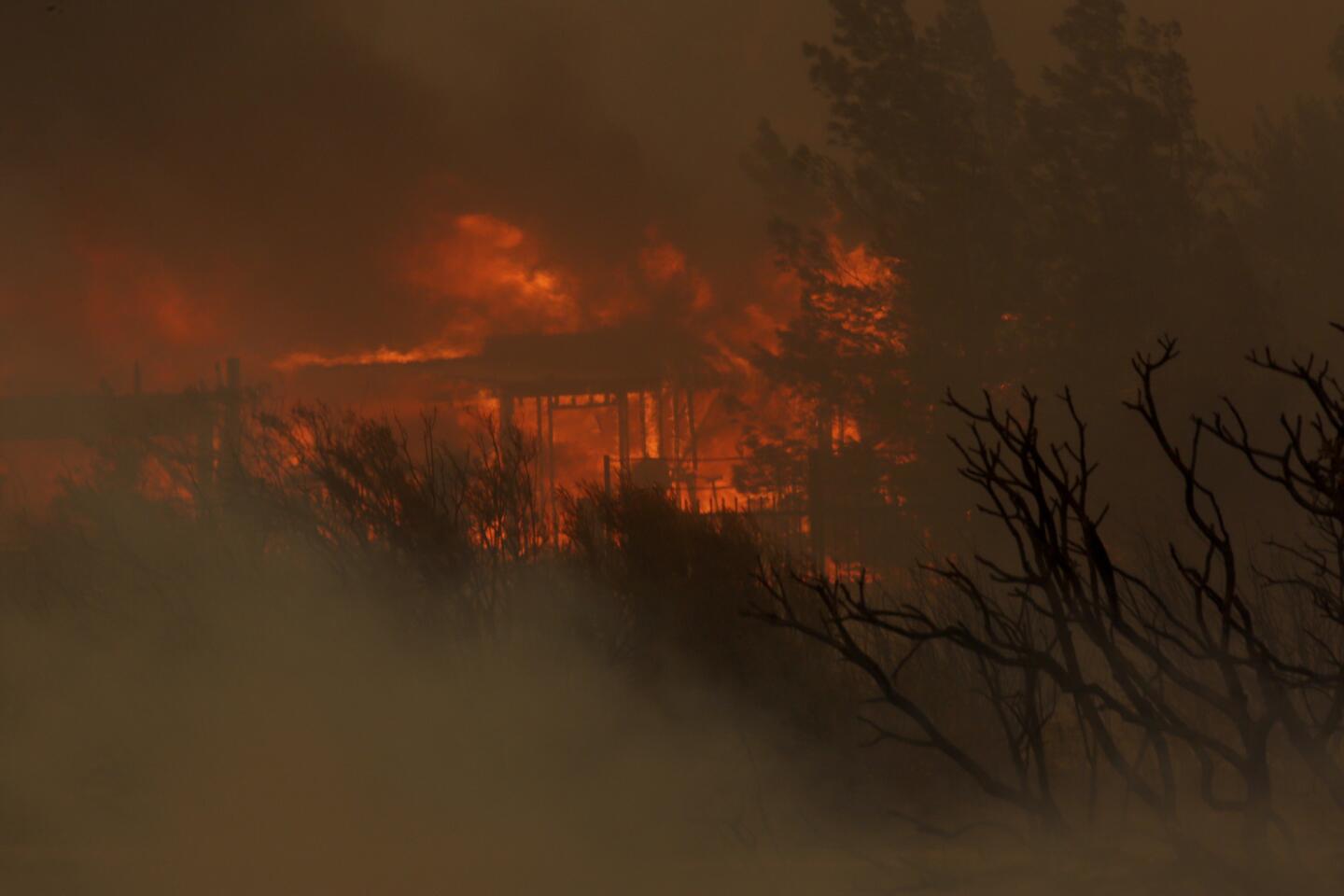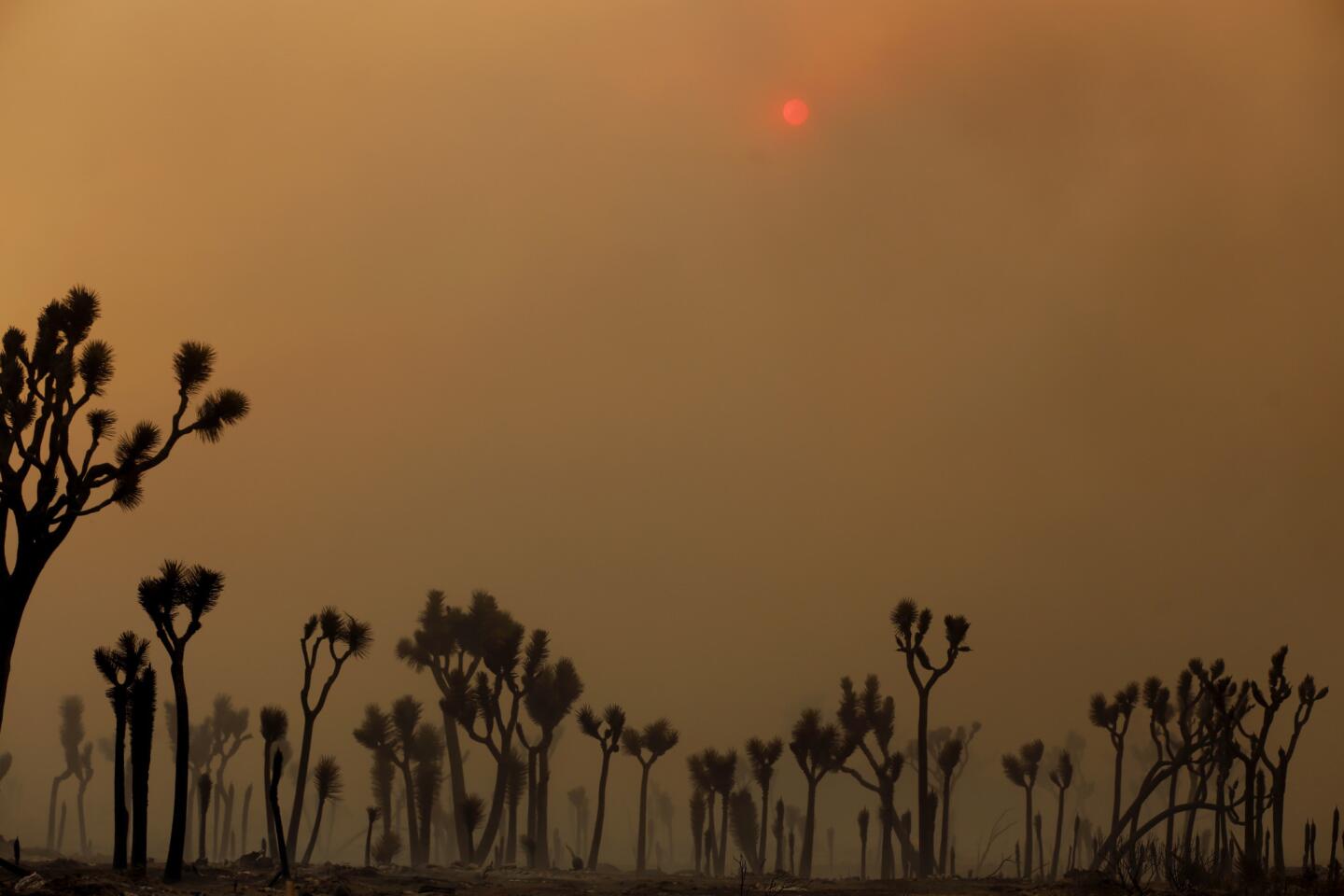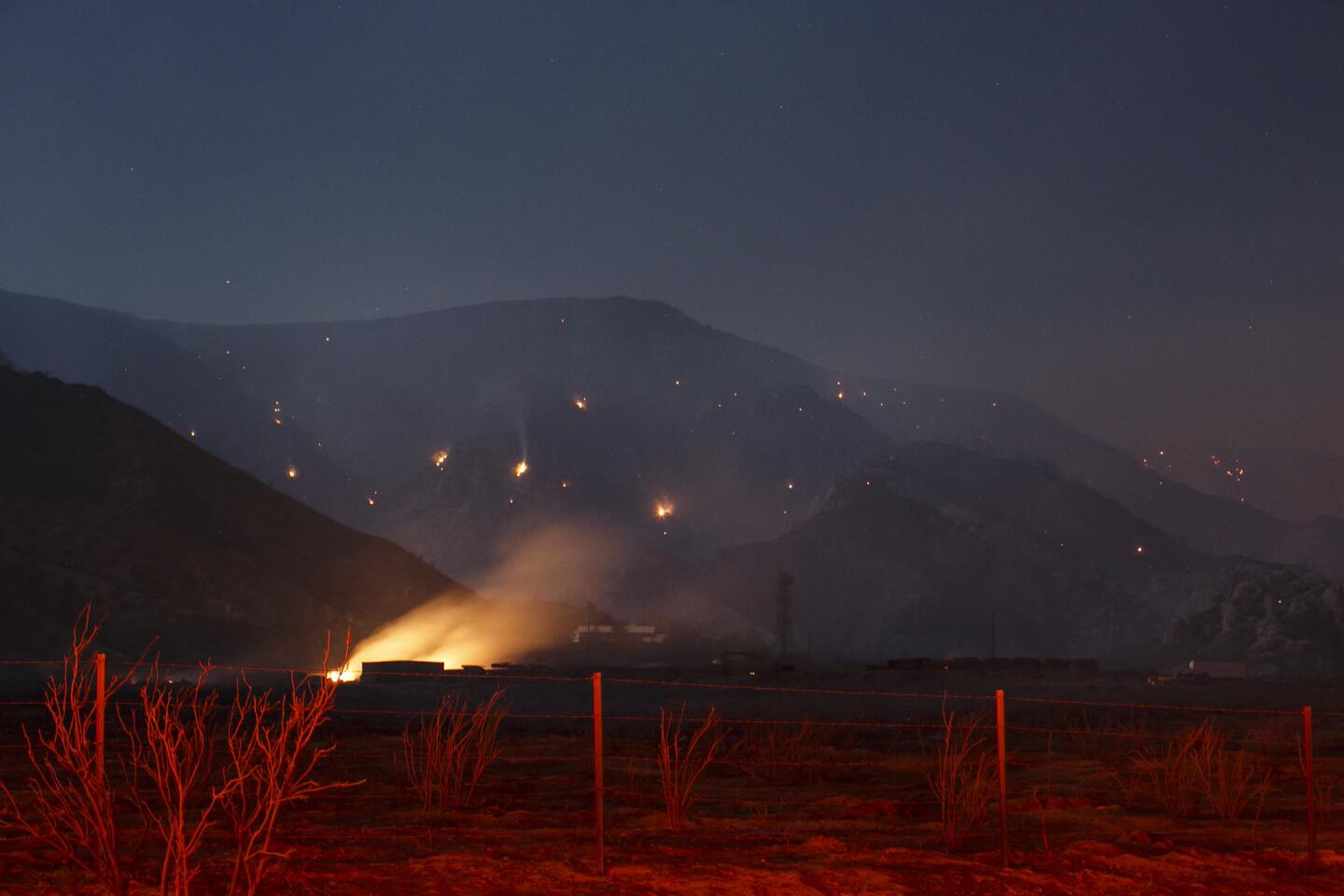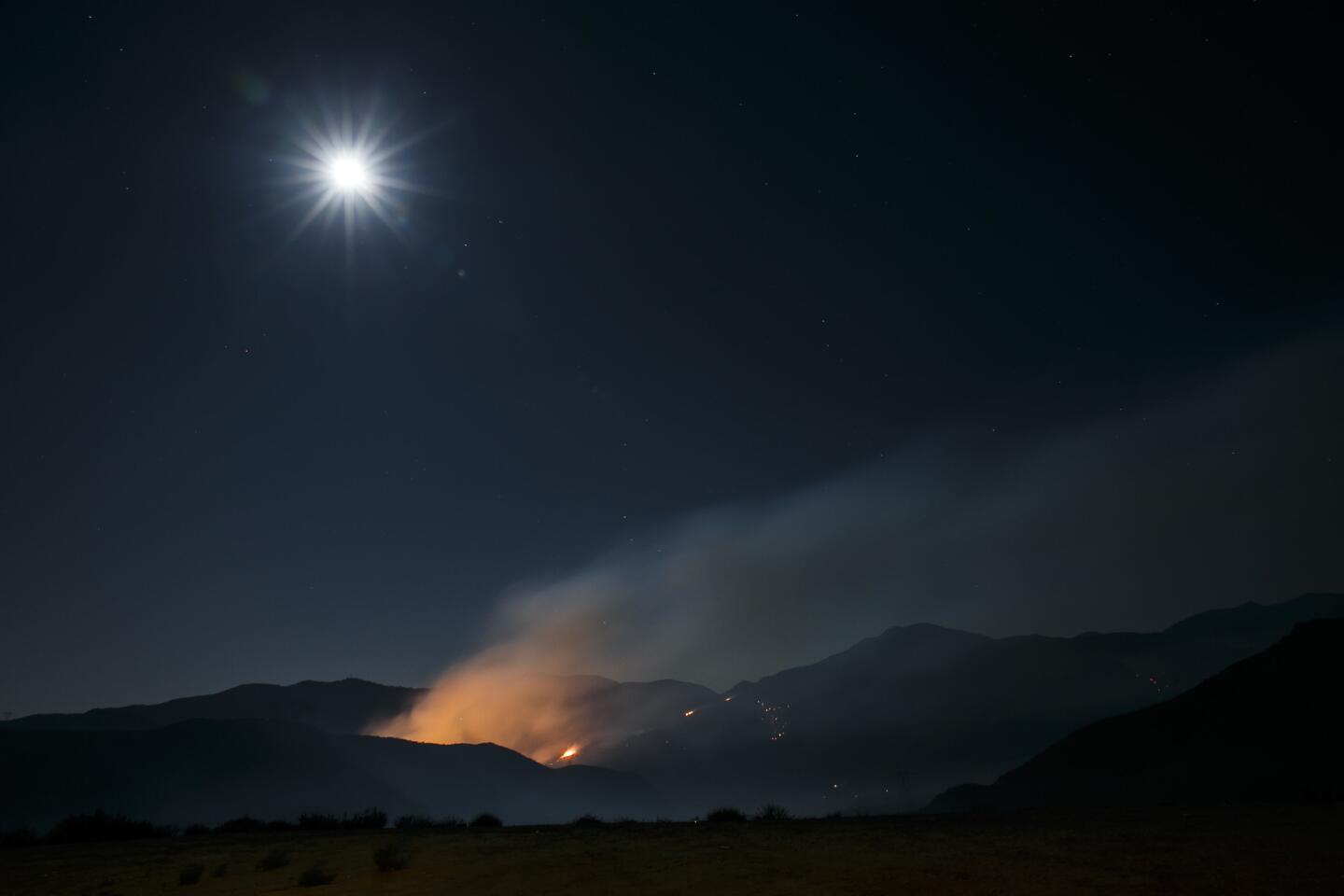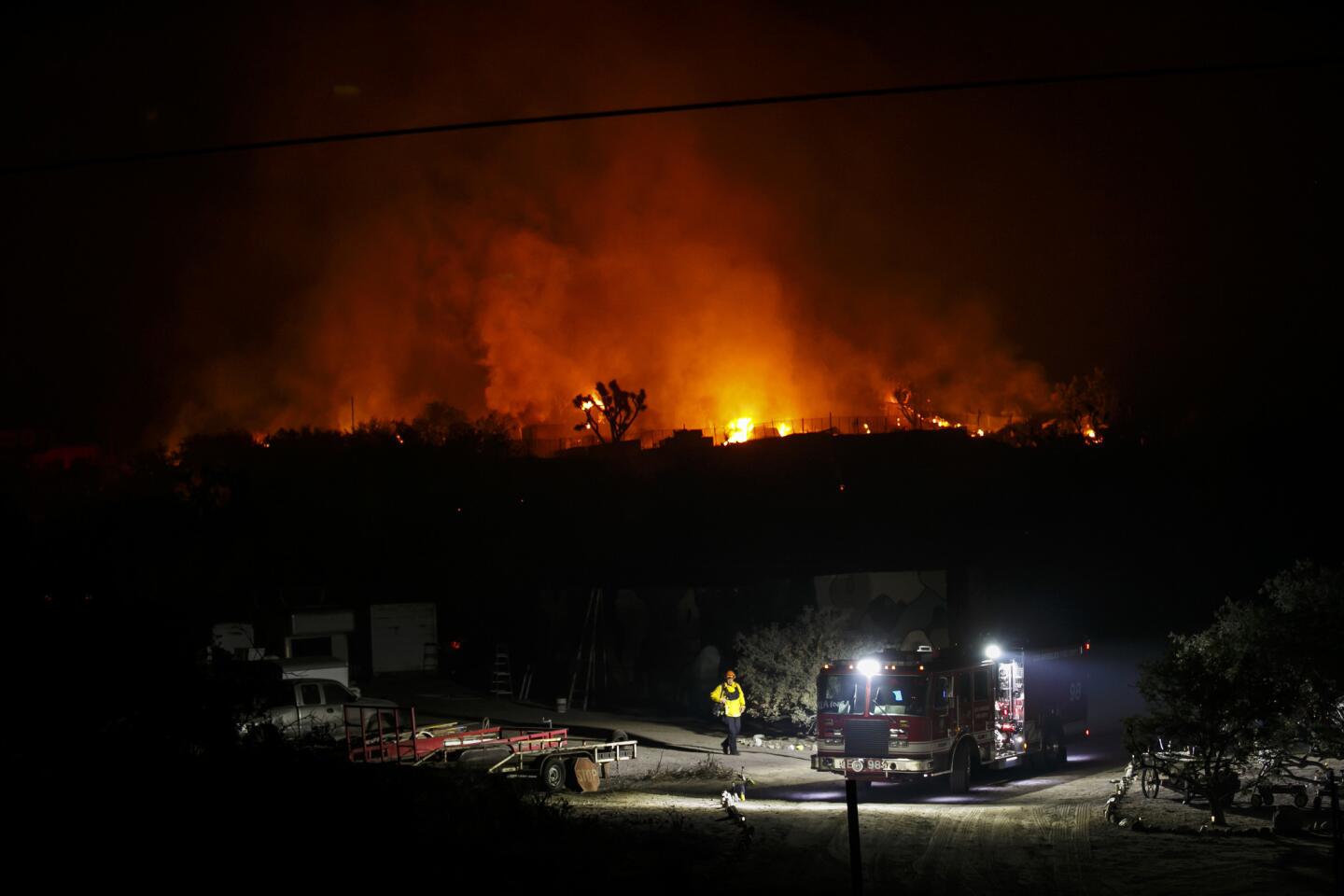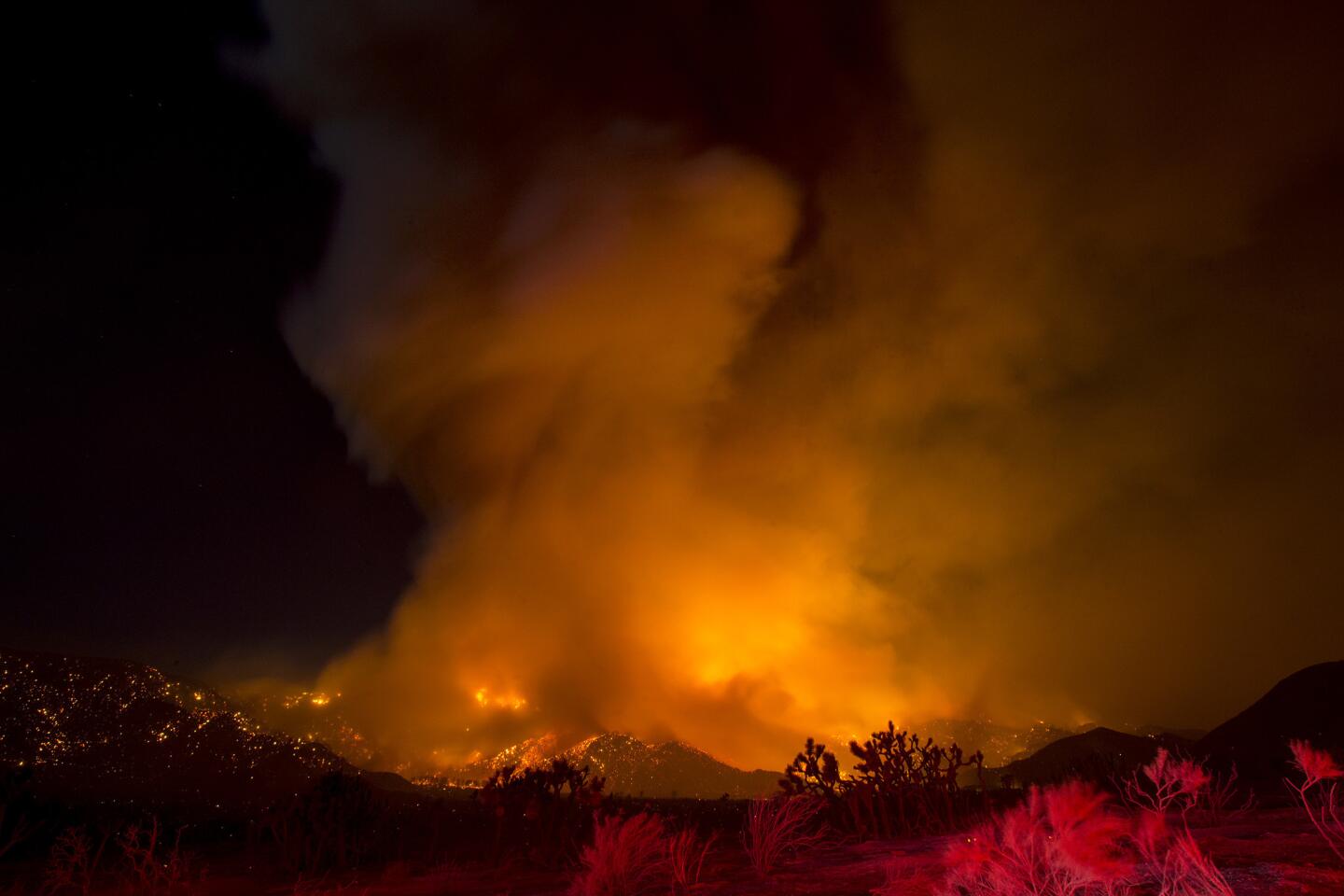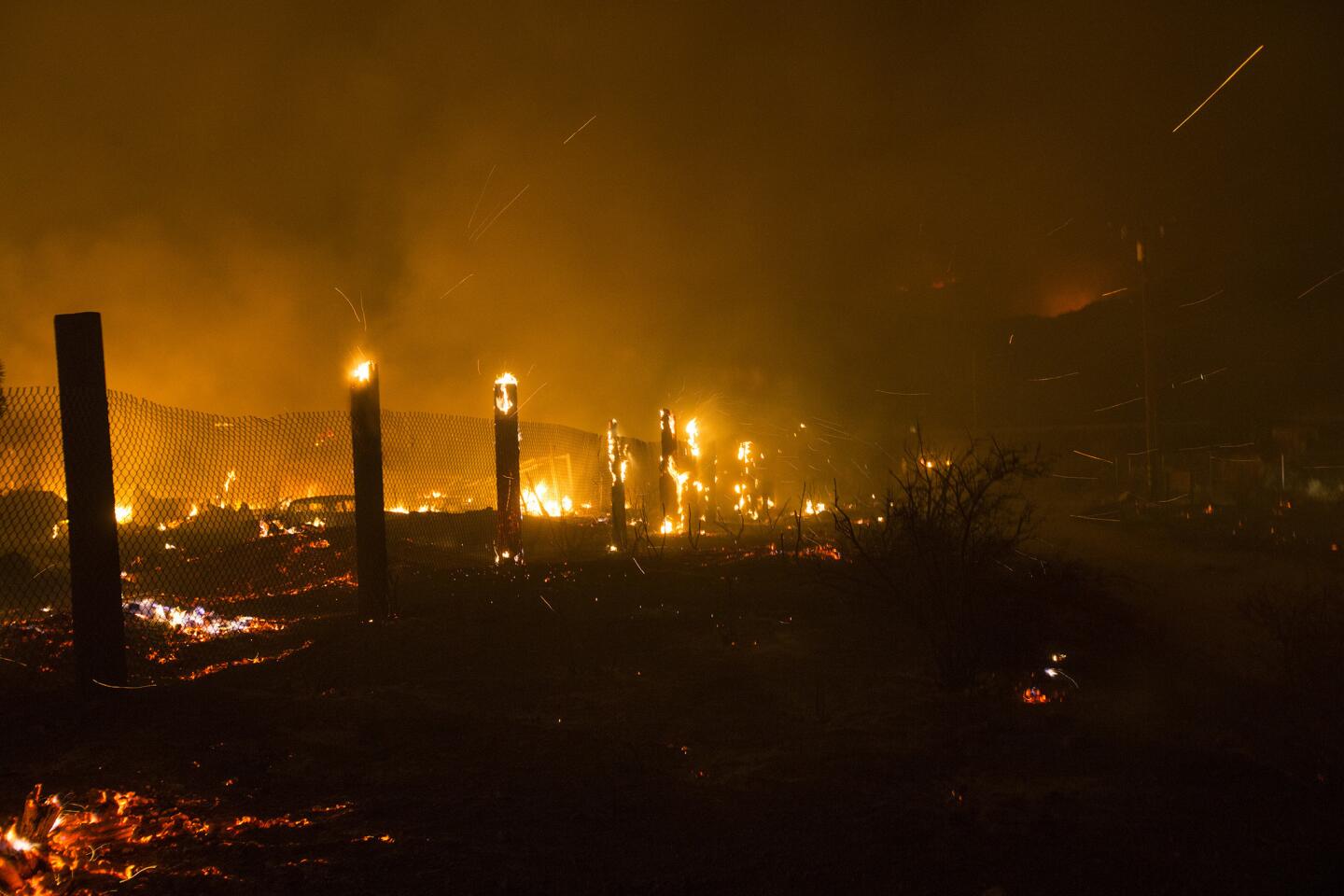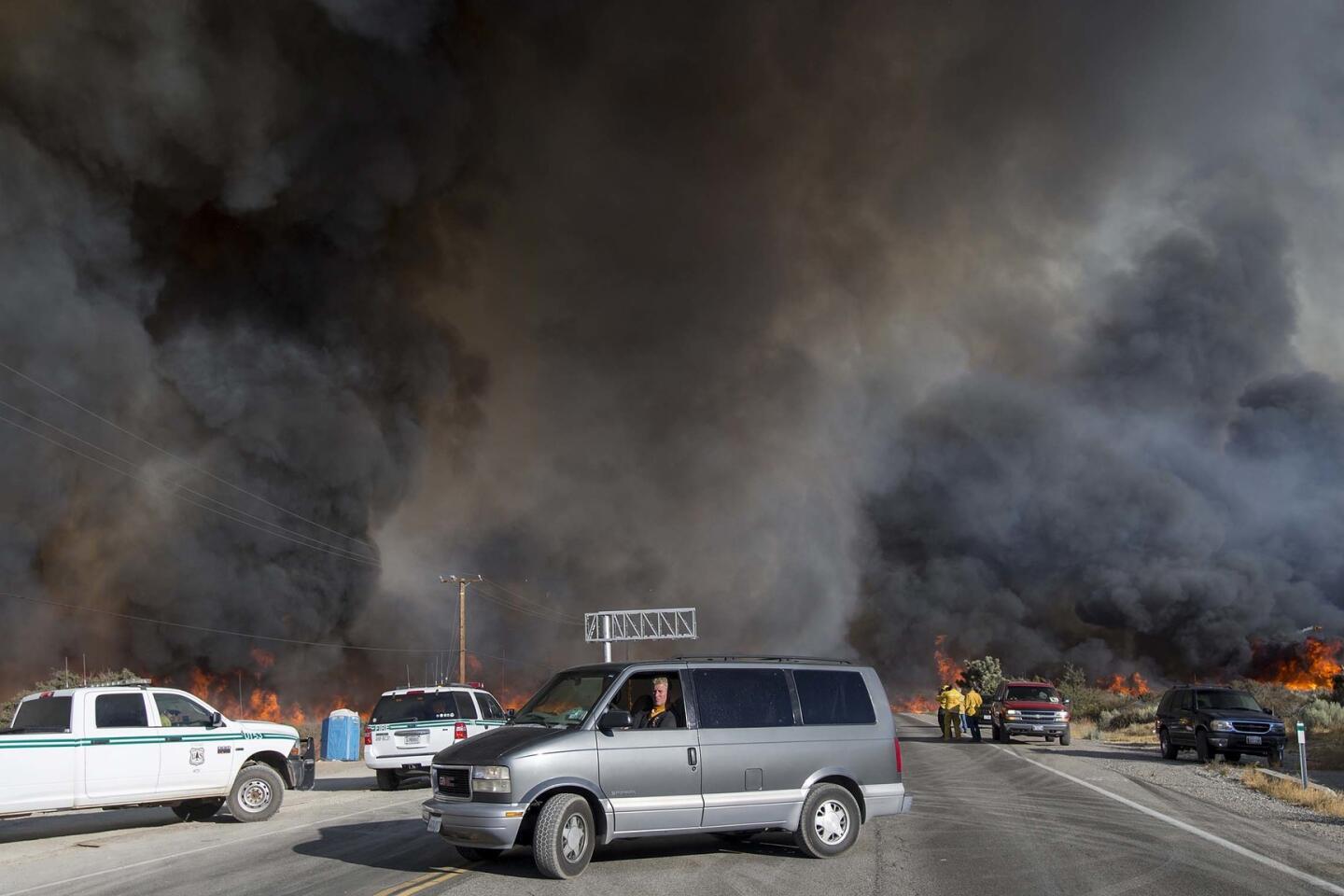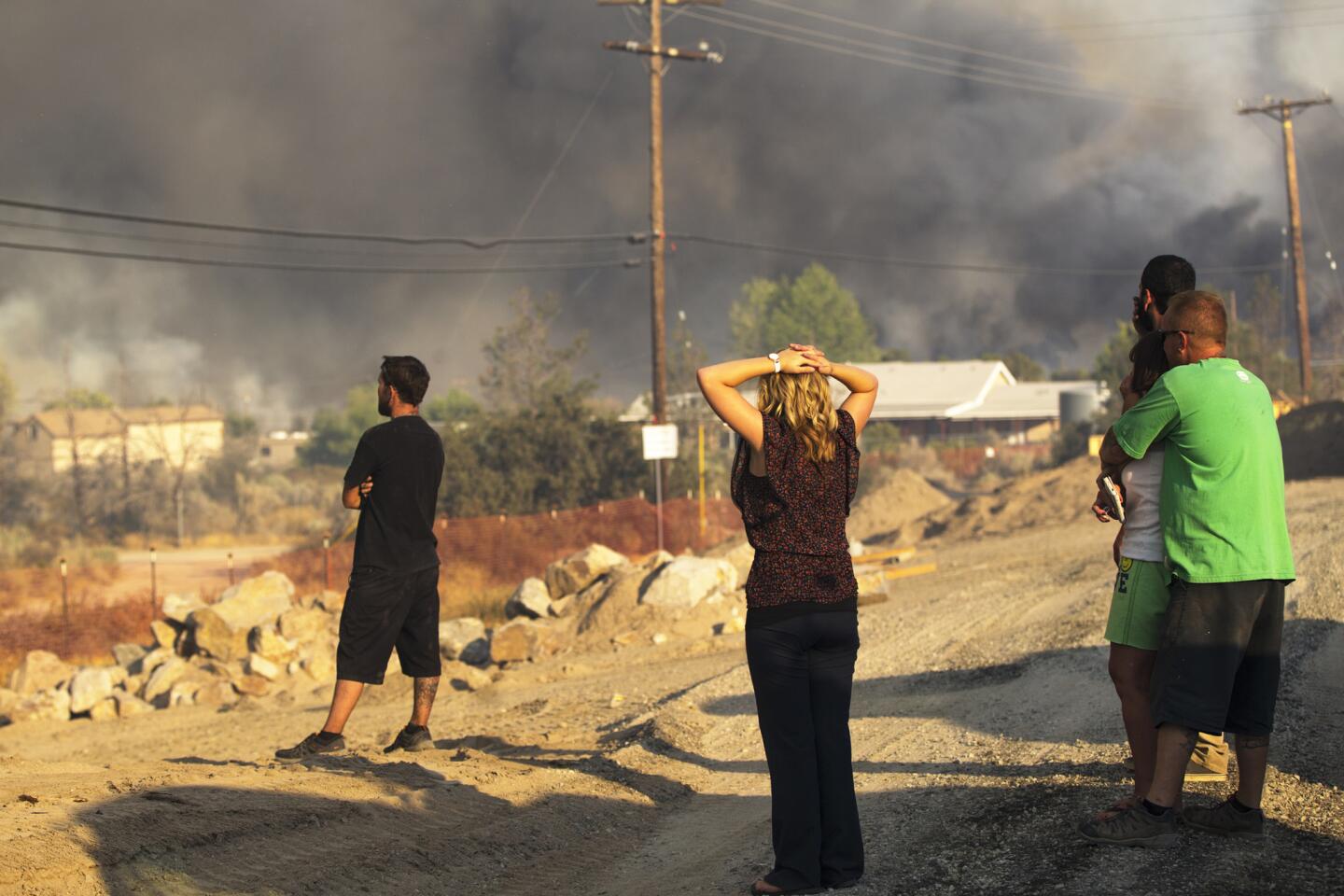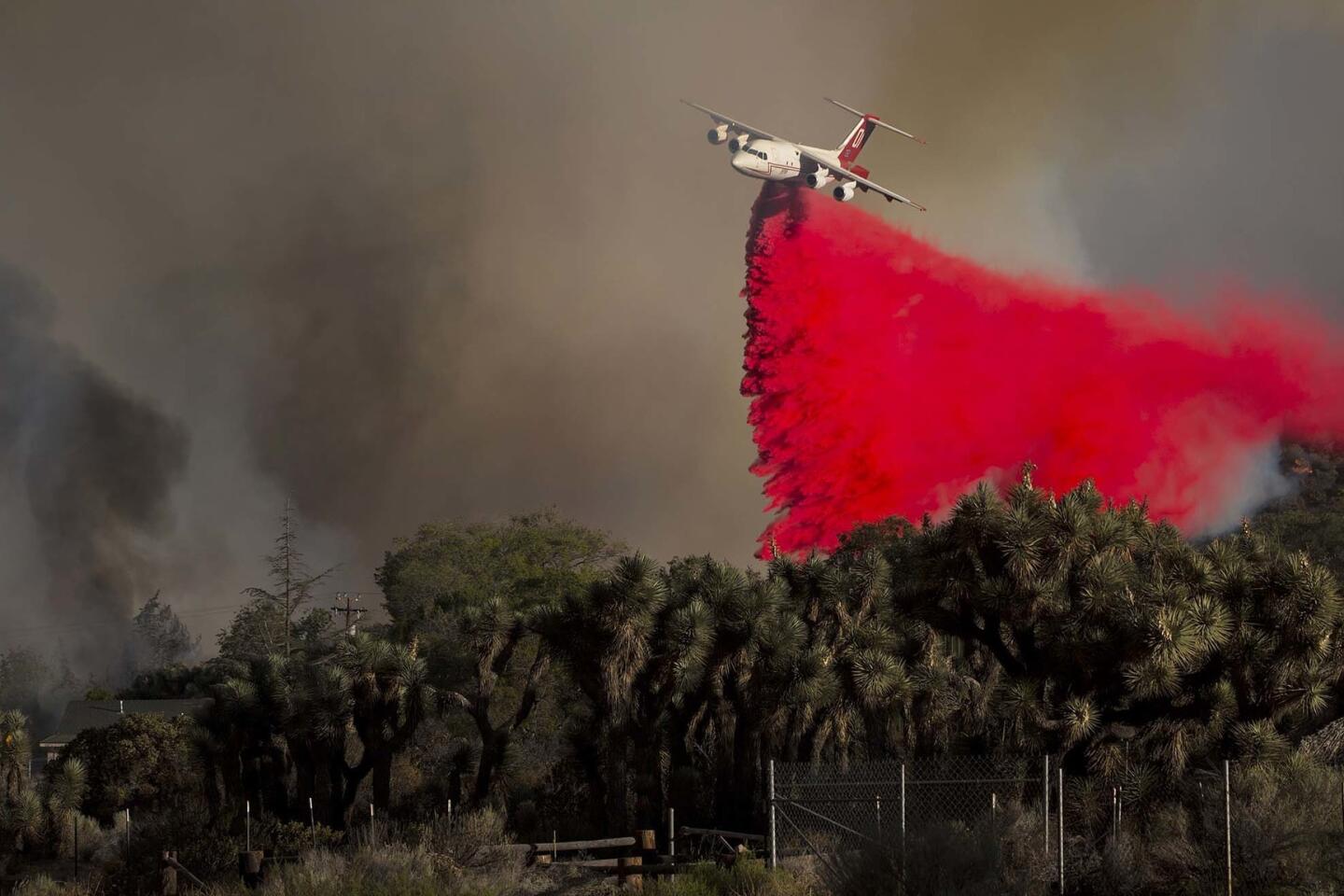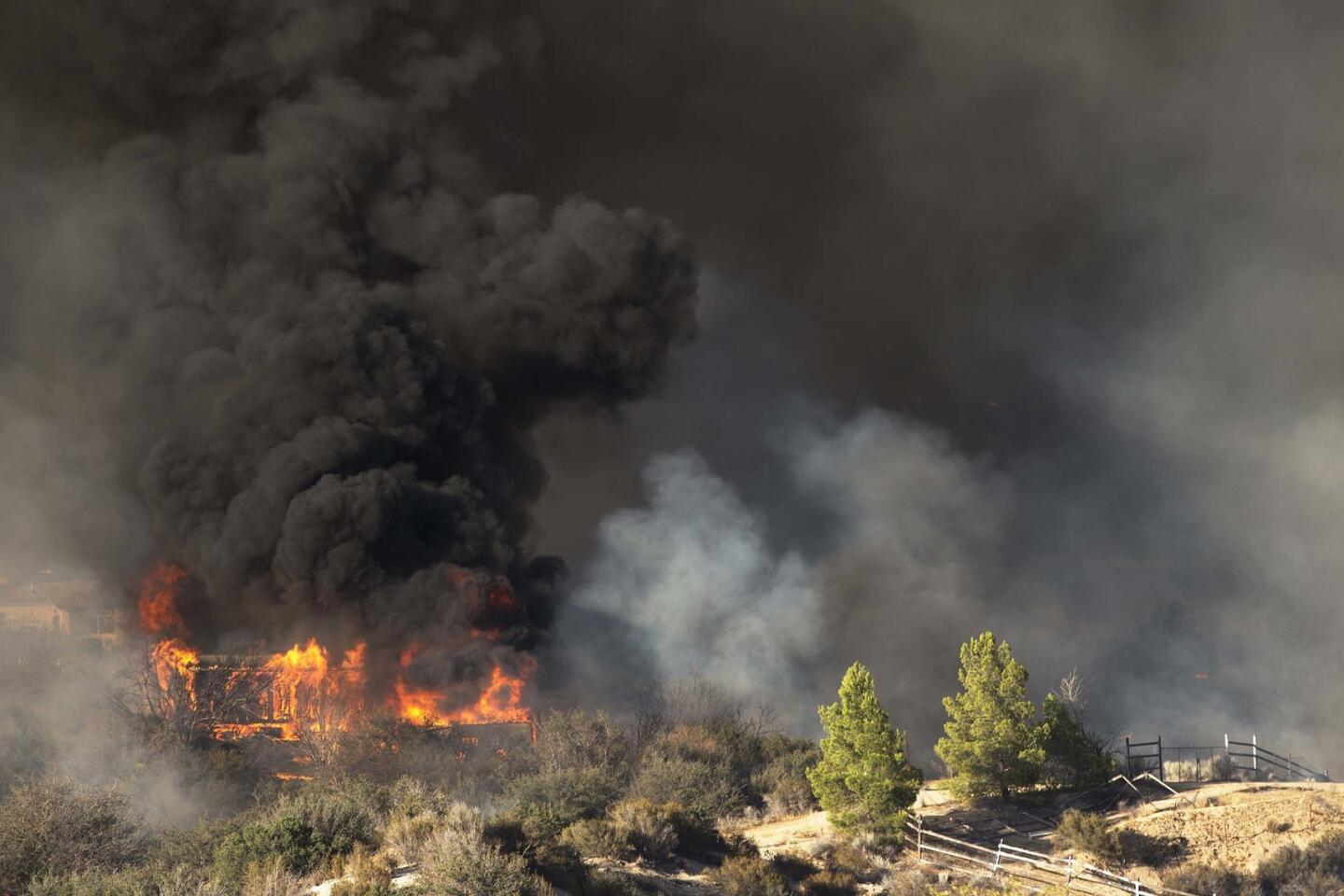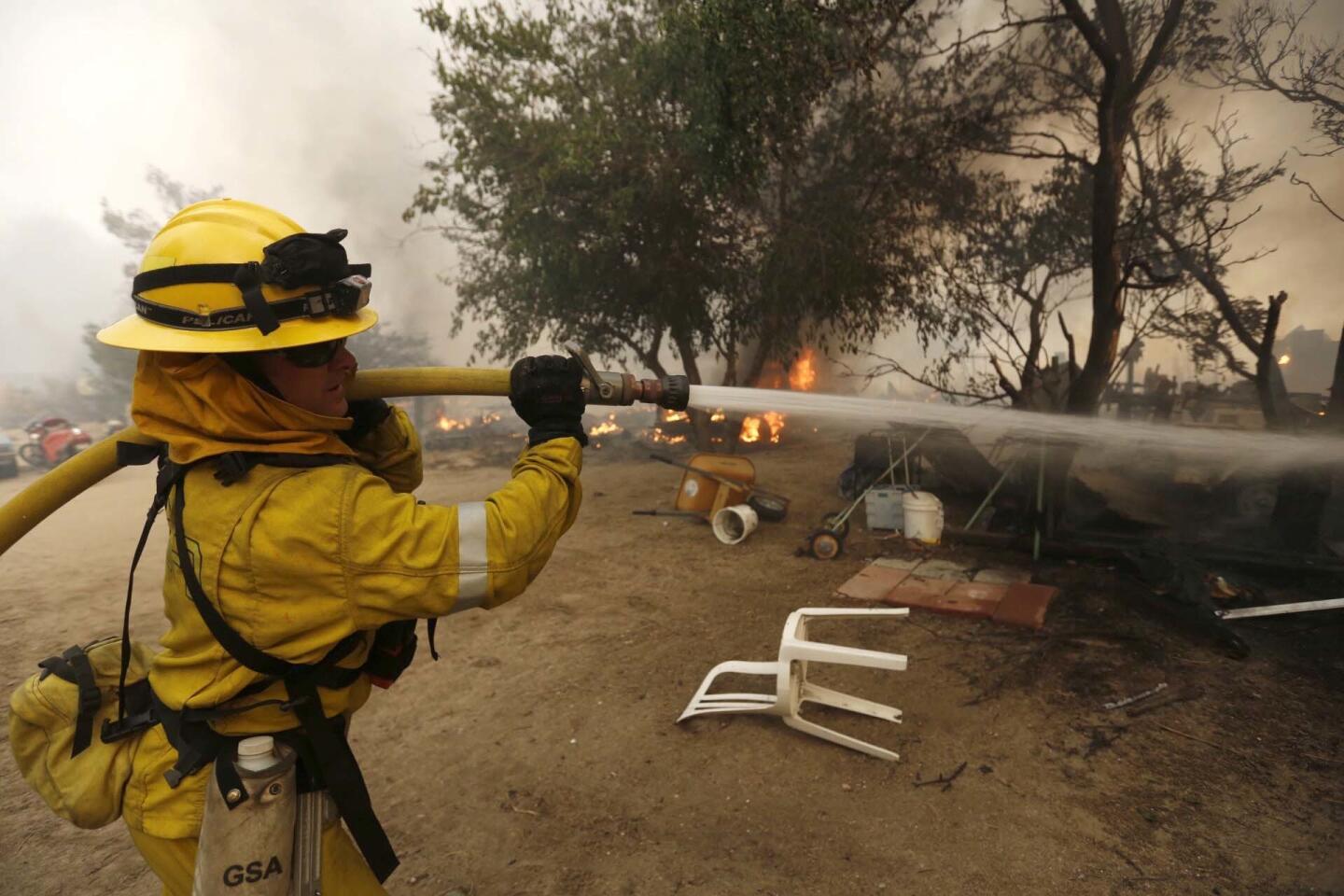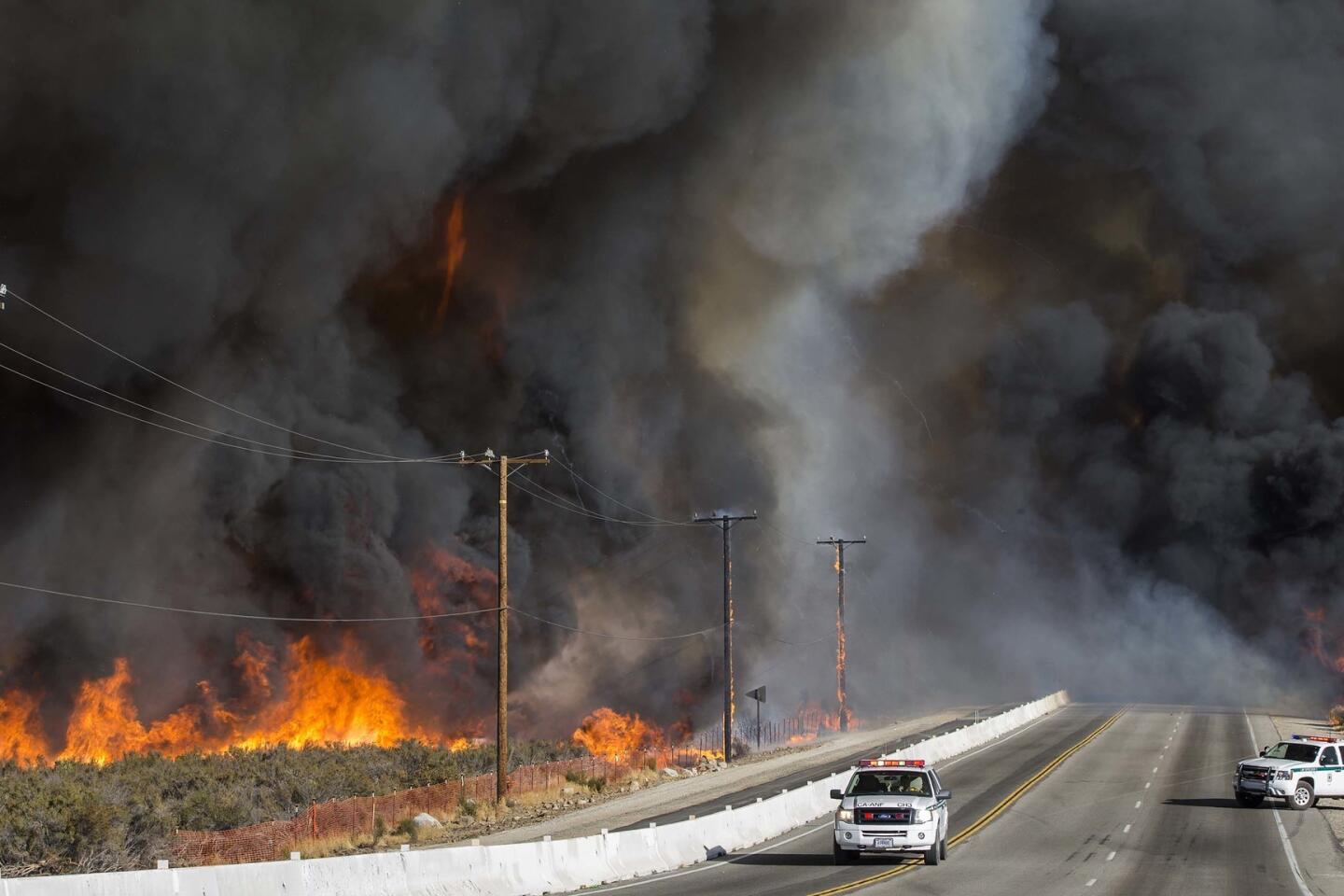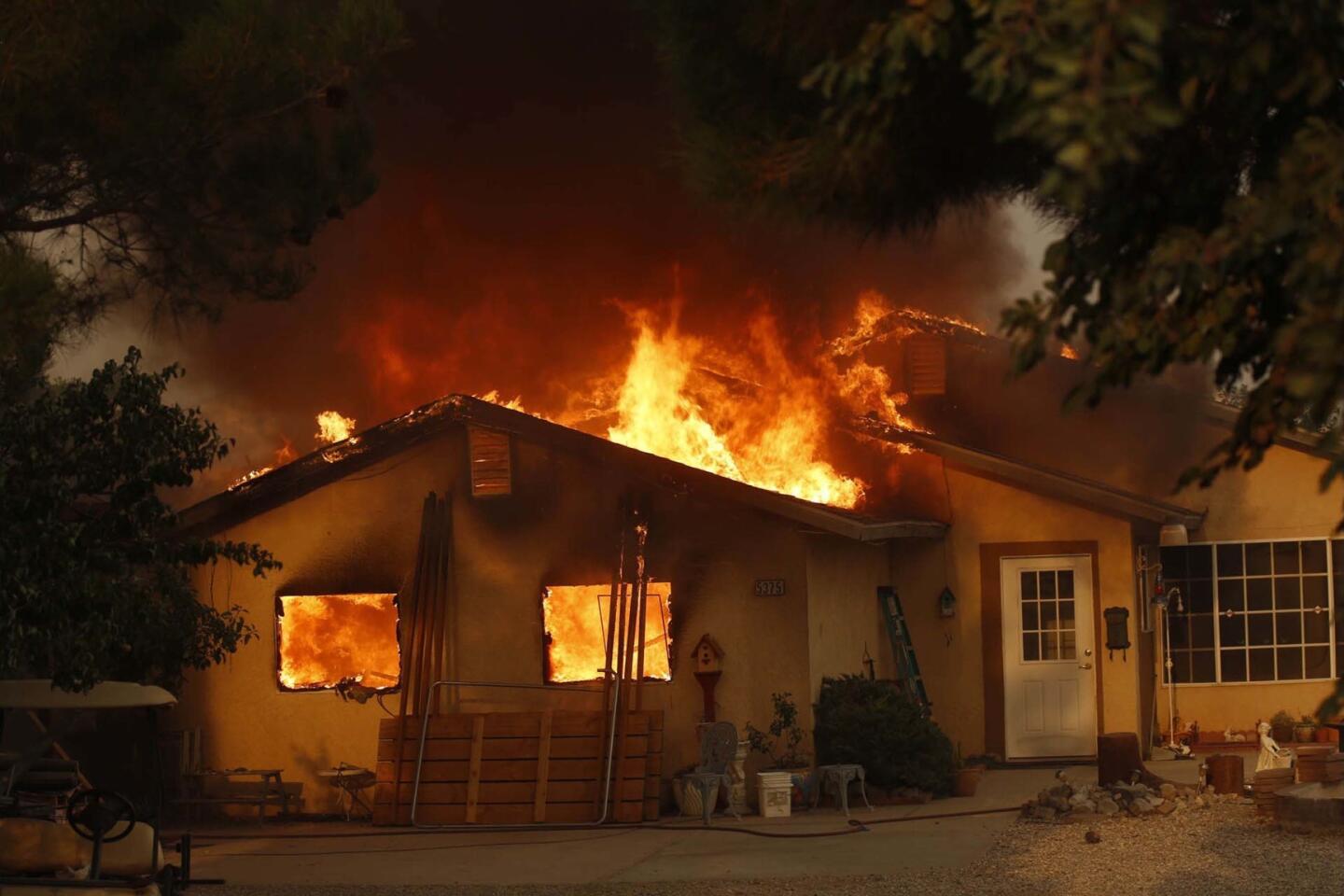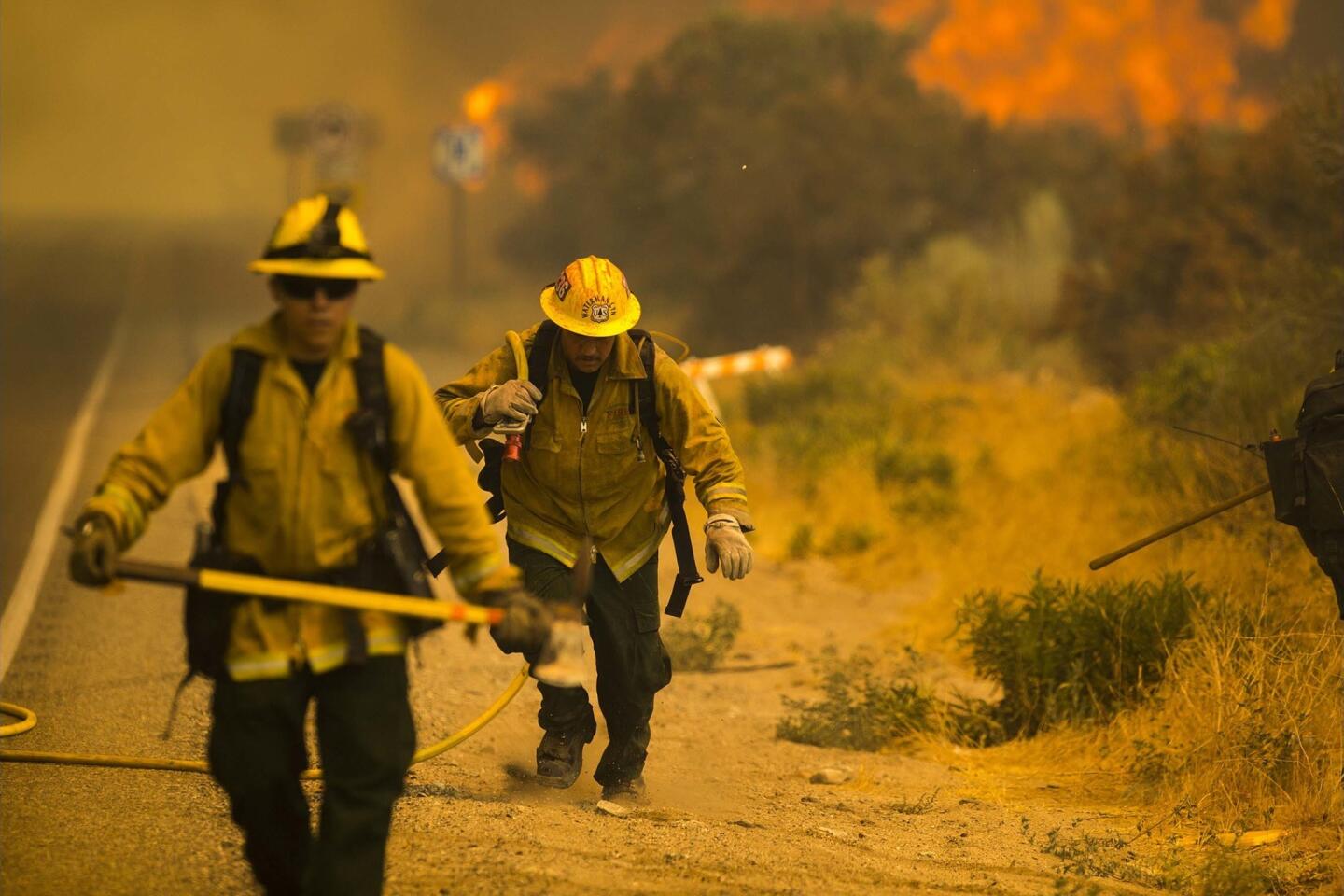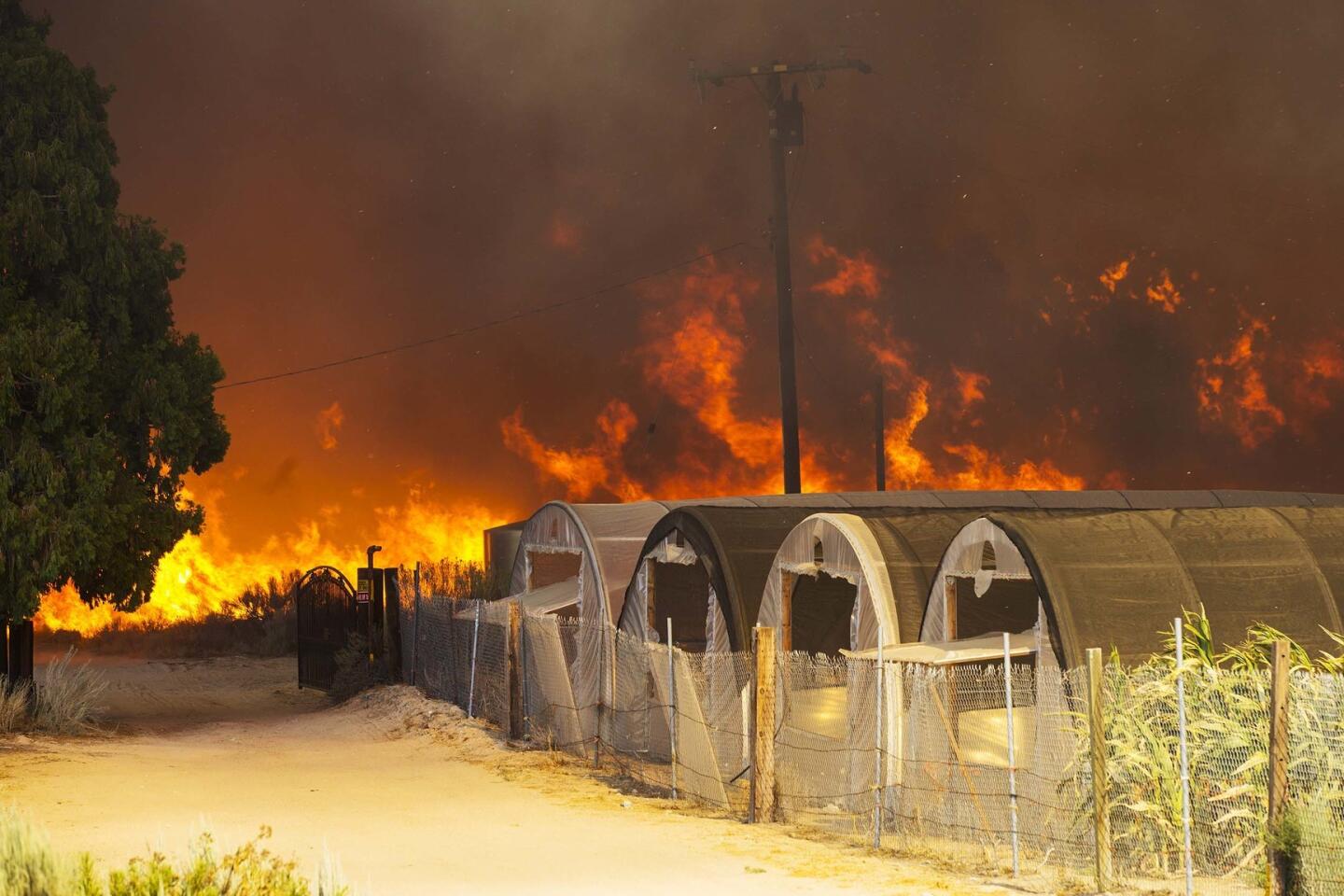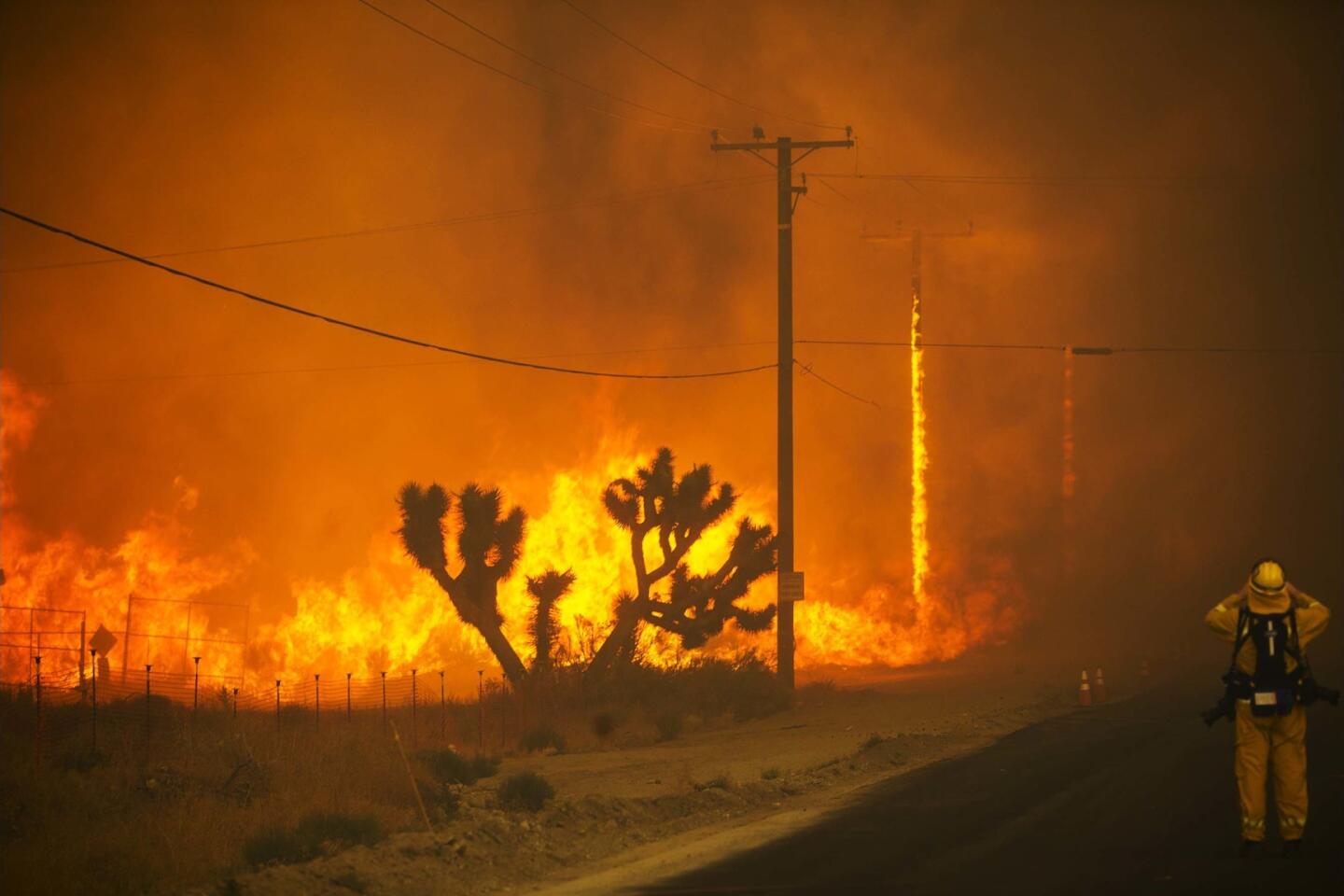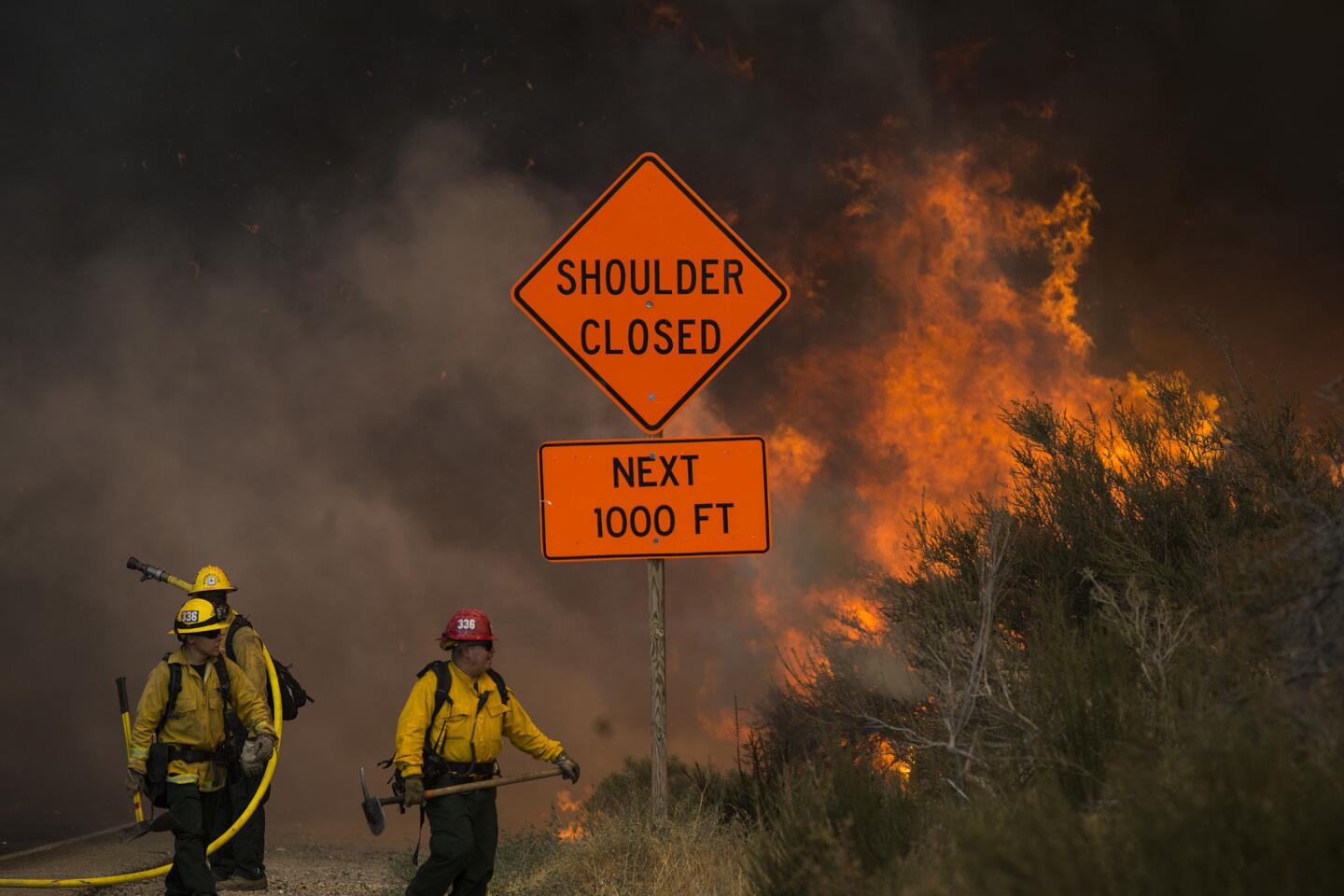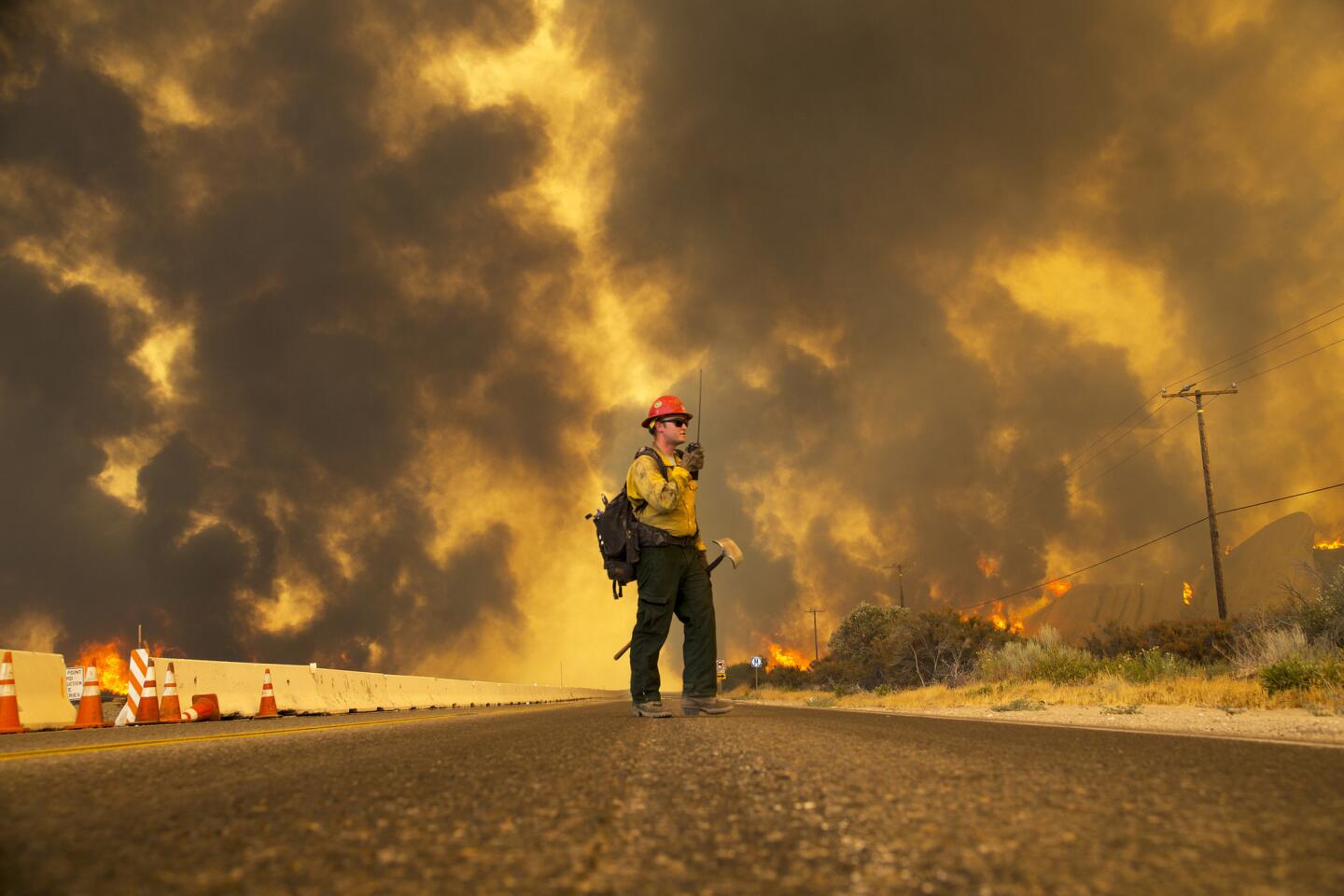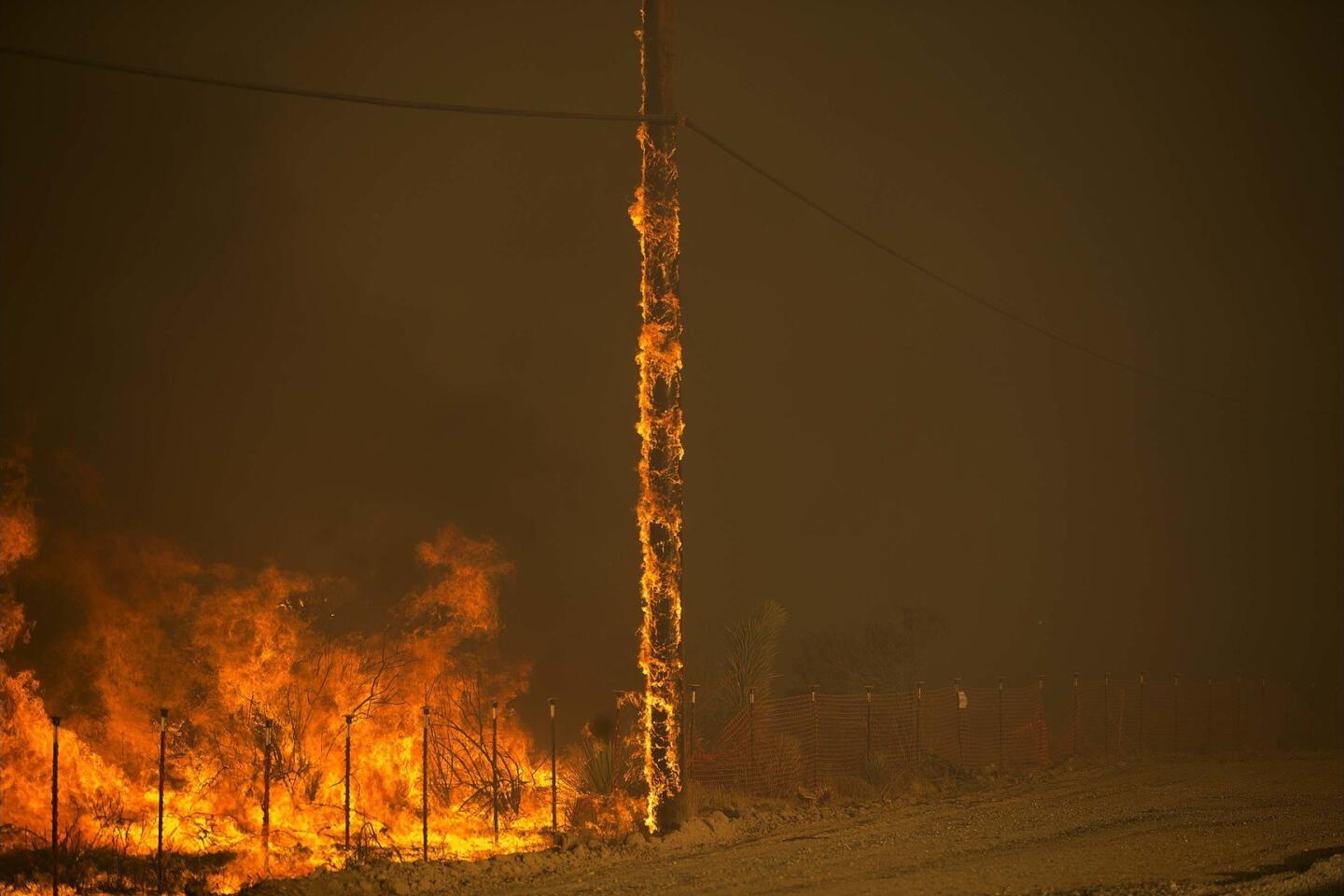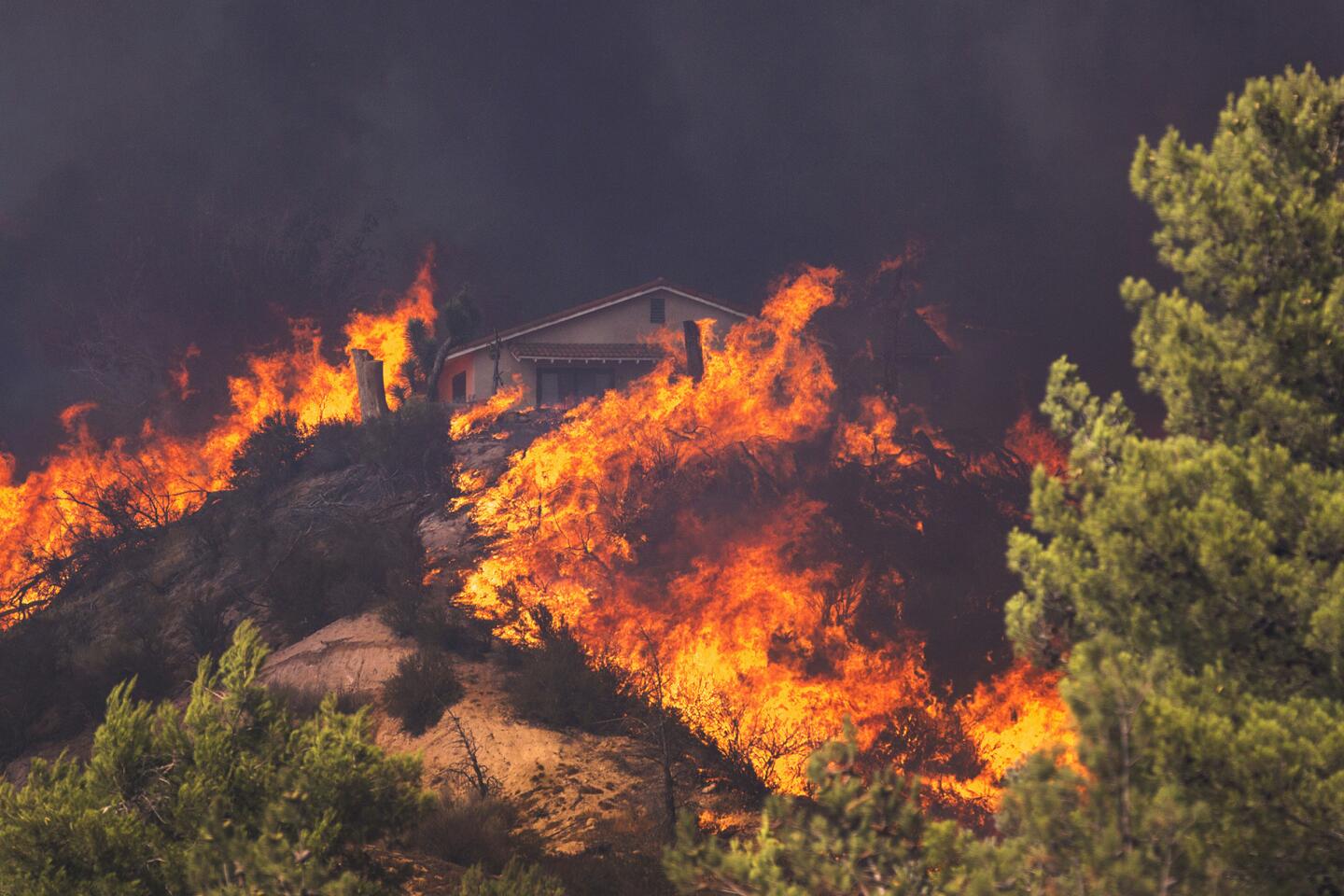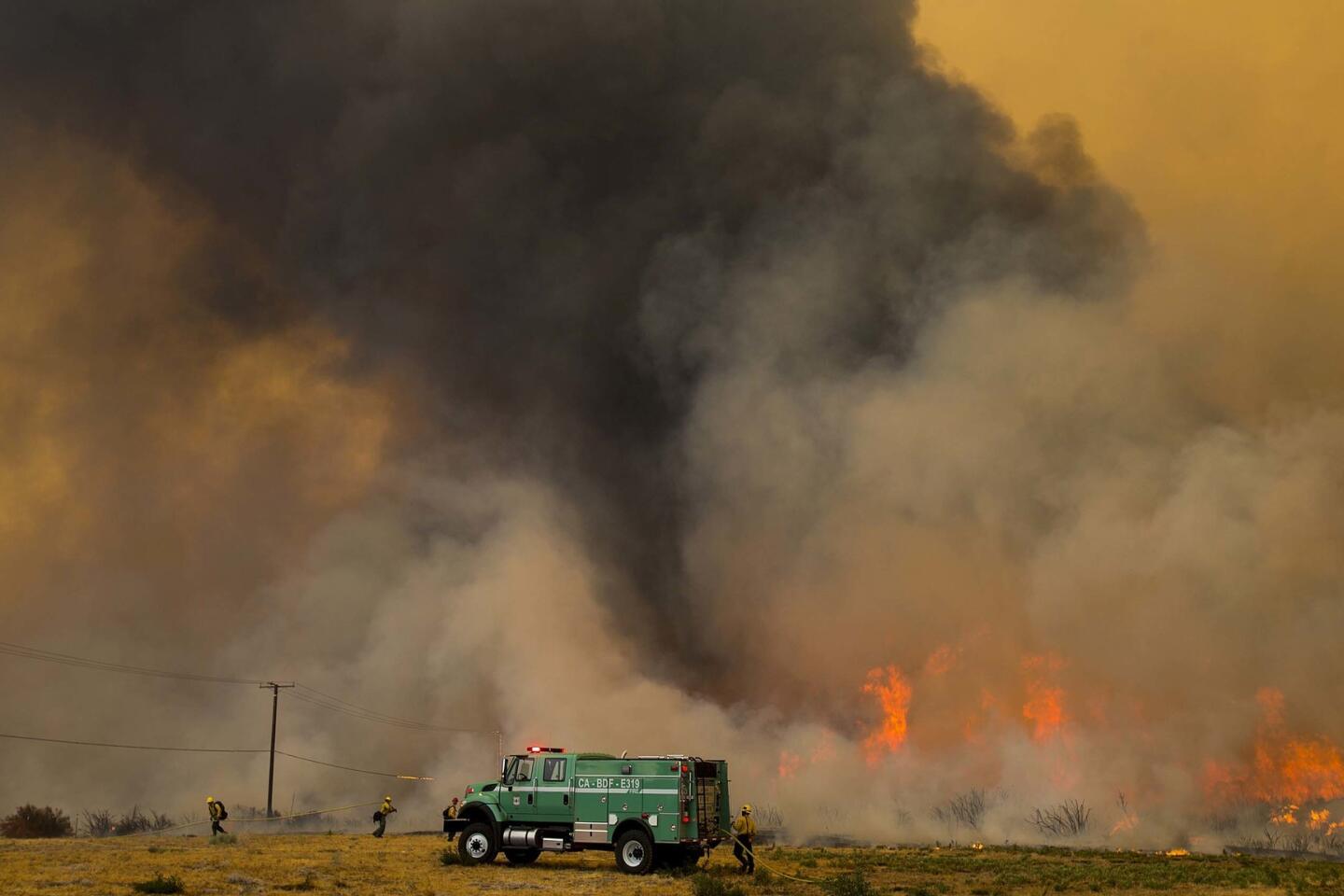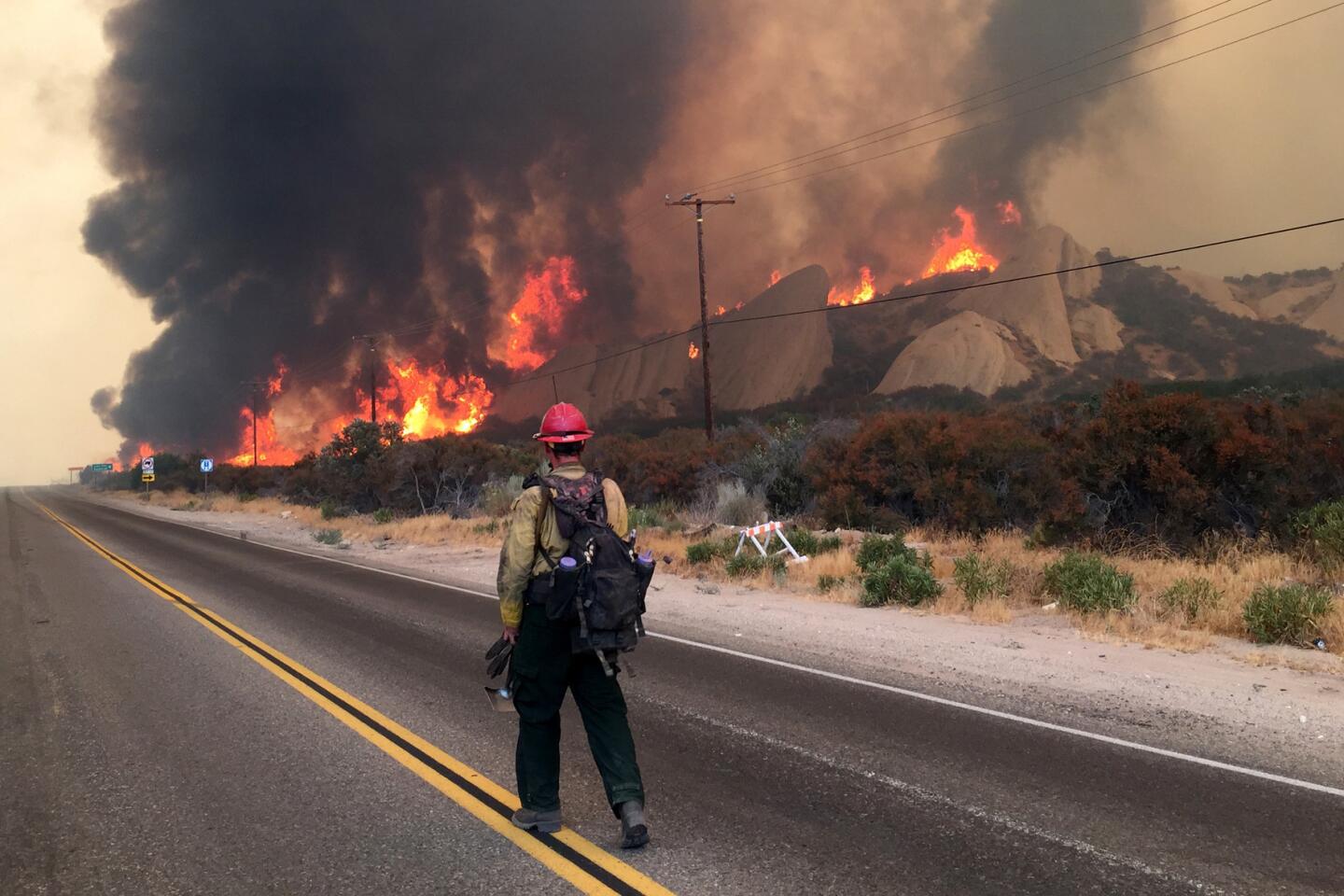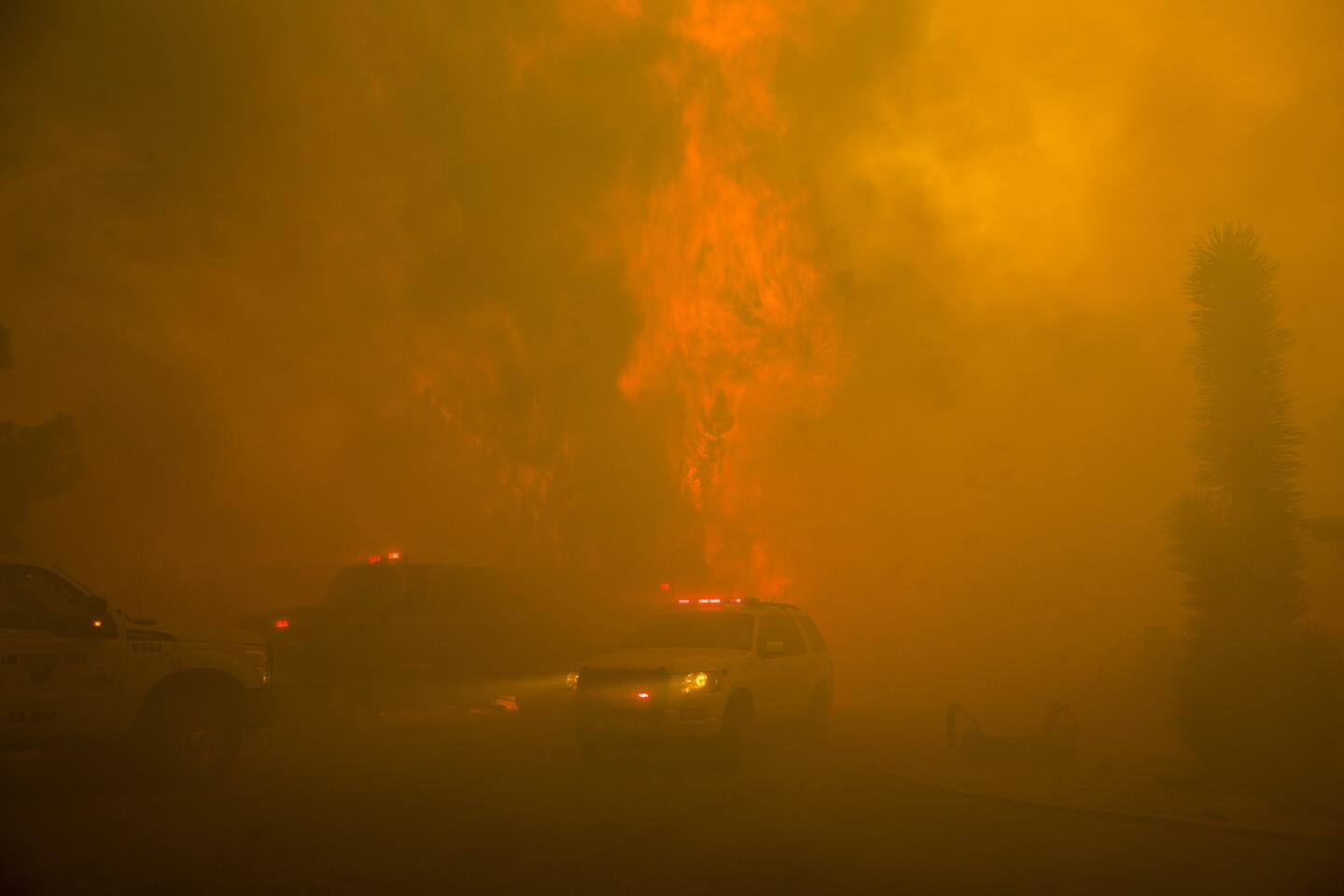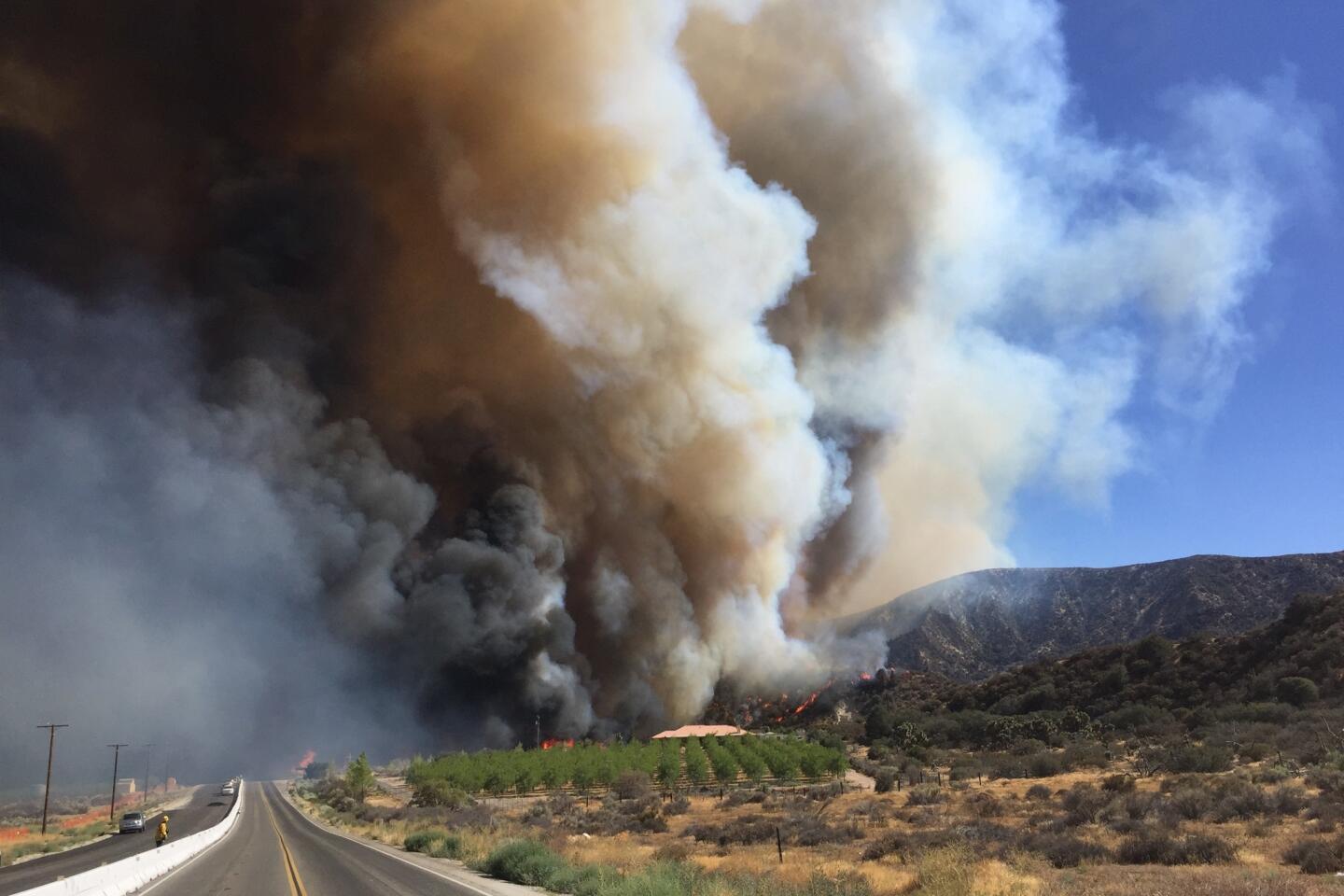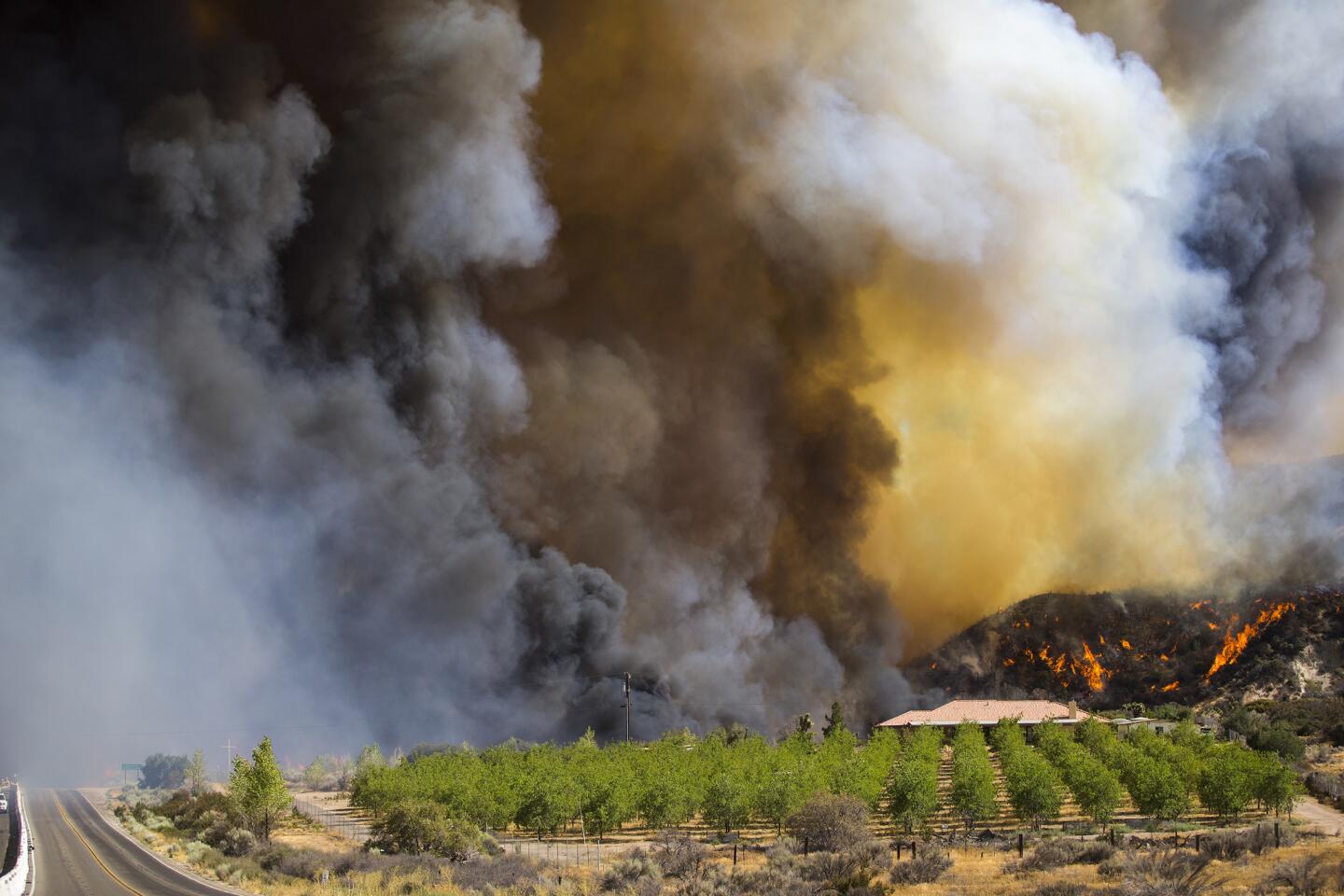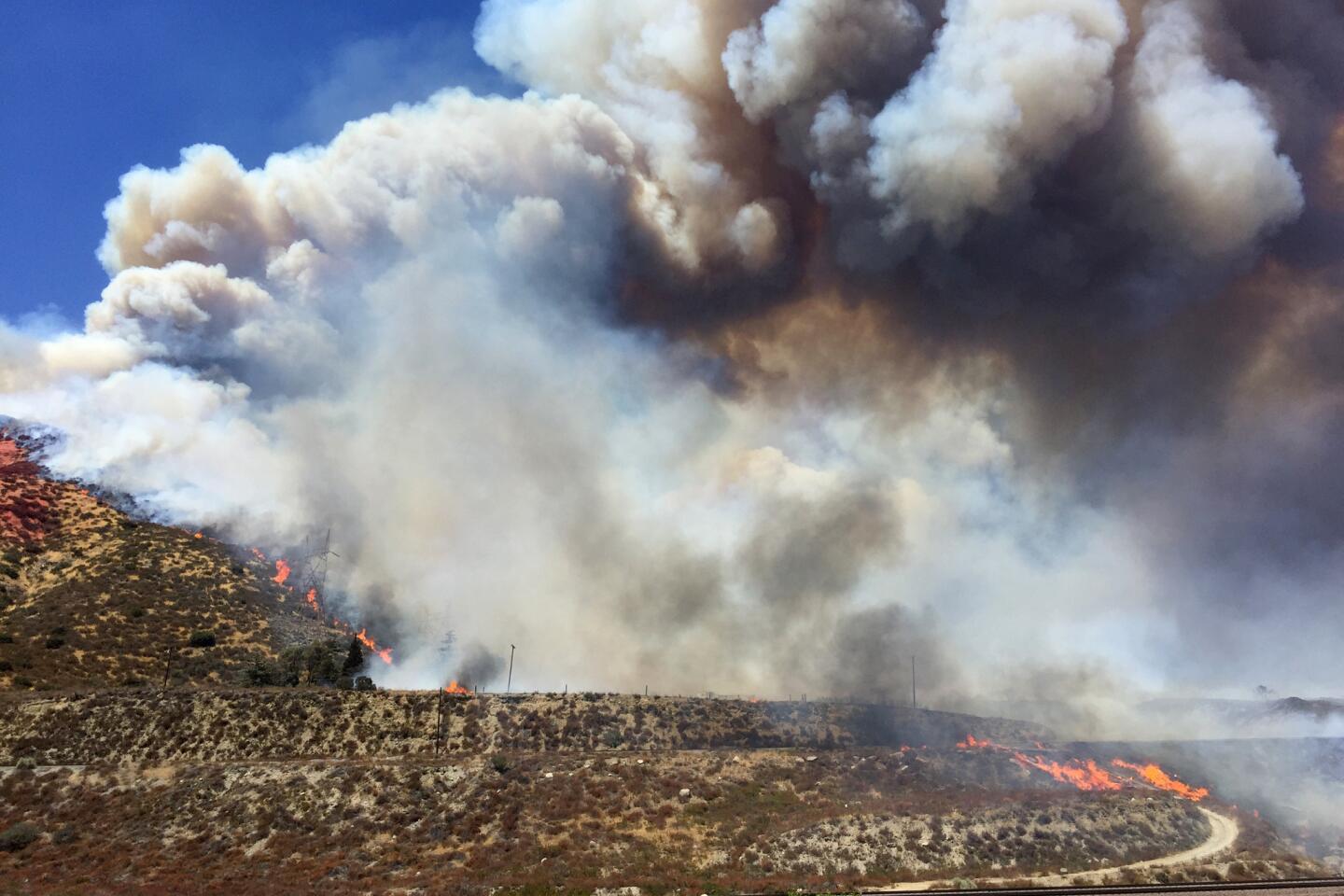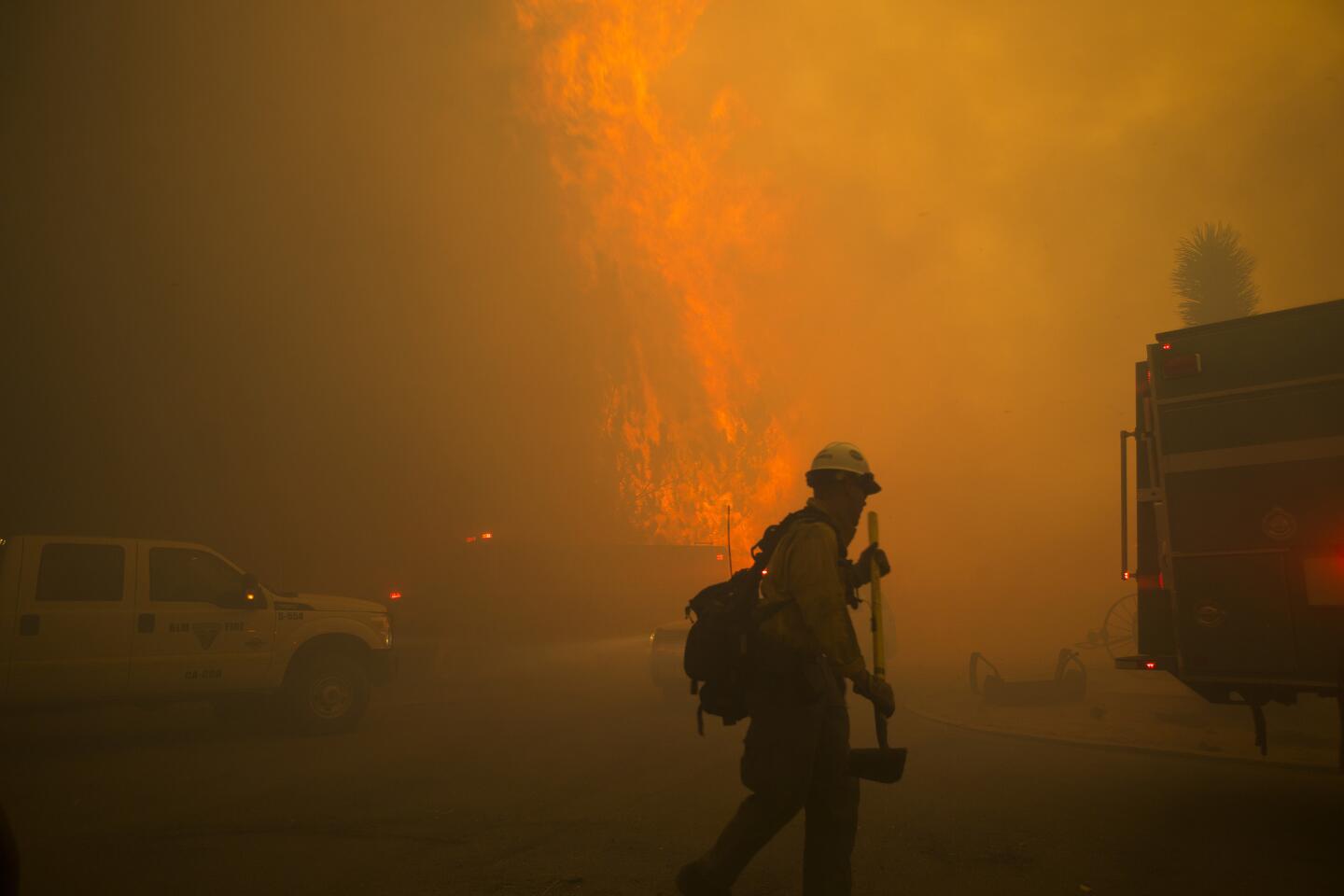Reporting from Pinon Hills, Calif. — Trucks and SUVs hurtled out of the canyons in clouds of dust, loaded to the headliners with keepsakes and valuables, towing ATVs and old Jeeps.
As if there weren’t enough smoke in the air, Leo Paguin took a drag from a cigarette and watched his neighbors flee.
“Those are the smart ones, I guess,” he said.
Paguin, 66, with a deep-creased desert face and grizzled gray beard, watched the black smoke rise from the mountains a mile away from his little house in Pinon Hills.
All day Wednesday, unstable winds twisted flames into fiery tornadoes as the Blue Cut fire tore through 30,000 acres of dry foothill and desert vegetation. Officials kept Interstate 15 — a major artery into Southern California — closed for more than a day and ordered an estimated 80,000 people to evacuate.
But many, like Paguin, refused to go, much to fire officials’ chagrin.
Lynne Tolmachoff, a spokeswoman for the California Department of Forestry and Fire Protection, warned that people misjudge how suddenly fires can be upon them, leaving no time or route to escape.
“The way the fires are moving in this drought-stricken state, they are more explosive, and they move much quicker through the dry vegetation. So the danger is increased,” Tolmachoff said.
There is no doubt that residents who have ignored evacuation orders have saved homes, putting out smoldering embers with a garden hose or summoning firefighters to a burning house. But the risk is extreme. And firefighters may have to risk their lives to save those trapped in a conflagration.
Even the slightest hesitation with deciding whether to evacuate can mean the difference between life and death.
“People that evacuate late in a fire when the fire is reaching them are the most vulnerable to being killed,” said Scott Stephens, a professor of fire science at UC Berkeley. “Most people underestimate the fury that comes.”
People here in the high, wind-raked valleys cleaved by the San Andreas fault can be a stubborn, independent sort. And living in the scrublands, they have dealt with fire before.
They take into account what authorities tell them to do, but can smell a whiff of overcautiousness as much as other people smell the smoke.
Paguin, who stays at the house as a handyman, said he’d stay to put out any spot fires from wind-borne embers that can reach far beyond the flame front.
“There is no way I’m leaving this place without trying as hard as I can to save it — I’d feel guilty the rest of my life,” he said. “I owe it to the property owner, who has personal treasures, collected over many years here. “
He held up a football-sized chunk of agate. “Things like this beautiful rock, pieces of petrified wood and a collection of old grammar school textbooks.”
He said he’d leave only if the flames were roaring through his chain-link fence.
“When it gets that close, I’ll fill a sack with my credit cards, my cold beers, some dog bones and a roll of toilet paper and start walking down Highway 138,” Paguin said.
1/88
About 10 buildings belonging to the Thanksgiving Korean Church were reduced to rubble by the Blue Cut fire.
(Irfan Khan / Los Angeles Times) 2/88
Miguel and Mabel Ramos, both 73, survey the devastation of the Blue Cut fire after it swept through their Oak Hills residence.
(Irfan Khan / Los Angeles Times) 3/88
Mabel Ramos, 73, is overcome by emotion upon seeing the devastation caused by the Blue Cut fire, which swept through her Oak Hills residence.
(Irfan Khan / Los Angeles Times) 4/88
Miguel Ramos holds a single chicken that survived after the Blue Cut fire swept through his Oak Hills property, burning the guest house and killing about 135 animals.
(Irfan Khan / Los Angeles Times) 5/88
A CalFire helicopter makes a water drop on still smoldering remnants of Blue Cut Fire on the hilltop ridges along Hwy 2 in Wrightwood.
(Irfan Khan / Los Angeles Times) 6/88
The Blue Cut fire continues to burn north of Lytle Creek in San Bernardino County.
(Marcus Yam / Los Angeles Times) 7/88
Ground crews put out errant fires that popped up near the train tracks in Keenbrook in San Bernardino County.
(Marcus Yam / Los Angeles Times) 8/88
A firefighting helicopter makes water drops to keep errant fires from approaching the train tracks near Interstate 15 at Keenbrook in San Bernardino County.
(Marcus Yam / Los Angeles Times) 9/88
Fire burns on the train tracks near Interstate 15 at Keenbrook in San Bernardino County.
(Marcus Yam / Los Angeles Times) 10/88
A firefighting helicopter drops water on glames getting close to the train tracks near Interstate 15 at Keenbrook in San Bernardino County.
(Marcus Yam / Los Angeles Times) 11/88
An abandoned structure sits in the path of the Blue Cut fire after it has passed through Lone Pine Canyon in San Bernardino County.
(Marcus Yam / Los Angeles Times) 12/88
A firefighting helicopter makes a water drop on a flare-up of the Blue Cut fire along Interstate 15 in the Cajon Pass on Thursday.
(Luis Sinco / Los Angeles Times) 13/88
The Blue Cut fire burns in the mountains of the San Bernardino National Forest, leaving charred vegetation in its wake near Wrightwood on Thursday.
(Luis Sinco / Los Angeles Times) 14/88
A firefighting helicopter flies through thick smoke as it makes a water drop on a flare-up of the Blue Cut fire along Interstate 15 in the Cajon Pass.
(Luis Sinco / Los Angeles Times) 15/88
A dust cyclone swirls through a charred moonscape left by the Blue Cut fire near Wrightwood.
(Luis Sinco / Los Angeles Times) 16/88
Scott Steele of the Beverly Hills Fire Department comforts one of two dogs hurt in the Blue Cut fire next to a burned structure on Monte Vista Road in Phelan.
(Irfan Khan / Los Angeles Times) 17/88
Jaime Jungle, left, and Chris Schreiner from San Bernardino County Animal Control carry one of two dogs hurt by the Blue Cut fire at a burned-out structure on Monte Vista Road in Phelan.
(Irfan Khan / Los Angeles Times) 18/88
A light pole with plastic globes melted in the heat of the Blue Cut fire stands along Tamarind Avenue in Phelan.
(Irfan Khan / Los Angeles Times) 19/88
Fire crews are busy mopping up hot spots from the Blue Cut fire on Highway 2 on the way to Wrightwood.
(Irfan Khan / Los Angeles Times) 20/88
A helicopter makes a water drop in very dense smoke from Blue Cut Fire smoldering in the hills along Highway 2 near Wrightwood.
(Irfan Khan / Los Angeles Times) 21/88
Smoldering hillside from Blue Cut fire along Highway 2 near Wrightwood.
(Irfan Khan / Los Angeles Times) 22/88
Work crew prepare to repair downed power lines damaged by the Blue Cut fire on Highway 138 at the junction of 15 Freeway.
(Irfan Khan / Los Angeles Times) 23/88
The Blue Cut fire grew to more than 31,000 acres Thursday morning. (Marcus Yam / Los Angeles Times )
24/88
A car destroyed by the Blue Cut wildfire in Phelan, California.
(JONATHAN ALCORN / AFP/Getty Images) 25/88
A firefighter douses the Blue Cut fire burning alongside Lytle Creek Road on Wednesday night.
(Marcus Yam / Los Angeles Times) 26/88
Firefighters attack the Blue Cut fire as it burns along Lytle Creek Road on Wednesday night.
(Marcus Yam / Los Angeles Times) 27/88
Firefighters work to defend structures on Lytle Creek Road on Wednesday night. (Marcus Yam / Los Angeles Times)
28/88
A firefighter monitors the Blue Cut fire on the side of Lytle Creek Road on Wednesday night.
(Marcus Yam / Los Angeles Times) 29/88
A firefighter works to defend structures on Lytle Creek Road on Wednesday night.
(Marcus Yam / Los Angeles Times) 30/88
Firefighters set back fires on Lytle Creek Road on Wednesday night. (Marcus Yam / Los Angeles Times)
31/88
With a full moon in the background, firefighters monitor the Blue Cut fire along Lytle Creek Road on Wednesday night. (Marcus Yam / Los Angeles Times)
32/88
A firefighting helicopter drops water on a hillside to battle the Blue Cut fire west of Interstate 15 on Wednesday in Devore.
(Gina Ferazzi / Los Angeles Times) 33/88
Smoke from the Blue Cut fire burns over Interstate 15 on Wednesday in Devore.
(Gina Ferazzi / Los Angeles Times) 34/88
Firefighters work to extinguish flames on Cajon Blvd along the interstate 15, in San Bernardino County on Aug. 17.
(Marcus Yam / Los Angeles Times) 35/88
A firefighter battles the Blue Cut fire in thick brush along Lytle Creek Road.
(Luis Sinco / Los Angeles Times) 36/88
CalFire firefighters keep watch on the Blue Cut fire as it roars on a hillside above Sheep Canyon Road on Wednesday in Lytle Creek. (Gina Ferazzi / Los Angeles Times)
37/88
A sky crane drops water on the Blue Cut Fire to keep it from crossing Lytle Creek Road on Wednesday in Lytle Creek. (Gina Ferazzi / Los Angeles Times)
38/88
Lytle Creek residents check-in at the evacuation center set up at the Jessie Turner Health & Fitness Center on Wednesday in Fontana. (Gina Ferazzi / Los Angeles Times)
39/88
The Blue Cut fire burns close to Wrightwood. (Irfan Khan / Los Angeles Times)
40/88
Firefighters work around the Blue Cut fire near Wrightwood. (Irfan Khan / Los Angeles Times)
41/88
The Blue Cut fire burns a hillside near Wrightwood. (Irfan Khan / Los Angeles Times)
42/88
Firefighting helicopters battle the Blue Cut fire as it burns out of control around the community of Lytle Creek.
(Luis Sinco / Los Angeles Times) 43/88
Lytle Creek residents Nico and Dalia Santucci prepare to evacuate as the Blue Cut fire burns near their home.
(Luis Sinco / Los Angeles Times) 44/88
A firefighting helicopter drops water on the Blue Cut fire as it burns above Lytle Creek on Wednesday.
(Luis Sinco / Los Angeles Times) 45/88
Air tanker drops fire retardant near residences threatened by Blue Cut Fire along Highway 2 Wednesday afternoon.
(Irfan Khan / Los Angeles Times) 46/88
A structure is engulfed in flames as the Blue Cut fire burns out of control in Lytle Creek.
(Luis Sinco / Los Angeles Times) 47/88
A firefighting airplane drops fire retardant on the Blue Cut fire in the foothills of the San Bernardino National Forest.
(Luis Sinco / Los Angeles Times) 48/88
Towering flames of the Blue Cut fire burn out of control in the foothills of the San Bernardino National Forest above Lytle Creek.
(Luis Sinco / Los Angeles Times) 49/88
A firefighting helicopter drops water on bruning brush as the Blue Cut fire burns out of control in the foothills of the San Bernardino National Forest on Wednesday.
(Luis Sinco / Los Angeles Times) 50/88
The Blue Cut fire exploded out of control Tuesday in the Cajon Pass, scorching 30,000 acres and destroying an unknown number of homes in several rural San Bernardino County communities.
(Irfan Khan / Los Angeles Times) 51/88
David Pearson, who lives on Lone Pine Canyon Road, decided to stay at home in Wrightwood as long as conditions allowed.
(Irfan Khan / Los Angeles Times) 52/88
Firefighter Bryan Hagan and Pegi Fall, standing along Lone Pine Canyon Road, watch as the Blue Cut fire approaches Wrightwood. Fall has decided to stay as long as conditions allow.
(Irfan Khan / Los Angeles Times) 53/88
The Blue Cut fire exploded out of control Tuesday in the Cajon Pass, scorching 30,000 acres and forcing over 80,000 to evacuate.
(Irfan Khan / Los Angeles Times) 54/88
A cat wandering around jumps way from hot surface and flames emitting at still smoldering structure at Hess Road.
(Irfan Khan / Los Angeles Times) 55/88
Destruction brought by Blue Cut fire on Hess Road in Phelan.
(Irfan Khan / Los Angeles Times) 56/88
Smoke rises out from underneath railroad tracks at a damaged bridge near the Interstate 15 damaged by the Blue Cut fire burning in San Bernardino County.
(Marcus Yam / Los Angeles Times) 57/88
Michelle Keeney and her husband, Scott, salvage some old signs from gutted Summit Inn Wednesday morning. Michelle Keeney is the manager of the restaurant destroyed in the fire.
(Irfan Khan / Los Angeles Times) 58/88
Spot fire continue to burn in what remains of the gutted Summit Inn at the junction of the 15 Freeway and Highway 138 Wednesday morning.
(Irfan Khan / Los Angeles Times) 59/88
A melted sign from a McDonald’s restaurant shows the damage as firefighters check the area after the Blue Cut fire swept through Cajon Junction.
(EUGENE GARCIA / EPA) 60/88
Burned homes and vehicles are left in the wake of the Blue Cut Fire that broke out in Devore near the Cajon Pass on Aug. 16, 2016.
(Francine Orr / Los Angeles Times) 61/88
Burned homes and vehicles are left in the wake of the Blue Cut fire that broke out in Devore near the Cajon Pass on Aug. 16, 2016.
(Francine Orr / Los Angeles Times) 62/88
Smoke from the Blue Cut fire that broke out in Devore near the Cajon Pass and quickly spread on Aug. 16, 2016.
(Francine Orr / Los Angeles Times) 63/88
Fire continues to burn along Highway 138, in San Bernardino County.
(Marcus Yam / Los Angeles Times) 64/88
During the night, a portion of the Blue Cut fire burns along Interstate 15.
(Marcus Yam / Los Angeles Times) 65/88
A firefighter returns to his vehicle as fire continue to burn along Highway 138 in San Bernardino County.
(Marcus Yam / Los Angeles Times) 66/88
The Blue Cut fire still burns out of control into the evening off Highway 138 in Summit Valley, Calif.
(Gina Ferazzi / Los Angeles Times) 67/88
Winds blow hot embers along a burning fence line as the Blue Cut fire torches the landscape into the evening off Highway 138 in Summit Valley.
(Gina Ferazzi / Los Angeles Times) 68/88
Motorists flee The Blue Cut fire as it burns out of control on both sides of Highway 138 in Summit Valley.
(Gina Ferazzi / Los Angeles Times) 69/88
Residents watch in despair as the Blue Cut fire burns homes on the hillside off Highway 138 in Summit Valley, California.
(Gina Ferazzi / Los Angeles Times) 70/88
An air tanker drops fire retardant near homes as the Blue Cut fire burns out of control on both sides of Highway 138 in Summit Valley, California.
(Gina Ferazzi / Los Angeles Times) 71/88
A home is engulfed in flames as the Blue Cut fire burns out of control on both sides of Highway 138 in Summit Valley, California.
(Gina Ferazzi / Los Angeles Times) 72/88
San Bernadino County firefighter David Pingree works to save a home near Hwy 138.
(Francine Orr / Los Angeles Times) 73/88
The Blue Cut fire burns out of control on both sides of Highway 138 in Summit Valley, California.
(Gina Ferazzi / Los Angeles Times) 74/88
A home located at 5375 Hwy 138 in Phelan is consumed by the Blue Cut fire as it rages out of control August 16, 2016.
(Francine Orr / Los Angeles Times) 75/88
Fire crews head back to their truck after a failed attempt to stop the Blue Cut Fire spreading along Highway 138 in Phelan, California.
(Gina Ferazzi / Los Angeles Times) 76/88
The Blue Cut Fire roars out of control behind greenhouses along Highway 138 in Phelan, California.
(Gina Ferazzi / Los Angeles Times) 77/88
A firefighter watches as the Blue Cut Fire roars near Highway 138 as it burns vegetation and power poles in Phelan, Calif. (Gina Ferazzi / Los Angeles Times )
78/88
Fire crews attempts but can not stop the Blue Cut fire as it spreads along Highway 138 in Phelan, California.
(Gina Ferazzi / Los Angeles Times) 79/88
A firefighter reports that the Blue Cut fire is burning on both sides of Highway 138 in Phelan, Calif. (Gina Ferazzi / Los Angeles Times )
80/88
A power pole burns as the Blue Cut fire burns out of control on both sides of Highway 138 in Summit Valley, California.
(Gina Ferazzi / Los Angeles Times) 81/88
A house is surrounded by flames as the Blue Cut Fire roars above Highway 138 in Phelan, Calif., on Tuesday.
(Gina Ferazzi / Los Angeles Times) 82/88
A firestorm approaches as a fire crew begins to pull out at Mormon Rocks Station in the San Bernardino National Forest off Highway 138.
(Gina Ferazzi / Los Angeles Times) 83/88
A firefighter on Tuesday monitors the Blue Cut fire along Highway 138, near the Cajon Pass.
(Gina Ferazzi / Los Angeles Times) 84/88
The Blue Cut fire engulfs the Mormon Rocks Fire Station in the San Bernardino National Forest off Highway 138 in Phelan, Calif., on Tuesday.
(Gina Ferazzi / Los Angeles Times) 85/88
The Blue Cut fire burns along California Highway 138 on Tuesday.
(Gina Ferazzi / Los Angeles Times) 86/88
The Blue Cut Fire roars out of control as it heads towards home off Highway 138.
(Gina Ferazzi / Los Angeles Times) 87/88
The Blue Cut fire throws up a large plume of smoke shortly after it broke out late Tuesday morning.
(Gina Ferazzi / Los Angeles Times) 88/88
The Blue Cut fire engulfs the Mormon Rocks area off Highway 138 in Phelan, Calif., on Tuesday.
(Gina Ferazzi / Los Angeles Times) On the other side of the Cajon Pass in Lytle Creek, Cheryl Anaya, 67, pledged Tuesday to stay as long as possible to protect her two-story log cabin and other homes in the neighborhood.
On Wednesday afternoon, she had kept to that pledge, even as firefighters fought to protect homes just across the road.
“We’re still holding our own,” she said in a phone interview.
The night before, she said, it looked like the fire was calming down.
“We slept so good,” she said. “Then we woke up to helicopters and planes because it broke out again.”
Earlier in the afternoon, she said, she and others in the neighborhood stopped a man trying to steal a rifle and other items from a neighbor’s house. They called 911, but weren’t expecting deputies to come around.
“We’re not even supposed to be here,” she said. “We’ll go when we have to.”
In the mountain community of Wrightwood, Angela Adams, 48, was a bit more cautious. She warily watched the flames on Circle Mountain a mile east of her home.
“I don’t like this view at all,” she said.
But she planned to stay until the fire got closer. Her firefighter friends were updating her on the blaze. She wanted to make sure homes belonging to the families who left weren’t broken into.
But her main reason to stay was more emotional. She did not want to leave the snowboards, skateboards, hats and clothes that belonged to her 17-year-old son, who died in a solo car accident in March. She said he swerved to avoid hitting a person who was crossing the highway at night.
“I just needed more time to pack,” she said. “I just have to have his stuff.”
On a hillside in Wild Horse Canyon, near the intersection of Highways 138 and 2, a group of neighbors watched as a large plume of smoke billowed nearby and discussed when they would leave.
Gilbert De Leon, his brother and several family members, including an 87-year-old grandmother, have lived in the area for several years, enough to have already survived a number of fires — including one that came dangerously close to his backyard several years ago.
That time, he said, he’d stuck around until firefighters arrived and set up to protect his home.
This time, the family was staying put, at least for the time being, on Wednesday afternoon.
“I’ll leave when I see flames coming over that hill,” De Leon said, pointing nearby.
He owns his home outright and doesn’t have fire insurance, he said.
“I’m one of those guys,” he said. “I should have got it a lot earlier.”
Before he leaves, he wants to douse the home with a hose to protect it as much as possible. But he said he wasn’t sticking around just to save his property.
“If it burns, it burns,” he said.
His main reason for staying as the fire appeared ever closer was simple:
“Nobody wants to be displaced,” he said. “Not until you have to.”
Even though he’s been through a number of fires, this one was different. “This is bad. It’s one of the worst I’ve seen here,” he said.
As he spoke, a neighbor who was driving down the hill stopped to offer a warning.
From his home near the top, the neighbor said, he could see flames coming over a ridge.
“You can see that thing glowing on the other side now,” he said. “Just point your vehicles ready to go out.”
Gigi Marek and her son were carrying groceries out of a Stater Bros. in Phelan on Wednesday morning. Pale brown smoke clouded the sky and ash trickled onto her hair and clothes.
They had evacuated their home in Wrightwood on Tuesday evening and come to Phelan to stay with Marek’s mother-in-law.
But Marek’s husband and adult daughter had chosen to stay behind, even after a sheriff’s deputy knocked on their door at about 8 p.m. and told them they should go.
Marek’s husband, a retired Los Angeles city firefighter, told her the wind wasn’t blowing in the right direction to affect their home, but Marek was concerned.
“I’m worried for them,” she said. “I think they should get out of there. But I trust his judgment.”
But as she packed her groceries into her SUV, she said she really wanted them to go.
“The wind can change so fast,” she said. “He’s the one that’s always telling me that.”
Times staff writers Shane Newell, Paloma Esquivel and Hailey Branson-Potts contributed to this report.
[email protected] | Twitter: @louissahagun
[email protected] | Twitter: @latvives
[email protected] | Twitter: @joemozingo
ALSO
‘I’m just a nervous wreck’: Impacted residents stuggle to return home
‘We got our butts kicked,’ firefighters say as Blue Cut fire defies containment
Summit Inn, a popular roadside diner, destroyed by wildfire in Cajon Pass

